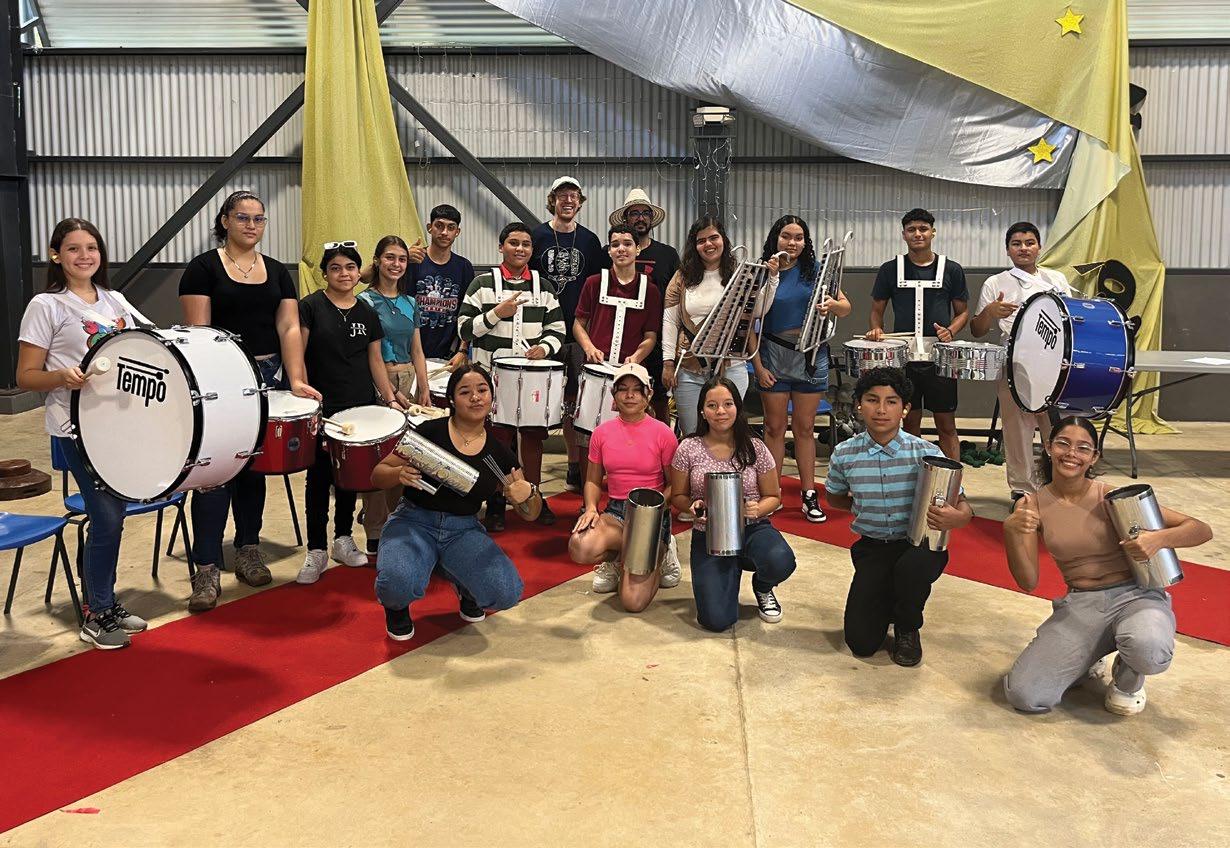VOLUME I | 2025
MAKING MUSIC GFS BULLETIN
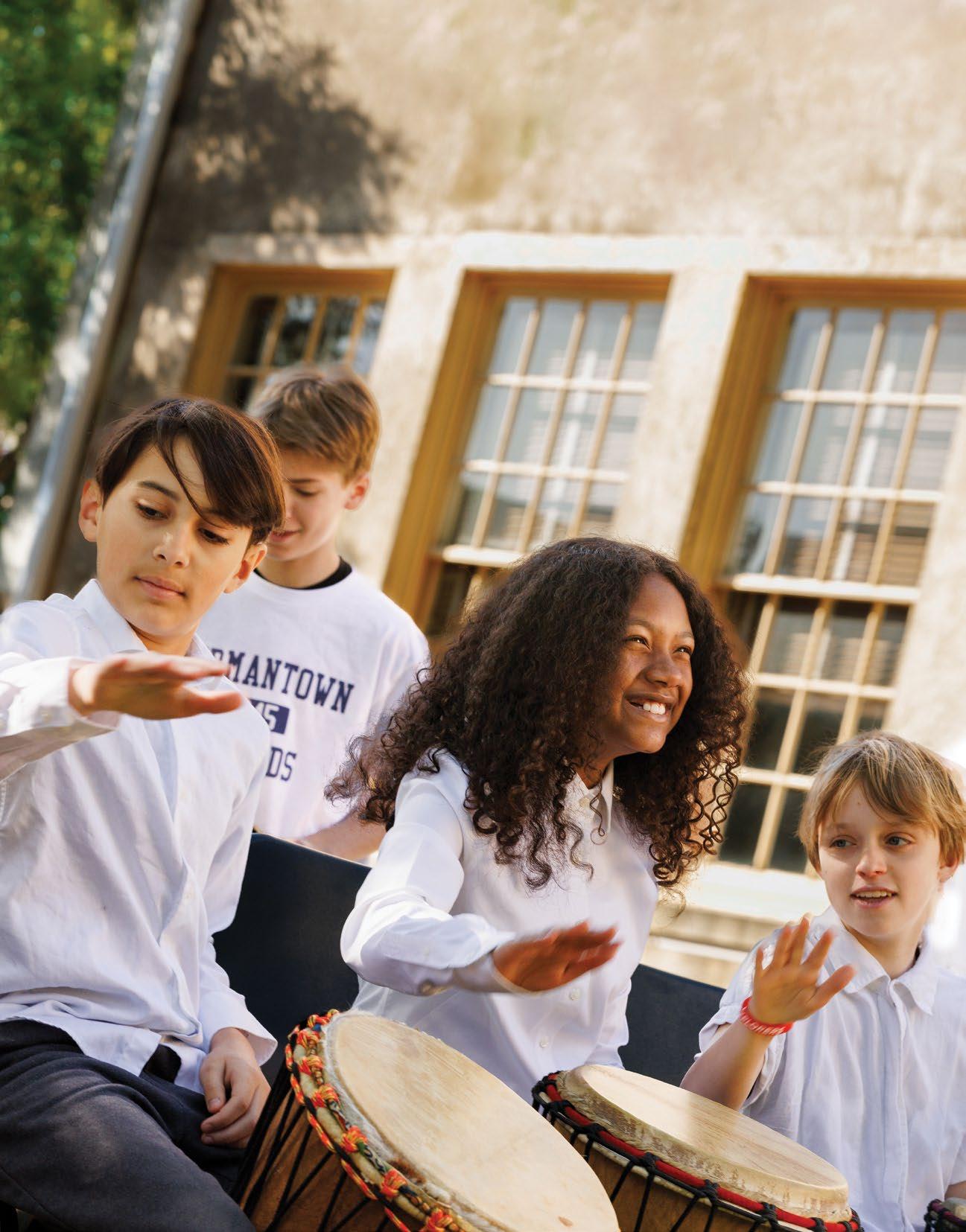
INSIDE
Choir Trip to Estonia
The GFS Fac/Staff Mixtape Alumni in Music and more!
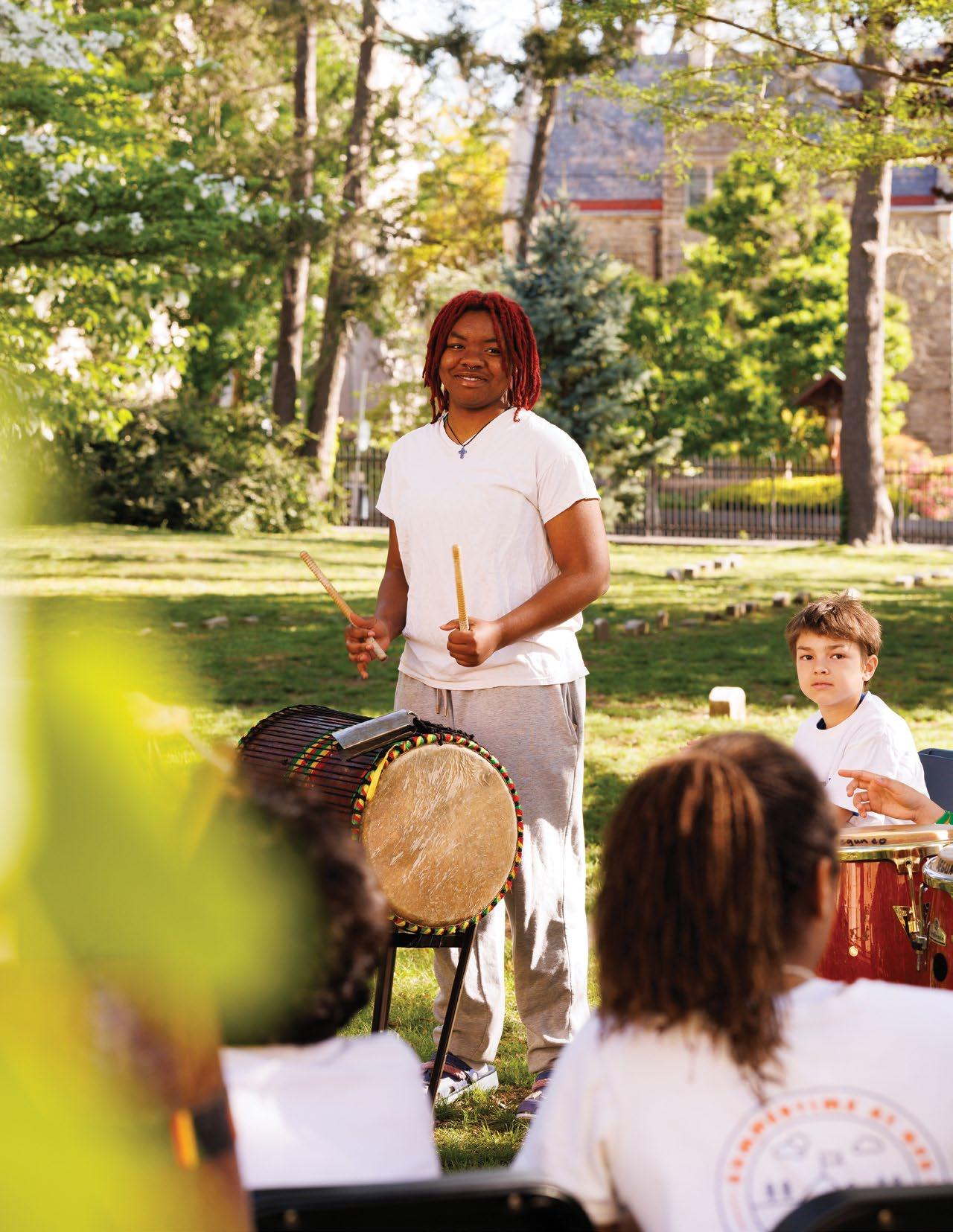
MIDDLE SCHOOL WORLD PERCUSSION gives students the opportunity to play drums and rhythms from around the world, build community, and simultaneously strengthen their internal and communal sense of musical timing.
In a “Mixed World” format, the class uses authentic drums from Central and South America, Africa, the Caribbean, and the Mediterranean, learning regional techniques, styles, and social contexts. Led by teacher Shawn Hennessey ’98, students explore popular rhythms like Samba, Bomba, Ijexá, Rumba, Beledi, and Soli. They also learn the basics of the South Indian rhythmic system, including vocables and keeping tala (time). There are performance opportunities throughout the year, including collaboration with Lower and Upper School World Percussion ensembles.
Gabriah Dowdell ’29 (pictured above) joined Middle School World Percussion in 2024, her first year at GFS. She didn’t have a lot of prior musical experience, and has deeply enjoyed learning different drumming techniques and the feeling of playing music with other students.
“When we’re all locked in the beat together, it feels really good and powerful,” she said.
IN THIS ISSUE
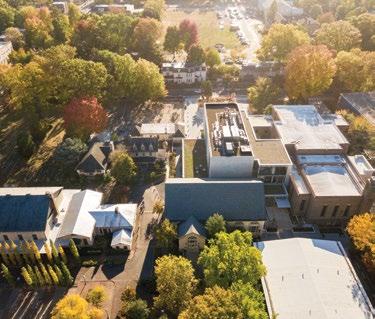

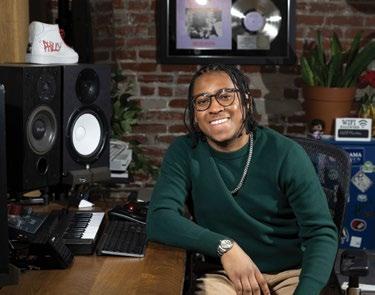
GFS Reaches Major Milestone in the Picture This Campaign
The school’s largest-ever comprehensive campaign anticipates running through June 30, 2026—learn how we’re doing, and how to help us rally to the finish line.
Wired for Sound
Music theory, art, design, and woodshop intersect in the popular Upper School class, “Instrument Building.”
Extended Play
Eight GFS alumni are blazing their own trails through different facets of the music industry.
ON THE COVER
L to R: Adrian Migliori ’31, James Greenwood ’31, Sofia Robinson ’30, and Jack Klein ’30 practice with the Middle School World Percussion ensemble on a spring morning.
EDITOR
Emily Kovach
DIRECTOR OF COMMUNICATIONS
Eryn Jelesiewicz
CONTRIBUTORS
Kyle Bagenstose
Barbara Barnett, design
Chris Coyle
Lilly Dupuis ’17, photography
Kelly Edwards, design
Anne Hess
Eryn Jelesiewicz
Emily Kovach
Charlie Myran ’14
Miku Shiota
Carl Tannenbaum
Renee Warnick
Timothy Wood, GFS Archivist
HEAD OF SCHOOL
Dana Weeks
CHIEF ADVANCEMENT OFFICER
Hannah Caldwell Henderson ’91
SCHOOL COMMITTEE (2024–25)
Maureen Carr, Clerk, Religious Life
Hardin L.K. Coleman ’71
Joan Cannady Countryman ’58
Ben Cushman ’72, Nominating and Governance Committee Co-Clerk
Marc DiNardo ’80, Recording Clerk
Moira Clare Duggan
David Feldman ’76, Clerk
Carmen E. Guerra
David Loder ’72
Takashi Moriuchi, Treasurer and Finance Committee Clerk
Zoë Samuel Rankin ’06
Dianne E. Reed
Anne B.K. Stassen
Matthew Stitt ’05
Anthony Stover
Elizabeth A.W. Williams, Assistant Clerk, Nominating and Governance Committee Co-Clerk
TRUSTEES EMERITI
Pat Macpherson
Christopher Nicholson*
Samuel V. Rhoads ’82
Pat Rose
F. Parvin Sharpless
David A. West ’49*
*deceased
The GFS Bulletin is published for the alumni, parents, faculty, and friends of Germantown Friends School. We welcome your comments to the editor at: ekovach@germantownfriends.org
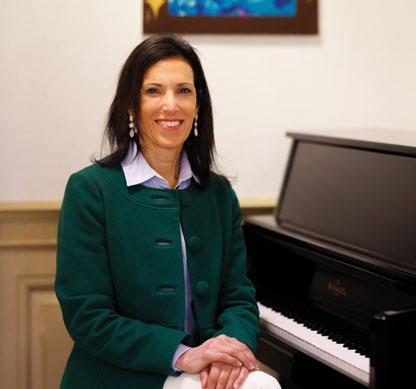
Dear Friends,
Just outside my office in the Front Hall sits a lovely old piano. It gets a lot of use; a parent might play a few bars while waiting for their child, faculty can be found playing a tune between classes, and students take time out of their busy days to play their current favorites. The other day, I heard someone on the piano whose music was sophisticated enough that I assumed it was one of our music teachers.
In fact it was two sophomores, a group of their friends seated around them, eating lunch and chatting, with the duo’s upbeat melodies providing a joyful backdrop.
Music—in its many forms—has the enduring ability to turn up the wattage on everyone’s Inner Light. A walk through campus on any given day is likely to yield multiple musical encounters: young students experimenting with syncopation; ensembles working through challenging phrasing; choir skipping through solfège warmups; a composition class analyzing their latest digital creation. Our students lift their voices in assemblies and plays, fill the theatre with orchestral magic at concerts, and share their own creations at talent shows and open mics.
Wherever you find music at GFS, you also find creativity, community, and joy. And, like many art modalities, music can be positioned as a lens through which to examine historical, mathematical, scientific, and numerous other concepts. In the
hands of our skilled teachers, music becomes both a creative expression and a constructive tool that deepens teaching and learning.
That’s what this issue is all about: the ways in which music is foundational to our school’s identity, pedagogy, and community—on campus and beyond. From the Upper School Choir’s recent trip to Estonia (pg. 4), to our talented alumni working all across the music industry (pg. 36), to the new documentary about GFS A Cappella Fest (pg. 28), there’s a dynamic trove of stories to explore.
As you read the pages that follow, I hope you are reminded of your own relationship to music—as a maker, perhaps, or an enthusiast—and how it can so powerfully connect you with the world around you.
Warmly,

Dana Weeks Head of School
NEWS & NOTEWORTHY
WHAT’S HAPPENING AT 31 W. COULTER STREET—AND BEYOND
GFS Welcomed Kristen Welker ’94 of NBC’s ‘Meet the Press’ to the Christopher Allen ’09 Lecture
ON THURSDAY, FEBRUARY 20, KRISTEN WELKER ’94 VISITED GERMANTOWN FRIENDS SCHOOL AS THE FEATURED SPEAKER OF THE CHRISTOPHER ALLEN ’ 09 LECTURE.
Before a packed house in the Taulane Auditorium in the Barbara & David Loeb Performing Arts Center, Welker was joined by her longtime mentor, Chris Blackman. Blackman is the Director of Career Services at Temple University’s Klein College of Media and Communication, and a former NBC News executive who hired Welker to the network.
Welker opened with a heartfelt tribute to Christopher Allen, a GFS alumnus and freelance journalist who was killed in 2017 covering the conflict in South Sudan. This lecture series was established by John Allen and Joyce Krajian, Chris’ parents, in his memory.
“Chris represented what journalism is about: democracy, freedom of the press, and freedom of speech,” she said. “It’s humbling how brave he was.”
Blackman and Welker focused their candid discussion on her career trajectory and the role of journalism in society.
“A job like this is a front row seat to history. It’s a heavy responsibility, asking questions on behalf of the American people,” Welker noted.
Welker spoke warmly of her memories of GFS (“one of the most special
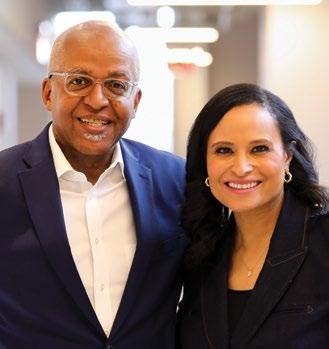
places on Earth”) and her supportive GFS teachers, and urged students to stay connected with mentors throughout their lives.
A few of Welker’s former teachers were in the audience, including Anne Gerbner, a now-retired English teacher and department head, who taught Welker in eleventh grade.
“I’ve been following Kristen’s career for years, and it was great seeing her back at GFS—she seemed right at home!” said Gerbner. “I taught Chris too, and was so glad to hear her honoring his work reporting from the front lines. I also loved that she encouraged GFS students to keep writing.”
To close the lecture, students posed thoughtful questions to Welker, such as: How did you prepare for your
interview with President Trump after he won the 2024 election?
“By working on it every minute of every day: doing extensive research, sharpening the questions, and doing mock interviews,” she replied.
Della Micah, former GFS teacher, administrator, and faculty representative to the School Committee, was also in attendance. She has fond memories of Welker from her school days, particularly her persistence and tenacity.
“One of the things that really impressed me about the lecture was how Kristen took the students’ questions so seriously,” Micah said. “And she kept them engaged by drawing clear connections to how she’s carried the lessons she learned at GFS throughout her life.”
Later, Welker and Blackman met with the current cohort of the André Robert Lee ’89 Fellows and the staff of GFS’ student-run magazine, Earthquake. In those meetings, Welker emphasized including many different perspectives in journalistic storytelling.
“It’s important for any news program to make sure that there are people who are represented from different socioeconomic backgrounds, different racial backgrounds,” she said. “A lot of times that happens organically, but it’s important to pay attention to that.” Emily Kovach
GFS Choir Travelogue: 10 Days in Estonia
OVER THE 2025 SPRING BREAK, THE GFS CHOIR AND FACULTY CHAPERONES EMBARKED ON A 10-DAY PERFORMANCE TOUR OF ESTONIA. The 43-person group visited four cities—Haapsalu, Viljandi, Tartu, and Tallinn, the capital—performed in multiple concerts; attended clinics with peer ensembles and local conductors; and visited castles, museums, and festival grounds.
The GFS Choir travels every three years; this Upper School tradition dates back to 1956, when choir director Mary Brewer accompanied the choir on a singing tour across France, Germany, England, Wales, and Ireland. In the decades since, the GFS Choir has visited nations around the globe, including Romania, Sweden, Canada, China, and many others.
AN ABBREVIATED ACCOUNT OF THE TOUR, AS SHARED BY HESS:
Why Estonia? Anne Hess, Director of Upper School Choir and Chorus, chose this tiny Northern European country because choral music is woven into the fabric of its history and culture—in a nation of 1.37 million people, there are more than 700 official choirs. During the country’s quest for independence in the 1980s, choral tradition provided the backbone of the resistance. A number of GFS’ choir members learned about Estonia’s “Singing Revolution” in eighth grade, and they further prepared by learning Estonian songs, which they performed at a pre-tour send-off concert at GFS, and across their travels.
E.K. & Anne Hess
Photos courtesy of the GFS faculty chaperones
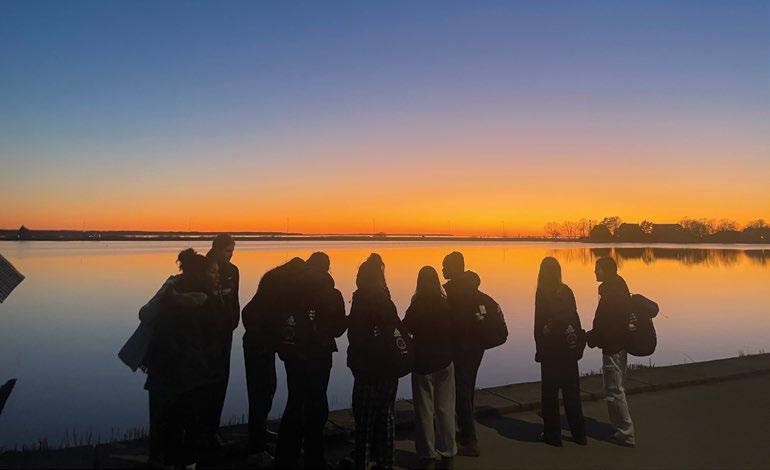
DAY 2: We had a hard time winding down from the big, celebratory energy of tonight’s concert in Kärdla Church, a lovely space with resonant acoustics for singing. The choir was deeply com- mitted to each performance, and gained so much from the positive connection with the Estonian audience, which was effusive in its applause and appreciation!
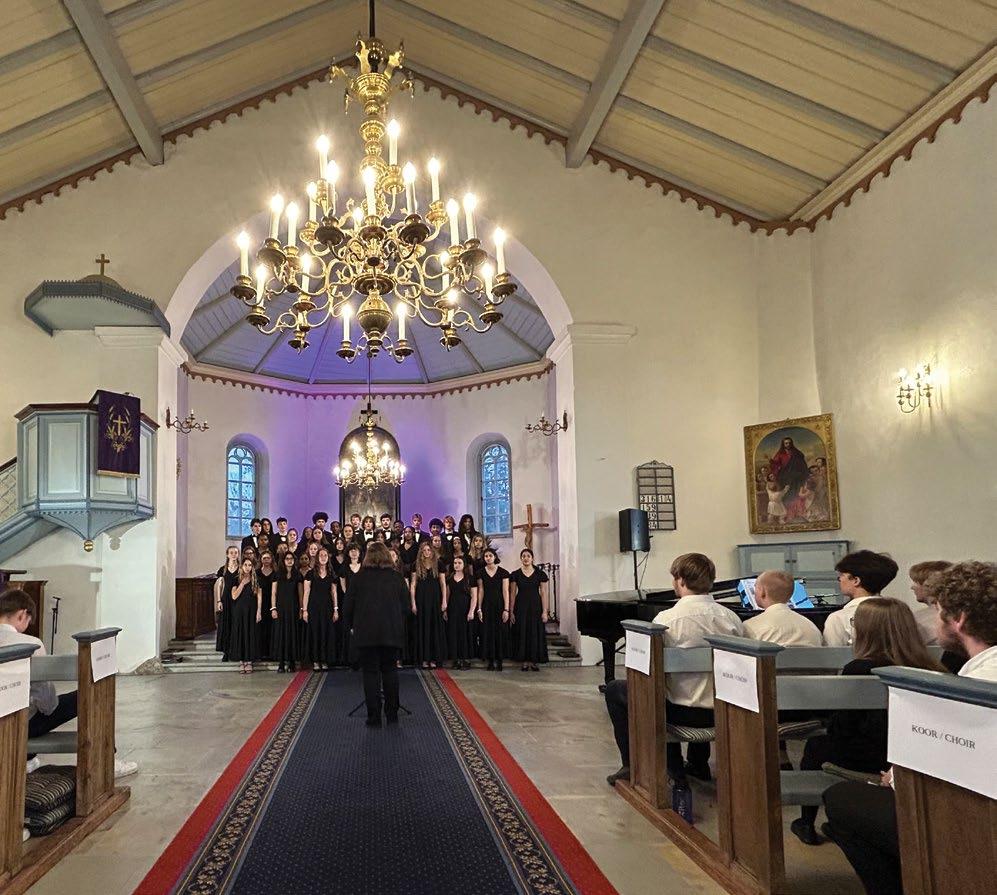

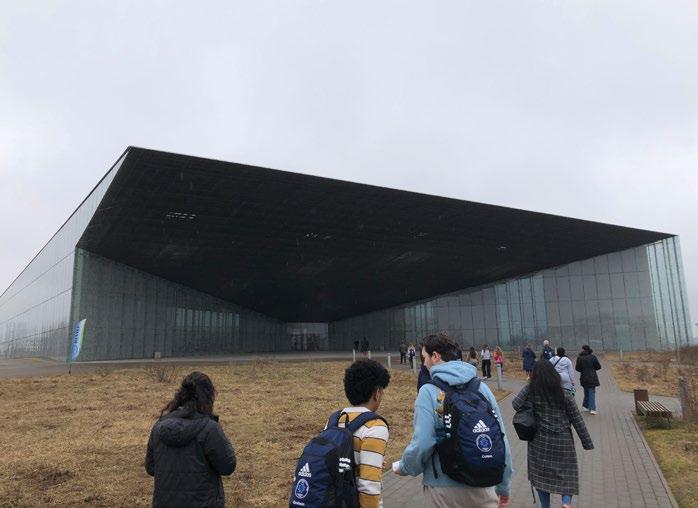
DAY 5: As of this evening, we have visited three towns and sung three concerts. A highlight was performing with students from the local high school in the Viljandi Gümnaasiumi Youth Choir in the Viljandi Baptist Church. Tomorrow, we head to the capital city of Tallinn. The sites we’ve visited are both ancient and modern, like the ruins of the 13th-century Viljandi Castle contrasted with the very modern Estonian National Museum in Tartu.

GFS Faculty chaperones (L to R): Laura Sharpless Myran ’78, Brian Bersh, Miku Shiota, Allen Drew, Anne Hess, Carly DeCock, and Tom Myran.
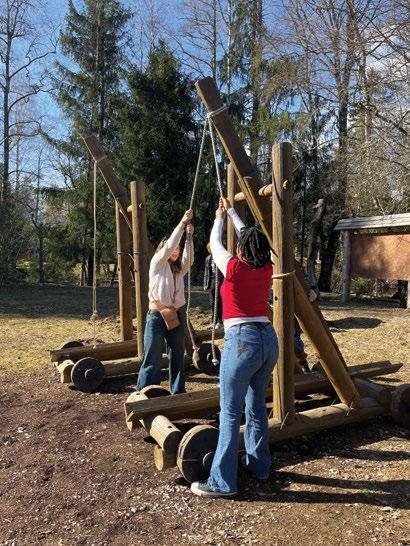
DAY 6: Today, we experienced the adventurous life of Estonian Vikings at the Viking Village theme park, then traveled to Tallinn, where we will be for the remainder of the tour. Everyone had some nice free time this afternoon at the hotel, and many took advantage of the spa and sauna culture that is hugely popular here.

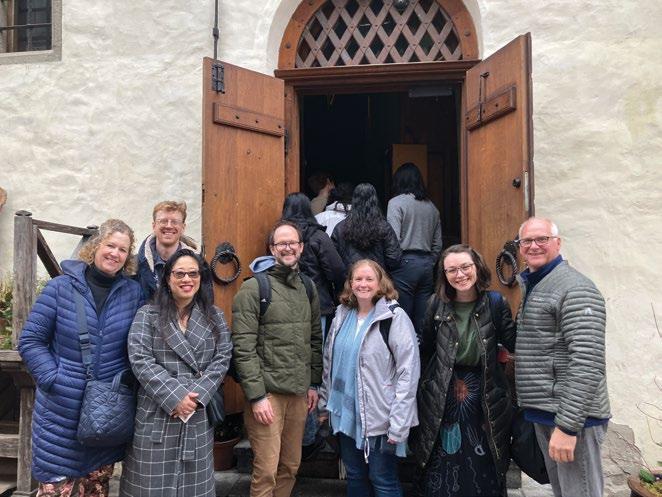
DAY 7: We started our day off with a 90-minute workshop led by an esteemed Estonian choral director, Külli Kiivet. She brought a lot of energy and a fresh perspective to our music-making!
We also visited the VABAMU, the Museum of Occupations and Freedom. Its permanent exhibition, “Freedom Without Borders,” tells the story of occupation, resistance, and recovery in Estonia since World War II.

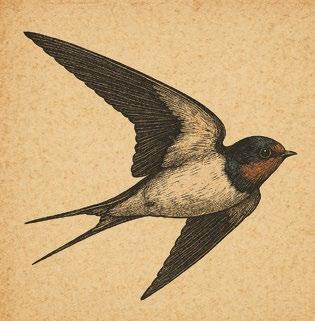
DAY 8: This morning began with glorious weather and a trip to the Tallinn Song Festival Grounds (the Lauluväljak) on which the Estonian song festival, Laulupidu, is held every five years. The next one is this July! Just for fun, we sang the “Benediction” on the massive stage—it is amazing how the carefully crafted acoustics amplify outdoor singing. It’s a true feat of design and engineering.
The kids have been passing out concert flyers and inviting so many people to our concert. That, plus the incredible organization and connections of our favorite Estonian organist and amazing guide, Ulla, yielded an audience a few hundred strong for our final concert.
DAY 9: It’s been a wonderful journey, and the last night of the tour has arrived. Today began with a visit to the Arvo Pärt Center. Pärt is Estonia’s most famous composer and it’s a big year for him, as he is turning 90. We were fortunate enough to sing one of his pieces in the performance hall there. Some brave souls climbed to the top of the observation tower for a view of the forest and the Baltic Sea.
We had our farewell dinner at the Old Hansa, a medieval restaurant in the Old City that serves authentic cuisine cooked using 15th-century recipes and methods. There was also traditional medieval music and a lot of celebratory singing on our part. Tomorrow, we head home!
SOUVENIRS
Performing with the Viljandi Gümnaasiumi Youth Choir
Singing on the Tallinn Song Festival Grounds stage
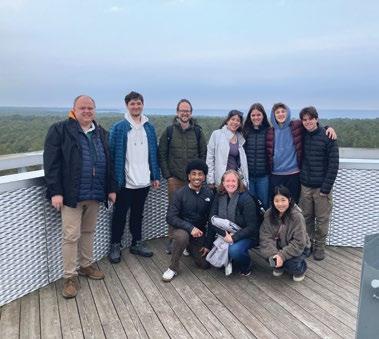
Digital program Workshop with Külli Kiivet
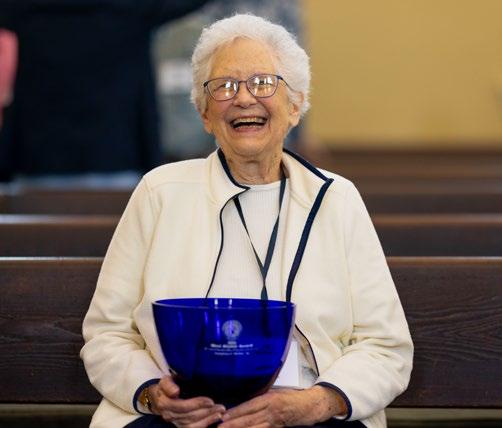
IN A TOUCHING CEREMONY IN THE MEETINGHOUSE DURING ALUMNI WEEKEND, JOSEPHINE (JO) WALKER ’55 WAS CHEERED ON BY CLASSMATES, FRIENDS, AND FELLOW ALUMNI AS SHE ACCEPTED THE SUSAN QUILLEN WEST ’49 AND DAVID A. WEST ’49 ALUMNI AWARD.
The West Alumni Award recognizes GFS alumni who have demonstrated extraordinary commitment,
Jo Walker ’55 Presented with the 2025 West Alumni Award
dedication, and service to the school. This award was established in May 1999 by David and Susan’s children to honor them on the occasion of their 50th reunion.
Walker attended GFS from first through twelfth grade, with the exception of a gap during second grade while she was hospitalized with polio. She remembers GFS as an “inclusive, accepting community,” that “saved my
‘Going to Meeting for Worship’ Book is Out Now
HOW DOES ONE TEACH YOUNG CHILDREN ABOUT THE GOALS, PURPOSE, AND NORMS AROUND THE QUAKER PRACTICE OF MEETING FOR WORSHIP?
This is the question that sparked a new children’s book, “Going to Meeting for Worship,” which was created under the auspices of GFS’ Early Childhood Quakerism Committee.
The project started in 2022, when the Committee was examining ways to improve the division’s Quaker curriculum. This led to a discussion of developing new resources to help young children understand Meeting for Worship. The Committee submitted a grant application through the Friends Council on Education for the authorship of a book about this topic.
The grant was awarded, and the EC Quakerism Committee began work during the summer of 2022. They collaborated with Liliane Sharpless ’04, GFS Early Childhood/Lower School art teacher and member of the Germantown Monthly Meeting, on the text. Sharpless created all of the scenes, many of which incorporated handmade dollhouse-style furniture and decor in miniature classrooms, and took all of the photographs in the book.
life.” She’s given back to the school by volunteering her time and through loyal annual giving. She’s kept her class connected for decades as a class agent and reunion organizer. Most recently, she helped organize the Class of 1955’s 70th reunion, which was held at Foulkeways at Gwynedd, where she now resides. E.K.
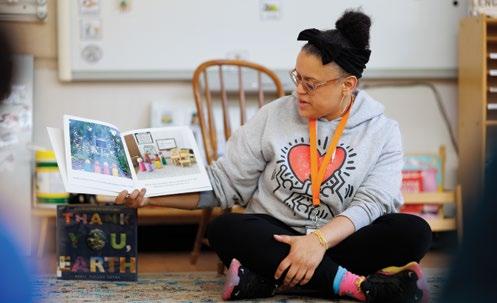
From the fall of 2022 to the spring of 2023, the EC Quakerism Committee worked together to edit the copy. The committee began looking into self-publishing during the summer of 2023, and a small first run was launched in the fall of that year. A second, larger run of the hardcover, full-color picture book was released this winter.
The new printing of “Going to Meeting for Worship” is dedicated to Marj Little, a Lower School librarian at Germantown Friends School (from 2007–2020) who died of ovarian cancer in 2022. Little was extremely dedicated to Quakerism at Germantown Friends School. Her love of reading was both voracious and contagious, and she was always encouraging students to dive into books.
Copies of “Going to Meeting for Worship” are now available for sale in The Open Door Cafe on the GFS campus. E.K.
Together We Run
How a culture of teamwork and team mentality has been cultivated throughout the decades in GFS track and field and cross country by Carl Tannenbaum
IN THE CLASSIC 1962 FILM, “THE LONELINESS OF THE LONG DISTANCE RUNNER,” THE PROTAGONIST COLIN SMITH LAMENTS, “ALL I KNOW IS THAT YOU’VE GOT TO RUN, RUNNING WITHOUT KNOWING WHY, THROUGH THE FIELDS AND WOODS. And the winning post’s no end, even though the barmy crowds might be cheering themselves daft. That’s what the loneliness of a long distance runner feels like.”
Running can be an isolating endeavor, and with no passing (other than an occasional baton), no setting of picks, and no sacrifice bunts, generating a team ethos can be a challenge. But at Germantown Friends School, generations of coaches have strived to make track and field and cross country sports where individual athletes work for the common good of the team. The legacy of GFS running coaches is unifying and bonding runners at the school, cultivating a culture of “we” in a sport more associated with “me.” And the results have been successful: 47 cross country championships and 39 track and field championships for the boys and girls programs combined.
ONE FOR ALL
The list of memorable track and field and cross country coach-mentors who have helped to embed the team ethos at GFS is long and spans decades: A.A. Smith, Lou Paulmier, Dan Shechtman, Tom Myran, Bob Baxter, Daryl McKeever ’78, Rob Hewitt, Conrad Haber, and many others in between.
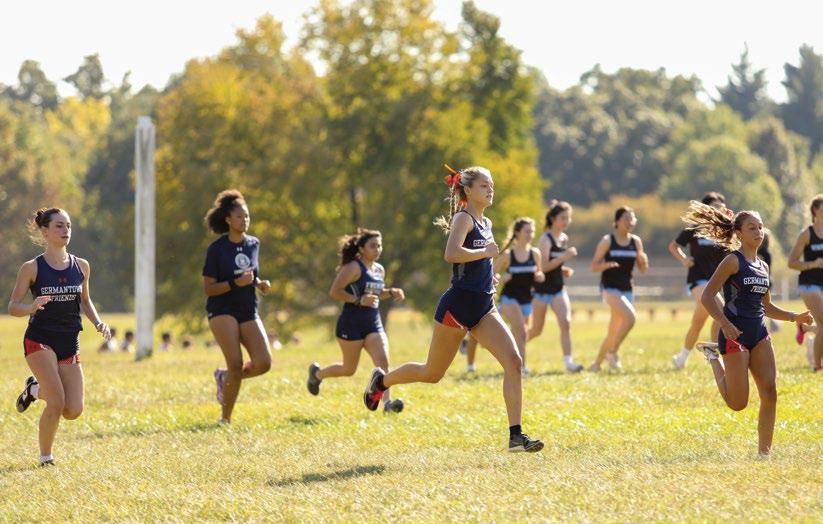
There have also been a number of championship-caliber athletes on the coaching staff who have set the bar high and taught by example: Edwin Roberts and Benedict Cayenne (Olympic athletes from Trinidad and Tobago), Jim Burnett (1/10 of a second shy of making the semifinals in the 400m at the 1968 U.S. Olympic trials), Latavia Thomas (three-time 400/800m NCAA champion), and Maalik Reynolds (Penn Relays high jump champion), to name a few.
“Olympians dissect the sport in very simple ways. They also teach the sport in that same simple manner,” McKeever said. “I was thoroughly prepared for my encounters with coaches of that caliber on the next level. And this undoubtedly influenced my coaching and teaching style.”
But perhaps more impactful than the coaches’ technical expertise has been their collective ability to create a strong team mentality. Though each coach has brought their own style to GFS, the team-first attitude is always at the center. McKeever
Daryl McKeever has a unique perspective on GFS’ running programs, as both a student-athlete and later, a coach. After graduating from GFS in 1978, he went on to run at Rutgers University, and then returned to coach the GFS girls cross country and track and field teams from 1987–2003. His coaching style was particularly formed by his experiences being coached by Roberts and Cayenne when he was a student runner.
This page: Girls cross country at Belmont Plateau; Opposite page, clockwise from upper left: 1901 Penn Relays championship team (back row, L to R): Ellwood Shields, George Barrie, A.G. Priestman; (front row) Robert Brinker. This circular trophy still hangs in the Main Building; 2004 Penn Relays PA Prep Schools 4x400 Champions (L to R): Coach Daryl McKeever ’78, Madeleine Davis-Hayes ’05, Syreeta Lockett ’04, Sabrina Sampson-Knapp ’04, Glenda Smiley ’05; 2008 Penn Relays Championship of America Distance Medley Relay (L to R): Jake McKenzie ’08, Isaac Ortiz ’08, Tom Waterman ’10, Max Kaulbach ’08.
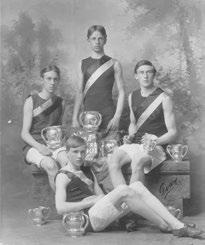
1901
Penn Relays mile relay heat championship 1922
First track at current location of Fields (surrounding what is now the A.A. Smith soccer field)
First boys FSL cross country championship 1987
First girls FSL track and field championship
2025
GFS hosts first Indoor Track FSL Invitational at the Ott Center
First boys FSL track and field championship
First girls FSL cross country championship
First full boys track and field team and schedule 1960
Running track relocated to current location & first boys cross country team
Inaugural GFS Middle School Cross Country Invitational
First girls cross country team
First year of indoor track and field 2003
Penn Relays boys 4 x 400m wins PA Prep School Heat
2021
Nike XC Regional Girls Champion
explained that the foundation of this leadership mentality starts with valuing loyalty and commitment as highly as physical prowess.
“[As coaches] we focus on culturebuilding where hard work and time investment mean more than your ability to run fast and jump high,” McKeever noted. “A young athlete has to prove her commitment to the team by practicing hard and competing even harder. ‘Competing harder’ doesn’t necessarily mean you win; it means you are willing to give everything you have for the sake of the team.”
2010/15
PAISAA track and field State Champions: boys (2010), girls (2015)
2009
Boys cross country competes in Nike National Championship
CAMARADERIE IN ACTION
In the fall of 1980, senior Susan Steinberg was the only girl on the cross country team (coached by the legendary and influential Dan Shechtman). There was not yet a girls team as this was still a year before the start of the Friends Schools League. The team competed in the Penn-Jersey league of which the Academy of the New Church in Bryn Athyn was also a member. The Academy is governed by the rules of the Swedenborgian Church, which mandates there is to be no competition between members
First girls track and field team
1971
First girls on the cross country team
1973
First girls 440 relay team 1978
2004
Penn Relays girls 4x400 heat championship
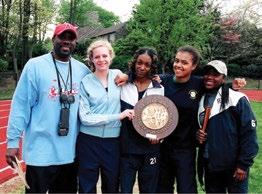
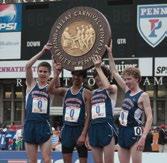
2008
Penn Relays boys distance medley relay Championship of America
of the opposite sex. The only way the two teams could run against each other was if Steinberg did not run. She agreed to this option to allow her teammates to compete, but the boys on the team said no. They considered themselves a real team, not just a group of individual runners, and they decided that if Susan couldn’t run neither would they. And so the meet did not take place.
In the fall of 2007, the boys cross country team was exceptional. Guided by coach Rob Hewitt’s intense-but-steady leadership, they were ranked first in Pennsylvania,
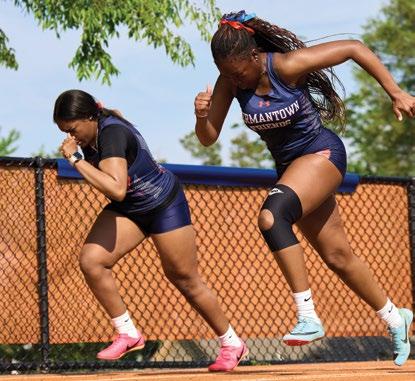
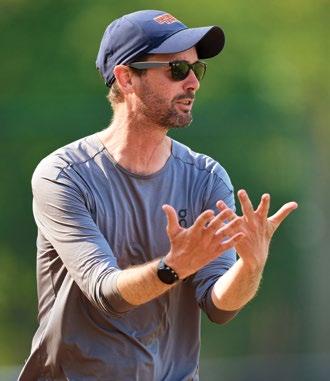
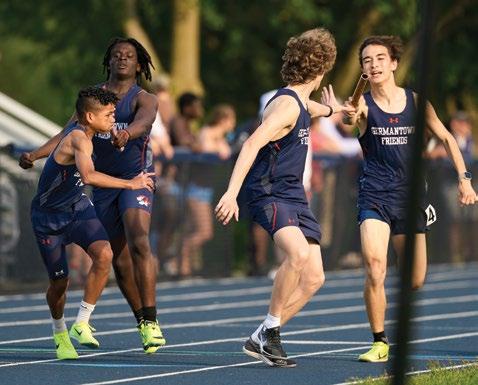
third in the Northeast region, and tenth in the nation. There were some strong personalities, yet, thanks to Hewitt’s careful guidance, they bonded as a team. Like any team with championship aspirations, they trained hard all week, even on Sundays. But the Sunday morning workouts were at the same time as First Day Meeting which upset some members of the Germantown Monthly Meeting. So after their Sunday morning workout they did their cooldown in a unique way. They sat in a small circle and held their own Meeting for Worship. Even in silence, the team continued to bond.
A RUNNING START
Hewitt, a four-year letter winner in both cross country and track and field at Saint Joseph’s University, joined the coaching staff at GFS in 2004. For over a decade, he led the school’s teams to numerous victories, including the Paul Short Invitational at Lehigh University in 2007. In fact, his GFS cross country and track and field teams won 83% of the FSL championships they participated in. He left in 2017 to coach at Earlham College and Abington Friends School, and then made a welcome return to GFS in 2024.
As a seasoned coach, Hewitt cites an interesting team-building dynamic that he believes helps to mold successful runners.
“There is a push and pull: athletes in the middle range of ability are pushed by the athletes with less ability who are striving to do better.
They are all pulled by the stronger athletes who set an example with a faster pace or a longer or higher leap,” he observed.
Investing in team-building, as GFS running coaches have longprioritized, helps create the trust and vulnerability that allows this dynamic to emerge.
“Language I often use is: What is your role? How can you play that role well? ” Hewitt said. “Your role might be to win your section or achieve a personal record, or it could be you took a chance and it did or didn’t work out.”
When it comes to team bonding, Hewitt keeps it simple: the team runs together, and they run a lot. For example, this year, members of the track and field team went on a 50minute running tour of Manayunk, challenging each other up and down its famously steep hills.
“Shared work is the number-one thing that creates camaraderie—it’s really cool to work hard with someone on something and see it through,” he said. “When you’re out there with a teammate running hard, and you don’t want to let go because they’re not letting go, there’s no greater bond I’ve experienced in my life.”
Another aspect of a team’s success as a unit is the willingness of the athletes to train out of season— summer for the cross country teams and winter for the spring track athletes. The coach can set these expectations, but it is up to the athletes to make the commitment. Once that commitment is made, the stage is set for the coach to help the athletes reach the next level.
An interesting component of the success of the Tiger cross country and track and field programs is what Hewitt calls the “running families,” where older siblings set the example for younger brothers and sisters as to what level of commitment is necessary to keep the dynasties alive. The coaches’ jobs become easier when runners come into the program already instilled with a sense of how to be part of a successful team. In recent years, we have watched the torch pass among the Kaulbach, McKenzie, Walker, Waterman, Mactavish, Palus, Davis-Hayes, Baron, and Butler families, to name a few.
DREAM TEAM
Emi Wong Shing ’27 currently runs track for GFS. She joined the team when she came to the school in ninth grade, and ran on a competitive club team in middle school. Her track events include hurdles, triple jump, and sprinting; basically, “anything my coach needs of me.”
Wong Shing’s parents were also both runners in high school (her dad is Alphie Wong Shing ’96, an honorary GFS alumnus who attended from seventh to tenth grade), and while they’ve encouraged her at every turn, her love of running is all her own.
“I don’t even know what I’d be doing without track—it’s so important to me,” she said. “It enriches all other parts of my life: academics, friendships, everything.”
The team culture she’s encountered since coming to GFS is not typical of the sport, in her experience.
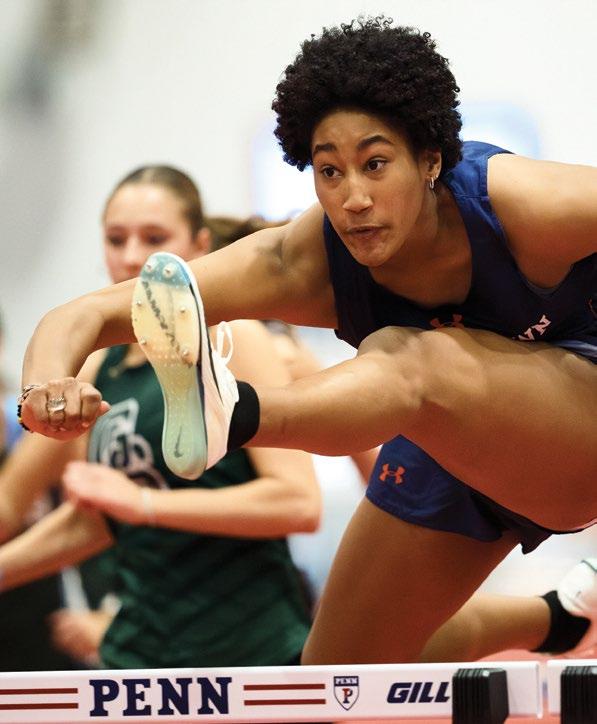
“At some schools, it’s more cut-throat, and people see even their own teammates as their competition,” she said. “Here, we feel so much like a team. I like when my teammates beat me because I want to support them.”
Wong Shing believes that part of this difference is owed to the strong Quaker philosophy that infuses so much of GFS’ culture.
“We actually practice the Quaker values in the way our community works, and that is transferred into sports,” she observed. “The people who do sports here really depend on each other and are kind to each other, and that makes us closer.”
She also credits Hewitt’s guidance as a coach, and values the intensity and commitment he brings to running sports.
“His best interest for the team is in mind all the time. He asks students to apply themselves, sets high standards for us, and is a really good coach, mechanically. When you listen to him, it helps you so much.”
About the author: Carl Tannenbaum taught math, coached soccer, baseball, and tennis, was Boys Athletic Director, and was a co-founder of the Friends Schools League during his 40-year GFS career. He is currently writing a history of Athletics at GFS.
Opposite page, L to R: Selena Wallace ’26 and Lailah Banks ’26; coach Rob Hewitt; boys relay runners Caleb Ng ’25, Hezekiah Peterkin ’27, Dylan Rix ’25, and Sam Kelly ’26.
This page: Emi Wong Shing ’27.
GOING THE EXTRA MILE
It takes a unique set of skills to motivate and inspire student-athletes, build teams, and find the sweet spot where empathy, encouragement, and intensity overlap. Longtime track and field and basketball coach Tom Myran (pictured, right) credits a number of mentors with his own growth:
“As a young and aspiring coach, I had the opportunity to learn what it meant to be both a head coach and educator from incredible mentors like Harry Gratwick, Carl Tannenbaum, Dan Shechtman, Della Micah, Pam Lutz, Linda McConnell, Daryl McKeever, and Bob Baxter,” he said. “At GFS, being a committed coach, building relationships with athletes, and winning isn’t just an expectation—it’s the norm.”
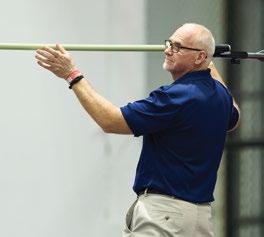
1 2
Myran shares five key principles that inform his approach to shaping athletes who believe in themselves, push past their limits, and find joy in the pursuit of excellence.
BUILDING RELATIONSHIPS: I spend a lot of time with my athletes and genuinely care about their journeys: who they are, and who they will become, not just as athletes but as people. Forming a relationship that is not just about their performance creates the foundation for success. This bond is why I coach.
CELEBRATING THE JOURNEY OVER THE DESTINATION: Everyone loves winning. But over time, my focus shifted to become less about my own coaching success and more about putting athletes in a position to succeed. At the end of the season, we celebrate, whether we win a championship or not.
3
4 5
EXPRESSING JOY IN COACHING: I love what I do, and I want my athletes to know it. Enthusiasm is contagious, and when athletes see that I’m excited to be there with them, it fosters an environment where they’re excited to show up and put in the work.
SHARING A VISION FOR SUCCESS: As a coach, it’s essential to have a vision—not just for the team but for each individual athlete. GFS student-athletes will rise to the occasion and meet the expectations you set for them. Rob Hewitt, my friend and coaching partner, does this better than anyone. He can see an athlete’s or team’s potential long before they can.
EMPOWERING ATHLETES TO SET THEIR OWN GOALS: Athletes should have the opportunity to articulate their own goals and vision for success. What do they want to achieve? What will it take to get there? Is it possible? When they start thinking about their success in a matter-of-fact way, it becomes tangible.
Jumping Mental Hurdles
Within GFS Athletics, mental performance coach Colleen Finegan is leading a charge to give student athletes a mental edge by Kyle Bagenstose
OVERCOMING A SLUMP
Last fall, Adrian Dussler ’27, the goalie on Germantown Friends School’s Boys Varsity soccer team, hit a rough patch in his play. He wasn’t making saves he knew he could. He was losing minutes on the field.
Dussler is a skilled goalie. He’d been playing soccer since lower school, and plays both for GFS and at the club level; he’s traveled as far as Florida and California to compete in high-level tournaments.
As he struggled through the season, frustration was building. That’s when he called Coach Colleen.
“I wasn’t playing as well as I wanted to, and I wanted to talk that through with her,” Dussler recalled.
“Coach Colleen” is Colleen Kelly Finegan, MS, M.Ed., a former University of Pennsylvania basketball player who holds a master’s degree in Positive Coaching and Athletic Leadership. For the past three years, she’s worked at Germantown Friends as a mental performance coach. Brought on board by Athletics Director Katie Bergstrom Mark, Finegan is at the center of the school’s commitment to support the mental wellbeing and competitive preparation of all GFS student-athletes.
In Dussler’s case, he first encountered Finegan during an introductory meeting with the soccer team where she spoke about the importance of the “environment and energy” within athletic programs and explained how she could help. During his time of struggling on the field, Dussler identified Finegan as a resource and began meeting with her, one-on-one.
What started with simple conversations about Dussler’s discouraged feelings quickly turned instructive. Instead of mentally ruminating on
negative emotions after a game, Finegan urged Dussler to write in a journal. When he reported having trouble falling asleep, she taught him body scan meditations to help him relax. Together, they worked on goalsetting and focusing on the things he can control—practicing, eating right, establishing pregame routines—to guide him back on track.
“All of this helped me feel mentally prepared, to know what I have to do in-game, and also to know that I physically treated my body well,” Dussler said, adding that he eventually moved past his slump and regained a starting spot on his club team.
PROGRESS AND POSITIVITY
Finegan knows firsthand how important—and sometimes overlooked— mental wellbeing is in athletics. A lifetime multisport athlete, she excelled most in basketball, becoming the alltime leading scorer at Merion Mercy Academy in Narberth before playing at the Division I level at UPenn. But there, her star faded. She didn’t mesh well with the program, and without the mental skills to handle adversity, grew isolated. She finished her four years but fell out of love with the game and needed a long break afterward.
Years later, it was her own daughters who pulled her back in. As they began to play on youth basketball teams, she wanted to ensure they had more positive experiences with the sport and began coaching them.
“The way I was coached—the punitive, yelling approach—kids do not respond to that anymore,” Finegan said. “I changed my whole focus to positive coaching.”
In turn, she received positive feedback from team parents. She
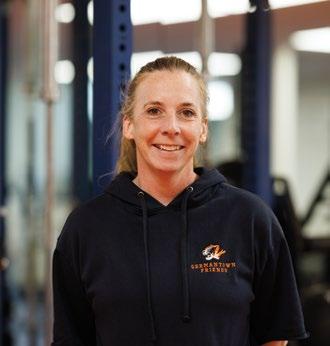
Colleen Finegan, MS, M.Ed, GFS Athletics’ mental performance coach, takes a multi-faceted approach to mental wellness with young athletes, focused on five modules: visualization, positive selftalk, goal-setting, gratitude, journaling, and mindfulness.
started sharing her techniques with coaches on other teams. Before long, she decided to turn it all into a second career. A speech language pathologist by training, Finegan enrolled at the University of Missouri to obtain a Master of Education in Counseling Psychology and started her own consulting company, the Positive Coaching and Leadership Group.
Around the same time, Bergstrom Mark observed some athletic coaches at GFS successfully instituting mental preparation techniques—such as breathing exercises or visualizations—on their own. But she wanted all athletes to have access to these tools.
“I realized that this wasn’t something that was consistently available across our 22 varsity programs,” Bergstrom Mark said. “So I began looking into how we could model this and make it more widespread.”
Bergstrom Mark began reallocating resources to emphasize mental training and coaching, such as holding department-wide training
sessions. Hiring Finegan was integral. She now leads training sessions for coaches and customizes her involvement with each team based on the needs of the program, in addition to working with students one-on-one. That can take the form of everything from a simple phone call or email to a family meeting.
“I’ve had parents sit in [on sessions with their child], or we’ll meet at a coffee shop, so they can carry over some of the techniques and language at home,” Finegan said.
Both Finegan and Bergstrom Mark are particularly excited about her work with the Middle School sports teams, where student-athletes are just beginning their careers. Learning mental
Sister Act
techniques can help them build a solid foundation for years to come.
And while mental skills training can have a positive effect on athletes’ selfesteem and wellbeing on the field, it also extends far beyond game day, with benefits like improved concentration and regulation of emotions showing up in other parts of life.
Sage Seltzer ’29 is a Middle School athlete who plays soccer and basketball, ran cross country in sixth and seventh grades, and pitches for the Upper School softball team. Last fall, Seltzer faced similar challenges as Dussler. In soccer, she was splitting time between the A and B teams, which she found dispiriting at first. But, after receiving Finegan’s lesson
Sibling bonds boost GFS Lacrosse by
THIS SEASON, TWO PAIRS OF SISTERS SUITED UP FOR THE TIGERS LACROSSE TEAM. Their strong connections— and a touch of sibling rivalry—bring a competitive, fierce edge to the program, and an enhanced feeling of connection across the team
Katie Day ’25 and Emmie Day ’26 are a problem for opponents all over the field.
Charlie Myran ’14
“She’s my best friend, and we’re so in sync,” said Emmie. “We just know where the other one is on the field.”
There’s a competitive nature to their relationship, too.
Katie, who’s played varsity soccer, basketball, and lacrosse alongside Emmie for the past three years, said: “It’s a good kind of competitiveness between us . . . We push each other, and it rubs off on the rest of the team.”
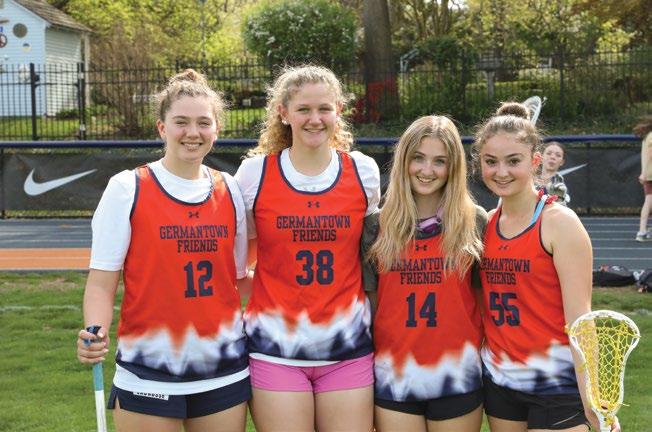
on focusing on what she can control, Seltzer worked on fostering a positive attitude and improving her skills. Eventually, she gained more minutes with the A team, and the following spring found her new skills helpful in pushing through training with the varsity softball team.
She also saw benefits outside of athletics, like taking a positive approach toward a difficult homework assignment or learning to control her emotions when having a disagreement with her younger brother.
“I definitely feel like focusing on things I can control has made me a more flexible person,” Seltzer said.
The seniorjunior duo won’t end their on-field connection when Katie graduates.
The Days have both committed to the University of Oregon to play Division I lacrosse, but for now, they’re still outmaneuvering Friends Schools League attackers and defenders
with an almost psychic connection.
Sharing the field is another sister duo: Halle Smoger ’25 and Isla Smoger ’27.
“Sometimes we argue,” Isla admitted. “But it’s because we care. She wants the best for me, and I want to show her I belong out there.”
Halle has had to learn the delicate art of being a leader—and an older sister—at the same time.
“I’m learning how to hold someone accountable and support them at the same time,” she said. “I’ve had to grow.”
Both sisters recognize how this sibling dynamic shapes the broader lacrosse team culture. “When you have siblings on a team, it feels more like a family,” Halle said. “That connection spreads to everyone.”
As the team continues its streak of victories, including winning the 2025 Friends Schools League Championship, those bonds—of sisterhood and teamhood—may be its strongest advantages. Whether it’s a tough practice or a title game, the girls on this lacrosse team don’t just play like teammates. They play like family.
New Fitness Center Opens in Old Cafeteria
THIS SPRING, A FULLY RENOVATED AND IMPRESSIVELY APPOINTED FITNESS CENTER OPENED IN THE LOWER LEVEL OF THE MAIN BUILDING.
The 4,000-square foot facility is the new home for GFS Strength & Conditioning, led by Physical Education teacher and Head Strength & Conditioning Coach, Matt Sheehan. The space is available to Middle and Upper School classes, fitness clubs, and Athletics teams, as well as faculty and staff.
The large, open space—where the old cafeteria once was!—features a slam wall, an open plyometric and core strengthening area, a cardio section with bikes and treadmills, and a fully accessorized Olympic lifting and free weights zone.
“We’ve put a lot of thought and intention into the design of the Fitness Center to make sure there’s plenty of room for functional training, like jumping, lunging, and core work,” said Katie Bergstrom Mark, Director of Athletics at GFS. “There’s also a focus on safety and orientation, so that our students can navigate gyms and weight rooms anywhere else they go.”
The space will provide opportunities for Athletics teams to build up their fitness and enhance bonding experiences.
“Strength training together is one of the most powerful ways to build team culture!” Bergstrom Mark said.
The Fitness Center also has short runways for track and field usage and
an additional multipurpose space for meetings and mental performance coaching sessions. Other amenities, like central air conditioning, state-ofthe-art flooring, and locker storage make it a comfortable, modern space for working out on campus.
Sheehan, who’s been at GFS since 2018, said one upgrade he’s particularly excited about is the equipment for students to practice pull-ups. Using weight-bearing bands, Sheehan implements a progressive method to make this challenging move accessible to anyone, regardless of existing upper body strength.
“Pull-ups are so good for building strength but so many people, including myself, struggle with them!” he noted. “We haven’t had access to a pull-up bar in two years, and I think it’s going to be a great resource for our students to work on these.”
With a new fitness environment, there’s an opportunity to re-emphasize respectful and inclusive community norms that students can carry with them into other fitness contexts.
“It’s not a place where people are throwing heavy weights down and yelling,” Sheehan said. “I encourage everyone in here to pick their heads up, look around, and notice who else is using the space. They are learning to be good stewards of the equipment and develop an awareness of the way all of our actions affect the energy in the Fitness Center.” —E.K.
Top to bottom: P.E. teacher and Head Strength & Conditioning Coach, Matt Sheehan, creates an inclusive environment in the GFS Fitness Center; Middle School students learn to use free weights in their P.E. class; the new pull-up bar set-up includes bands to assist students in achieving this challenging move; the state-of-the-art facility has plenty of space for cardio equipment, Olympic and free weights, plyometrics, and stretching/cooldown activities.
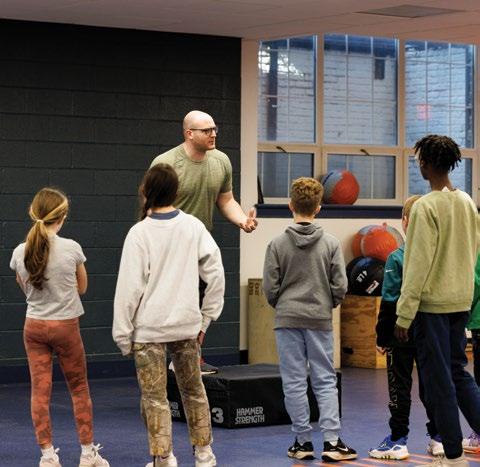
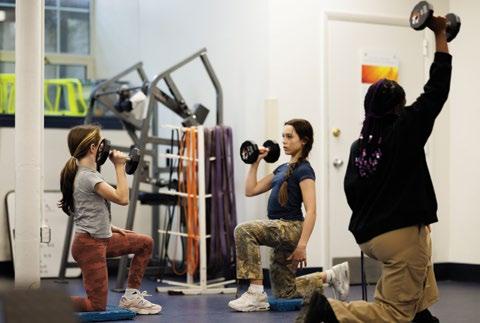
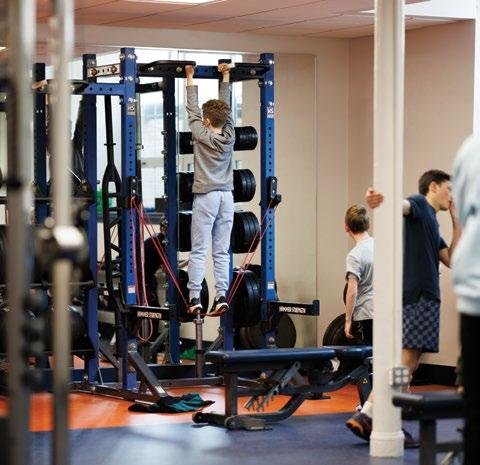
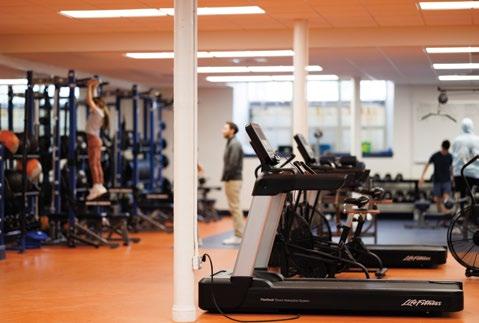
What’s in a Name?
Two longstanding GFS supporters named spaces in the All School Commons in honor and memory of esteemed friends and faculty from their school days. Learn more about what inspired these extraordinary gifts, and the significance behind the dedications.
STUDY LOUNGE IN MEMORY OF ALICE L. DAVENPORT AND IN HONOR OF FRANNIE SMITH
On the second floor of the Abigail R. Cohen Center for the Arts in the All School Commons, there is a low bench and tables and chairs along the hallway overlooking the courtyard below. During free periods, students gather there to catch up on homework and chat with friends. This is the Study Lounge in Memory of Alice L. Davenport and in Honor of Frannie Smith, named by Marc DiNardo ’80 and his wife, Elizabeth T. Drum, MD.
DiNardo is an ardent supporter of GFS and currently serves on the School Committee as Recording Clerk and Clerk of the Facilities Committee. He felt strongly that he wanted his and Drum’s gift to the new building to honor two women of color who made a lasting impact on GFS: Alice Davenport and Frances (Frannie) Smith.
“GFS has made significant progress in addressing issues and concerns around racial diversity, and I trust this will continue,” DiNardo said. “When considering our leadership commitment to the All School Commons, I wanted to acknowledge and honor these African American women who have affected both the school and me in a positive way.”
ALICE L. DAVENPORT
Alice L. Davenport taught Kindergarten, first, and third grades at GFS between 1967 and 1975 (she was DiNardo’s first grade teacher from 1968-69). She was known to many as a warm, encouraging, and
attentive teacher. DiNardo recalled:
“I remember her frequently coming over to my desk to see how I was doing, and helping if I was having trouble. She did the same with everyone in the class. She gave us the understanding that learning was important but could also be fun and enjoyable. I credit Alice with helping me substantially improve my reading and comprehension skills, which no doubt helped me in all of my further studies.”
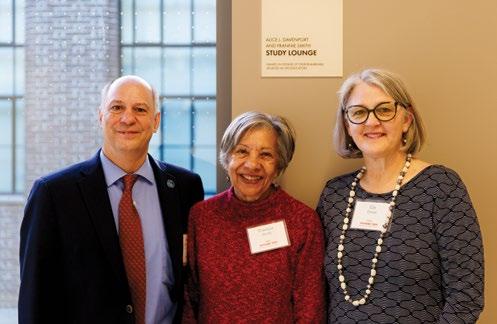
family’s ’67 Volkswagen. As parents, she and her husband, Horace, often included the kids in family discussions and decisions.
Davenport’s son, Champ Davenport ’72 said that her focus on literacy (and her teaching style) extended to their home life, as well.
“A really cool thing about my mom is that she would meet individuals where they were, especially those like me who had intellectual gifts but were not that into academia and programmed learning,” he said.
Prior to GFS, Davenport was the first Black teacher in the Norristown school district—an elementary school in Norristown was renamed Alice Davenport Elementary in 2023. She was active in the community, served on many boards, and won numerous awards, including the 2009 NAACP Award for Education and Community Service.
Champ also noted that his mom loved music (everything from Ray Charles to Prokofiev’s “Peter and the Wolf”), architecture, and driving the
“Mom would often come stand in the doorways of our bedrooms, and ask us kids for advice,” Champ remembered. “It empowered us that she wanted our opinions.”
Alice Davenport passed away in February of 2023 at the age of 103.
FRANNIE SMITH
Frannie Smith was Vice Principal of GFS’ Lower School between 1990 and 2000. While this was after DiNardo had graduated, he got acquainted with her through the First Presbyterian Church in Germantown, where they both attend.
“Through many different interactions, including meetings and volunteering in the kitchen, I came to know Frannie as the wonderful woman that she is,” DiNardo said. “She has a quiet and sincere way of speaking that commands one’s attention. It is obvious that she has
a caring heart and the fortitude and strength to turn that caring into action.”
Smith was and remains devoted to education; she began her career in education in Temple University’s Intern Teaching Program, and spent her early years teaching science to both middle and high school students in public schools. Smith and her husband Peter enrolled their children at GFS, and in 1990, she joined the Lower School administration as Vice Principal. From GFS, Smith went on to serve as Vice President for Education at Girard College from 2000 to 2010.
Smith generously offered her time and expertise as a member of the GFS School Committee from 2012 through 2017, and is still connected to GFS today. The impact of her leadership extended to both students and faculty, and her commitment was ultimately driven by her belief that a good education could level the playing field for all.
CLASS OF 1982 PEDESTRIAN WAY
Even four decades after graduating, friendships rooted at GFS remain deeply important to Michael Cohen ’82.
“My best friends in life are my GFS friends,” he said. “I share a value system with this group of people, like the importance of empathy, respect, and worrying about other people’s conditions and existences.”
Michael’s GFS friends share an active group chat, and when their kids were younger, they’d take family vacations together. He’s been on fishing trips with William and David Bank (both Class of ’82) in Massachusetts. A painting by Nicholas Ruth ’82 hangs in the Cohens’ living room. Michael is still in touch with David Felsen, Sr., his old basketball coach, and at least once a week for the past 25 years, Cohen has shown up for an early-morning basketball game in Scattergood Gym.
Sam Rhoads ’82 (who Michael met in sixth grade), Michael, and Michael’s wife, Amy Cohen, all have birthdays
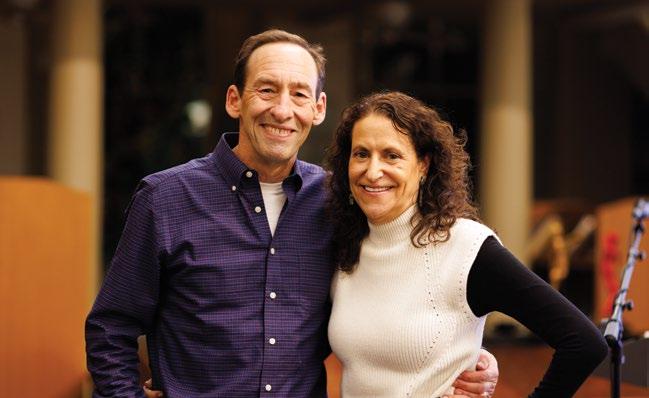
in the same month and often celebrate together. For their 50th, Amy dug up an old column the two friends used to write for Earthquake, “The Mike and Sam Connection,” and mounted it to a poster that all their friends signed. Michael’s GFS relationships aren’t a memory, but a vital part of his every day.
After committing a significant gift to GFS’ Picture This campaign in 2022 (establishing a new endowed fund for scholarship), the Cohen family stepped forward with a second gift in early 2025 to support the All School Commons. Their gift has been acknowledged through the naming of a new walkway that runs between the Meetinghouse and the new building, which will now be known as the Class of 1982 Pedestrian Way. Naming it for his class publicly celebrates a group of people Michael holds dear.
“I think naming it for my class is a really nice way to memorialize an important time in our lives,” he said. “And I love the fact that for generations, kids will walk along there and say, ‘Wow, the Class of 1982.’”
The Cohens, whose children also attended GFS, have given generously and consistently to the school for years, through the Annual Fund, endowed funds, EITC for scholarship, and capital gifts. “Giving is a habit,” as Michael puts it.
“Anyone who knows Michael wouldn’t be surprised that he’s given so consistently to the causes he cares about, because he’s very disciplined, and was mature before his time,” Amy said. “I also give to my alma mater every year, and that’s Michael’s influence. He says, ‘If you appreciate your
education, you give to your school, it’s the right thing to do.’ I learned that from him.”
After graduating from GFS, Michael attended Northwestern University, and then earned a master’s degree in city and regional planning from the University of North Carolina at Chapel Hill. He can trace his passion for city planning to the urban studies class he took with Joan Countryman ’58 at GFS. He vividly remembers a class trip in which they rode the Route 23 trolley from Chestnut Hill to the stadiums.
“We went through all these different North Philadelphia neighborhoods, through Center City and South Philly, and it was eyeopening in many ways,” he said. “The experience really had an impact on my future!”
Michael forged a career in real estate, and lends his expertise to GFS by serving as the Clerk of the Real Estate Committee and the annual Financial Aid Review Committee (he also served on the School Committee from 2013–2023). He appreciates the addition of the All School Commons as a central gathering point on campus, as well as the thoughtfulness of the building’s design.
“The space is great. It is understated, not flashy, and really fulfills the school’s Quaker ideal of simplicity while providing an important and much needed upgrade to the experience on campus.” E.K.
GFS Reaches Major Milestone in Picture This Campaign
A moment to celebrate and rally to the finish
GERMANTOWN FRIENDS SCHOOL HAS SURPASSED ITS $40 MILLION TARGET AHEAD OF SCHEDULE FOR PICTURE THIS —THE SCHOOL’S LARGEST-EVER COMPREHENSIVE CAMPAIGN. The campaign anticipates closing on June 30, 2026; the focus is now on reaching outstanding campaign goals: closing the funding gap on the All School Commons, growing the financial aid endowment, and raising additional endowment for community education.
The generous leadership and support of so many, and the momentum that is driving the community’s giving through the Annual Fund, has made this achievement possible. To date, Picture This has recorded over $40.3 million in gifts and pledges from over 2,800 alumni, parents, grandparents, faculty, staff, and friends, an unparalleled achievement for the GFS community.
“I speak for all members of the School Committee in expressing our heartfelt gratitude for the generosity of each donor and volunteer who has made GFS an important philanthropic priority,” said David Feldman ’76, Clerk of the School Committee. “Their investments have supported our mission and profoundly buoyed our excellent programs, our community, and our campus.”
In consultation with Head of School Dana Weeks and the GFS leadership team, the School Committee affirms GFS’ resolve to carry the campaign further. This decision is based on several factors:
• The All School Commons project, which was expedited to hedge against rapidly rising construction costs, remains $8 million short of its fundraising goal.
• The demand for financial aid is greater than ever, requiring additional dedicated endowment funds to help make GFS even more accessible to more students and families. We are currently 60% of the way toward our scholarship endowment goals.
• GFS has received its first-ever endowed gift to support and grow community education programming, but continues to pursue additional support towards its goal.
• The GFS Annual Fund, which currently contributes substantially to the yearly operating budget, supports every aspect of the school’s mission. Continuing to increase its value and impact remains a strategic imperative.
• Improving and expanding athletic facilities has become an increasingly urgent priority, and planning for those improvements is currently in the developmental stage.
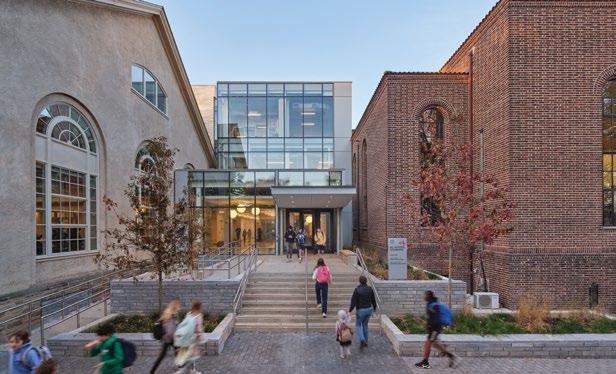
GFS’ Picture This: A Campaign for Learning in Community focuses on fostering cross-disciplinary learning in the arts and engineering, while supporting the wellbeing of our community; increasing need-based scholarships; expanding the teacher pipeline and offering meaningful academic enrichment opportunities for Philadelphia students; and furthering the extraordinary teaching and learning for which GFS is well known.
“We are deeply grateful to all who have signaled their faith in the school and their commitment to present and future generations of students who are transformed by the GFS experience,” said Weeks. “The Picture This campaign is, at its core, about nurturing great teaching and learning, focusing critical attention on student growth. And we know from long experience that this requires a commitment to community, to seeking truth, and to seeing and amplifying the Light within each person.”
We invite you to join us in the final year of the campaign! For more information, contact Hannah Caldwell Henderson ’91, GFS’ Chief Advancement Officer, at 215-951-2300 or hhenderson@ germantownfriends.org.
—Eryn Jelesiewicz
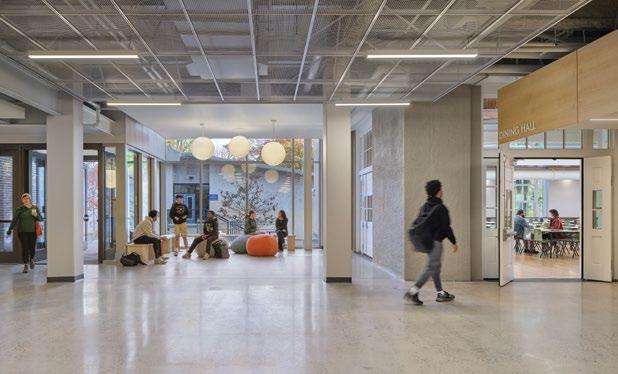
New Endowed Fund Builds on GFS’ Longstanding Commitment to Community Education
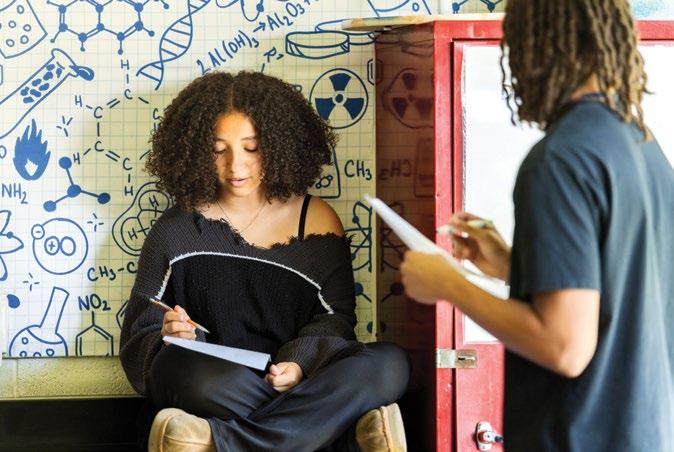
THE WYNCOTE FOUNDATION RECENTLY AWARDED A GRANT OF $1 MILLION TO GERMANTOWN FRIENDS SCHOOL TO ESTABLISH ITS FIRST ENDOWED FUND TO SUPPORT COMMUNITY EDUCATION. This is a significant step toward fulfilling the goals identified as part of the Picture This campaign.
Community education at GFS offers a range of academic and co-curricular programming to students attending local public and charter schools, as well as training to a diverse pipeline of those considering careers in education. Because it is endowed, this funding will be available in perpetuity, providing greater stability as we continue to scale these programs, expand partnerships, and, ultimately, strengthen outcomes for young people in the Philadelphia area.
GFS programs in the area of community education include Community Basketball and Enrichment, a low-cost summer program that blends athletics and academics; Breakthrough of Greater Philadelphia, a year-round
academic enrichment program for area middle school students and a hands-on training opportunity for future teachers; and GFS’ new teaching fellowship, which immerses pre-service and novice teachers in yearlong experiences in which they are matched with mentors who work with them in the classroom.
These programs are a continuation of GFS’ ongoing commitment to community education. The Friends Free Library has served both GFS and the Germantown community since before it was constructed (the books were originally kept in a closet in the Meetinghouse). Our archives show students and faculty across our history engaged and involved with neighboring organizations, volunteering at area schools, food banks, and historical sites, offering Community Writers Series events, and organizing around safety, clean streets, and traffic calming. In 1965, the Community Scholars Program was created to provide financial aid
Left: Breakthrough of Greater Philadelphia is one of GFS’ signature community education programs. College students and GFS Upper School students (like Isabella Bynum ’25, pictured) interested in teaching receive two intensive weeks of training and mentorship at the beginning of the summer before the middle school Scholars arrive. Many of these Teaching Fellows are inspired to pursue careers in education. Breakthrough celebrates its 30th anniversary this year!
LEARN MORE ABOUT THE PICTURE THIS CAMPAIGN!
for qualified students in Germantown and neighboring communities and this funding has grown substantially since inception. These are just some of the ways the school has sought to nurture educational exchange on campus and across the city at large.
“The existence of this new fund speaks volumes about the successes we are seeing in this area of our work and to the quality of the people involved,” said Head of School Dana Weeks. “Community education is part of our mission and there is a sense of urgency among our faculty, staff, and families to expand our reach and offering.”
There is significant unmet demand for this programming, and GFS invites your support to help meet it. For more information, pease contact Duane Sims, Associate Director of Advancement, at 215-951-2340 or dsims@germantownfriends.org. E.K.
Bob Giess ’57: A Lifelong Musician & Devoted Supporter of GFS
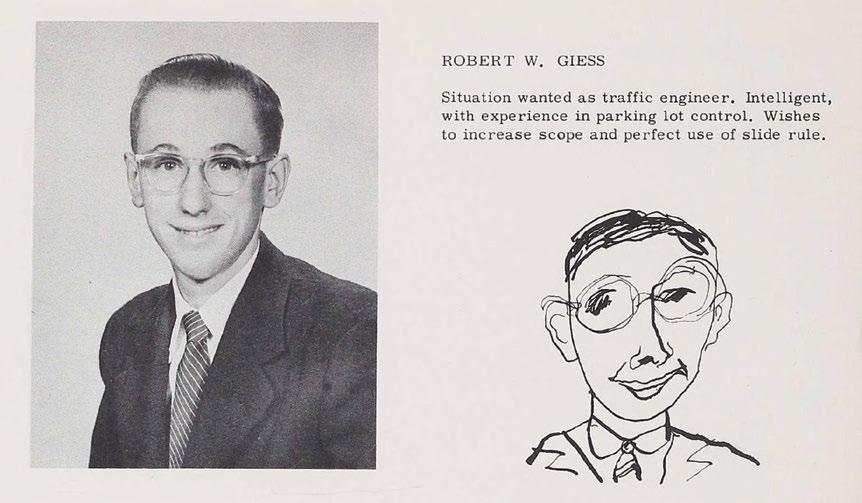
THERE ARE A NUMBER OF GFS ENDOWED FUNDS THAT SUPPORT THE ARTS; ONE OF THE FUNDS MOST DIRECTLY RELATED TO MUSIC IS THE SIX SAINTS MUSIC FUND, WHICH WAS ESTABLISHED BY ROBERT (BOB) W. GIESS ’57, ALONG WITH SEVERAL ALUMNI MEMBERS OF THE SIX SAINTS JAZZ BAND, WHICH WAS THE FIRST ORGANIZED JAZZ BAND THE SCHOOL HAD EVER KNOWN.
Giess was a true music lover and lifelong musician. Right up until his death in 2023, he kept a piano in his home and sang in the choir at his church, Trinity Episcopal Cathedral, in Sacramento, California.
As a child growing up in Northwest Philadelphia, Giess began taking piano lessons at age seven, and sang in the boys’ choir at his church starting at age eight.
“Piano was his main instrument, and he’d play at home all the time,” his brother, John Giess ’55, remembered. “He had perfect pitch.”
At GFS, Giess co-founded The Six Saints in ninth grade. This swing-y jazz band featured: Giess on piano, Dick Willis ’57 on drums, Bob Marvin ’57 on bass, Dave Bassett ’57 on clarinet and saxophone, Bill Braunewell ’57 on trumpet, and Seth Singleton ’58 on trombone. Between 1953 and 1957 they played at GFS school dances and events, sometimes dressed in saintly costumes. Their repertoire included hits of the day, like “Hey BopA-Re-Bop,” “Night Train,” and their big hit, “When the Saints Go Marching In.” At GFS, Giess also played soccer and sat on the Choir Council and Parking Committee.
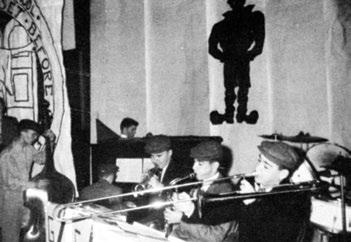
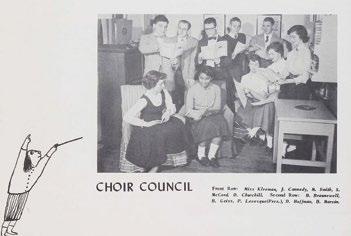
After graduating from Germantown Friends School and earning a bachelor’s degree in engineering from Lehigh University, Giess worked for CalTrans for 40 years as an engineer/engineering manager. During his career, he obtained a master’s degree in civil engineering and a Professional Engineering credential. He was also a member of the National Guard in the 1960s.
Giess and his old bandmates established The Six Saints Fund in 2018 to provide financial assistance to GFS students and faculty within the music program, to enhance musical performances, and to bring guest musicians to perform at the school. Thanks to Giess’ generosity in his estate planning, a planned gift came to GFS after his passing. This contribution leaves a lasting legacy as part of the Picture This campaign, providing additional support of the fund, as well as for the All School Commons.
Russ Giess, Bob’s nephew and trustee, noted that GFS had been part of Giess’ estate plan for quite some time. He said that his uncle’s school memories remained vivid throughout his life, and he often spoke of GFS fondly.
“He and my father would tell these interesting stories about their small school, and they were always amazed at their classmates and what they were able to accomplish,” he said. “GFS gave them a really superior education that allowed them to be successful in their professional lives—there was always going to be a gift to keep the school going.” —E.K.
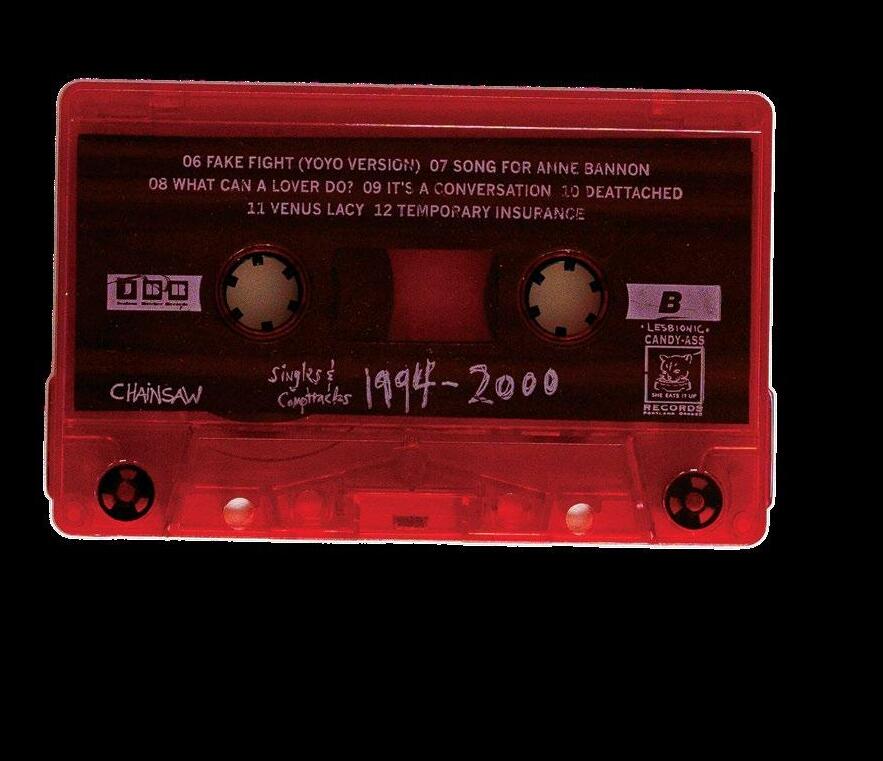

The GFS Fac/Staff Mixtape
Many GFS faculty and staff boast major musical chops, and we’re not just talking about our music teachers! Across the city, they perform as singer/ songwriters, guitar shredders, and even a sibling duo. Here is the track list for
the GFS fac/staff mixtape:

GENEVIEVE CHAMBERS
Early Childhood Music
THE COVER GIRLS DUO
Chambers and bandmate Michelle Krichilsky deliver a delightful mix of popular covers and catchy originals, connecting with audiences through good vibes and great music.
FEATURED TRACK:
Cover of “Royals” by Lorde IG: @thecovergirlsduo
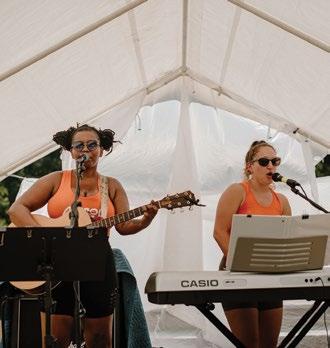
ALEX LEVIN ’93
Upper School English
THE ALEX LEVIN TRIO
This jazz band has recorded five albums, performs frequently in Philadelphia and New York City, and plays jazz standards and original compositions. Their most recent album, “A Sunday Kind of Love,” was featured on WRTI and WXPN.
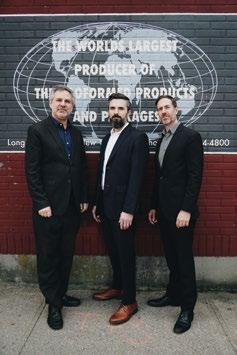
FEATURED TRACK: “If I Should Lose You”
IG: @alexlevinmusic
SHAWN HENNESSEY ’98
Middle and Upper School Music
HENNESSEY BONFIRE
Hennessey’s passion project, Hennessey Bonfire, features lush, organic, original songs, soulfully rooted against the backdrop of world rhythms.
FEATURED TRACK: “Soft Light”
IG: @hennesseybonfire
Photo credit: Lisa Schaffer Photography




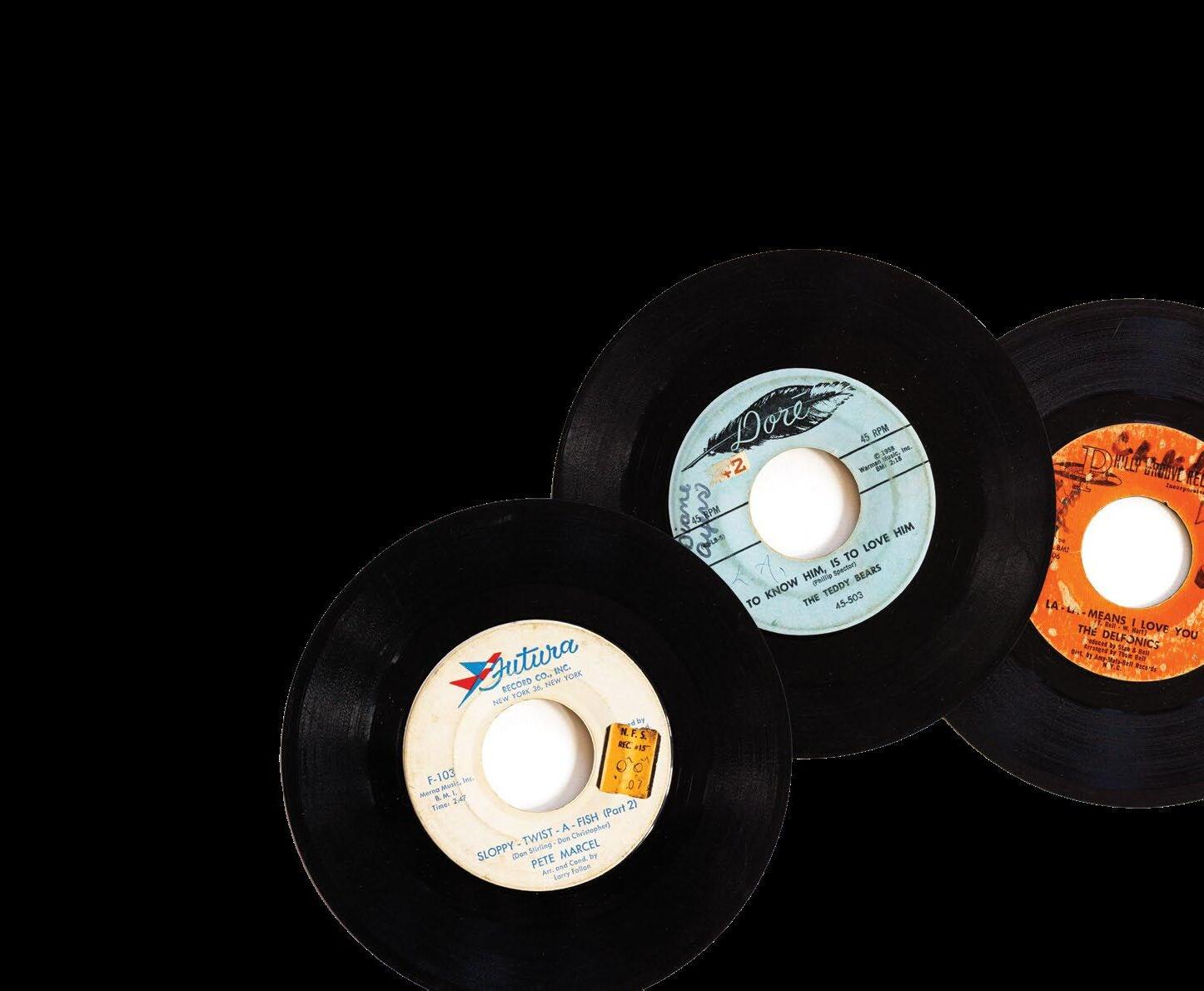
RACHEL MAYER
Lower School Office
Mayer is a pop singer/ songwriter making music as a way to take control of the narrative, spark new anthems, and rage against the darkness.
FEATURED TRACK: “Every Single Song”
IG: @rachelmayermusic

SAM THACKER
Upper School History
DOUBLE TRUCK
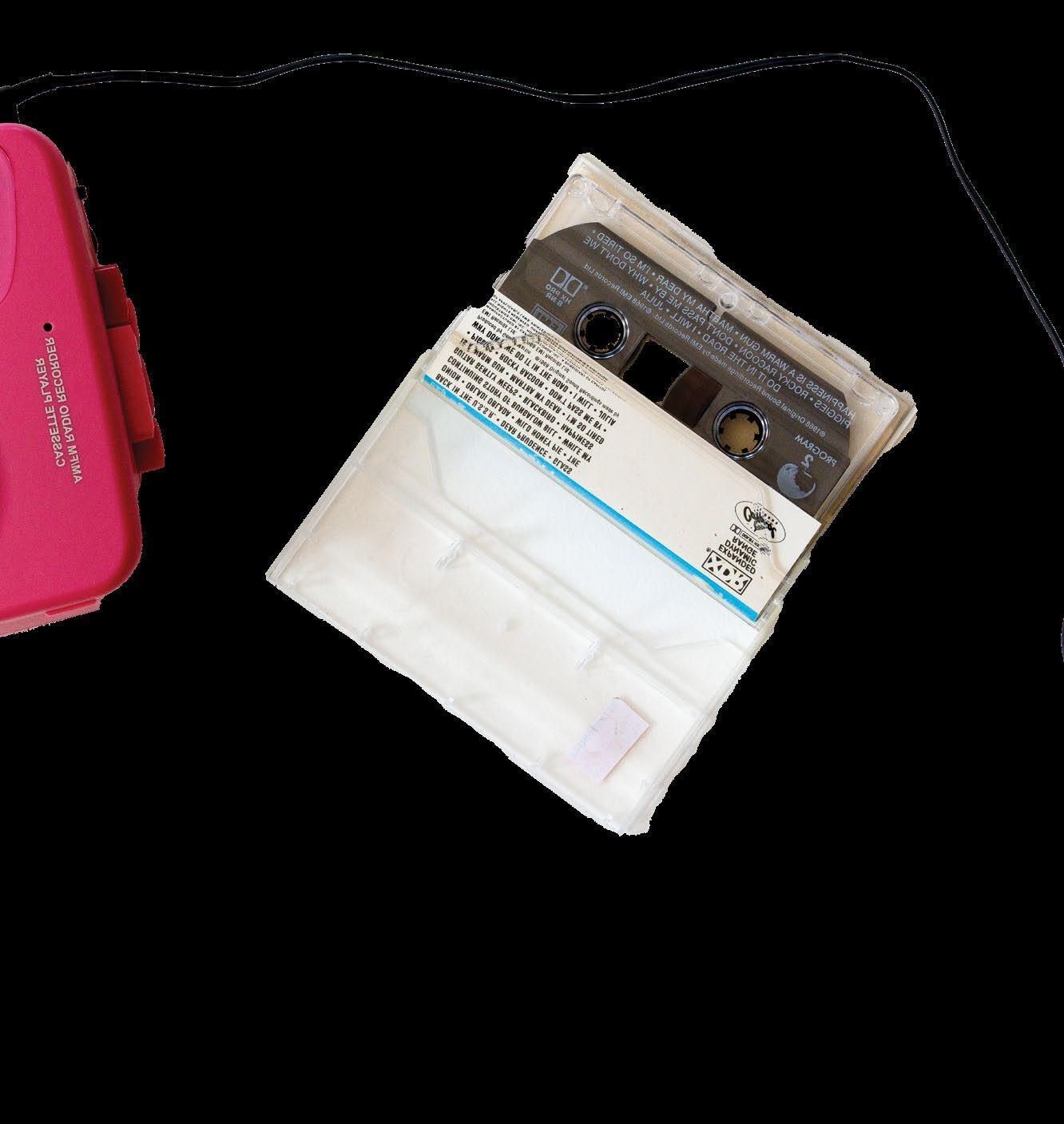

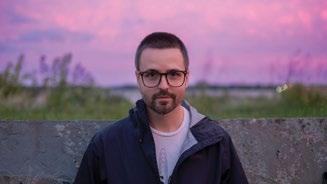
Thacker’s folk-rock outfit brings influences from across American musical traditions into his songwriting and records with a shifting assemblage of musicians. His rock band, Heavy Tears, released music this spring.
FEATURED TRACK: “Grapeshot Souvenir”
IG: @doubletruckdoubletruck

HAYLEY VARHOL
Middle and Upper School Music
WEST PHILADELPHIA ORCHESTRA
Varhol plays baritone horn and sings in this stalwart avant-folk village brass band that traverses a wide range of styles, including traditional Balkan music (emphasis on Serbian and Macedonian repertoire), klezmer music rooted in Philadelphia’s klezmer tradition, New Orleans brass, and free jazz, all played with a “vibrant punk and cheesesteak-infused sensibility.”
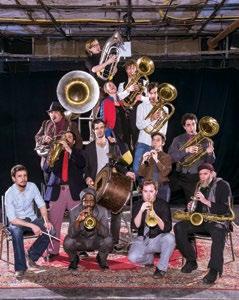
FEATURED TRACK: “Pole Grease,” a tribute to the chaotic energy of Philly sports fans
IG: @wpobrass
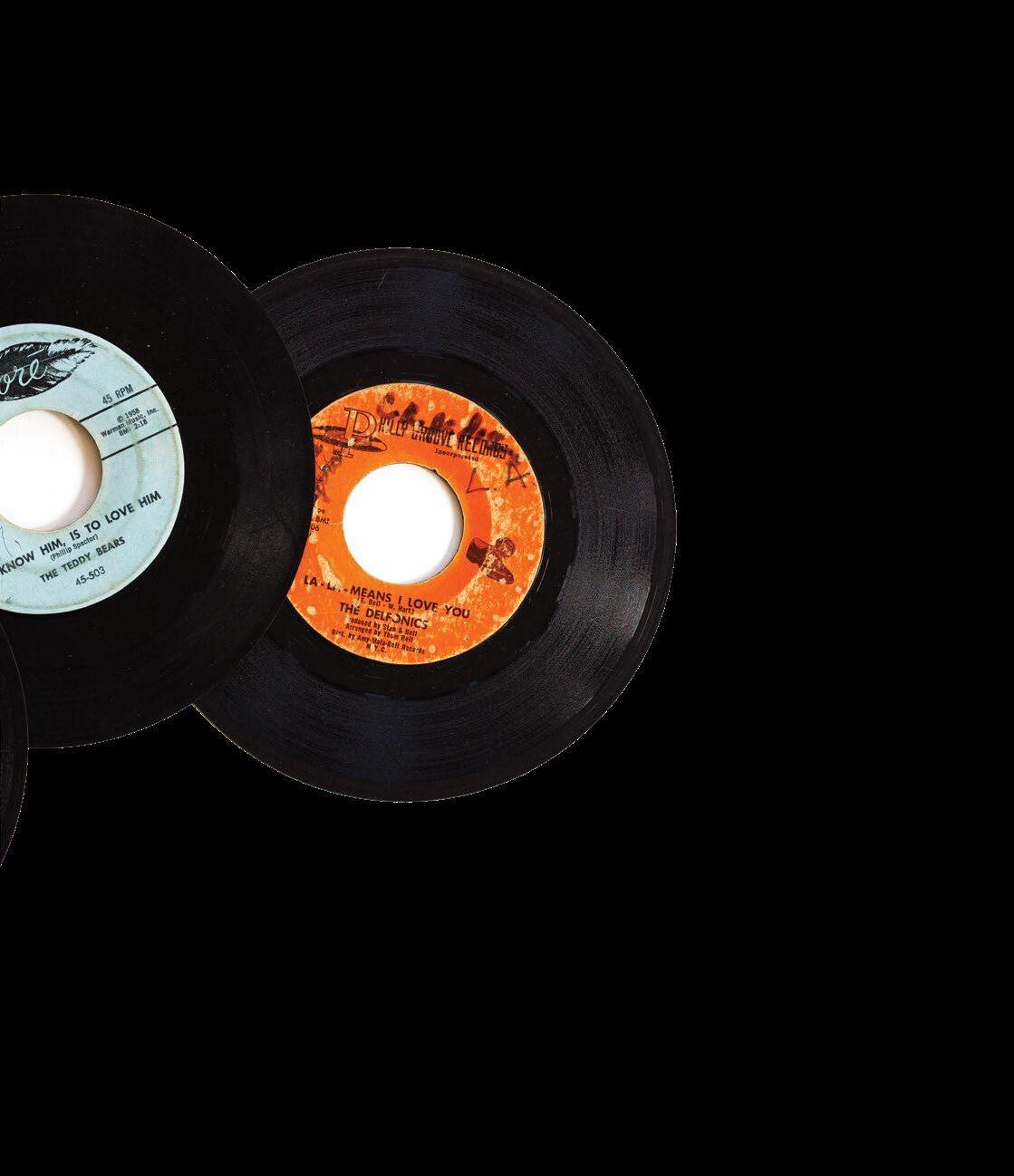
ALISON HILLEY
Early Childhood Music
ALYCAT
Hilley is a singer/songwriter, blending electronic, soul, and rock music. She is the musical director of a wedding band, sings in an original harmony trio, and her rock band, AlyCat, has been together since 2011.
FEATURED TRACK: “Another Woman”
IG: @alycatmusic_
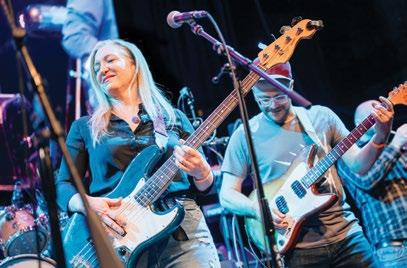
CARLY DECOCK
Lower School Music
ANNE HESS
Upper School Chorus and Choir Director
SINGING CITY
DeCock and Hess both sing with Singing City, Philadelphia’s premier avocational chorus. This artistically-driven, socially conscious, and civically engaged vocal movement has been active since 1948. Acclaimed composer and conductor, Dr. Rollo Dilworth, is currently the group’s artistic and music director.
FEATURED TRACK: “When Thunder Comes” by Mari Esabel Valverde
IG: @singingcitychoir
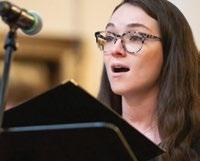
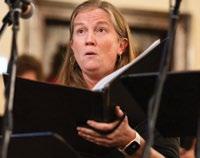
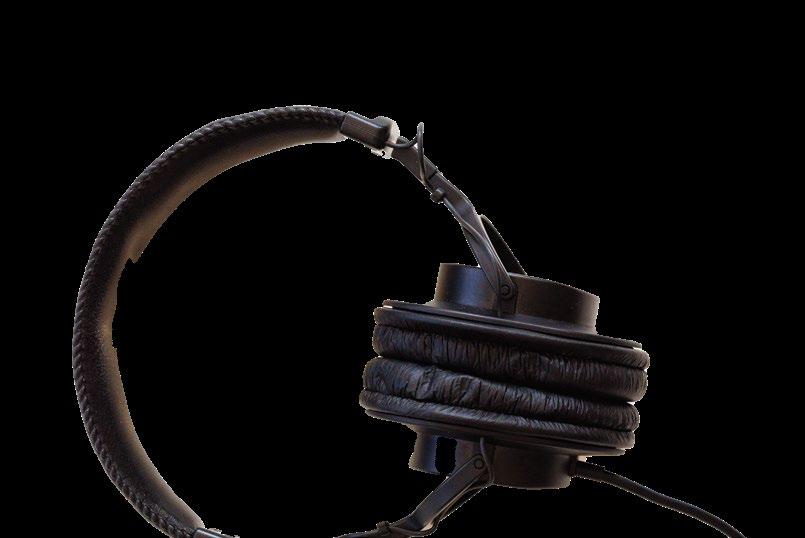
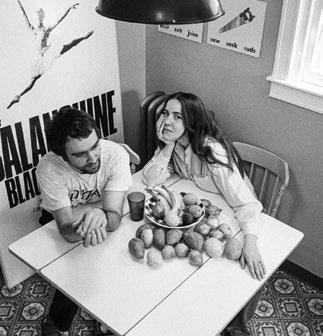
SAM SULLIVAN
Upper School English
LOUISE SULLIVAN
Lower School Teacher
SAM AND LOUISE SULLIVAN
The Sullivans are a family band from Philadelphia. They make folk, pop, and rock music that draws on their roots playing oldtime and traditional music.
FEATURED TRACK:
“I Got A Light”
IG: @samandlouiseband

SAMUEL MCILVAIN
Upper School French, Boys Varsity Soccer Coach
LOOSE AND ALRIGHT, THE FLIPSIDE ORGAN TRIO
McIlvain’s primary two bands serve up tasty funk, soul, groove, and jazz fusion. He’s also a part-time guy
VICTORIA SPAETH NYCE
Lower School Substitute Teacher
VICTORIA SPAETH AND THE SPAETH CADETS
Spaeth Nyce leads this original, harmony-driven, folk-rock band with jazz and blues influences. The line-up frequently features an all- or majorityfemale lineup of musicians.
FEATURED TRACK: “Electric Love”
FB: @spaethcadets
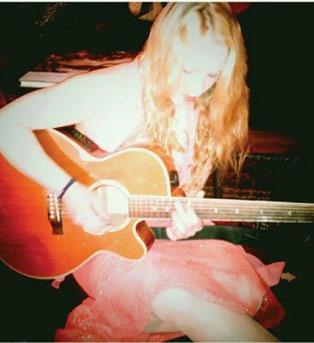
MIKU SHIOTA
Middle and Upper School Music
THE DIVINE HAND ENSEMBLE
Shiota plays violin and viola in the Divine Hand Ensemble, possibly the only theremin-led group in the world. The band includes a string ensemble, two harpists, two percussionists, and an accordion player; they cover everything from Beethoven to Frank Zappa.
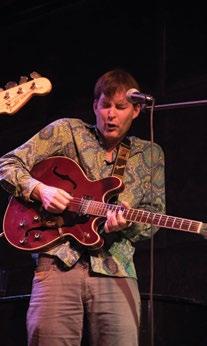
FEATURED TRACK: Cover of “The Man Who Sold the World” by David Bowie IG: @divinehandensemble
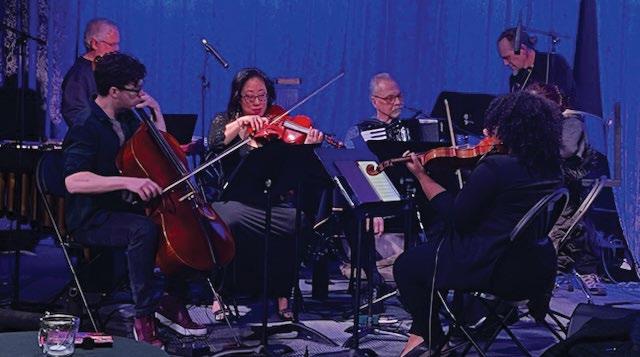
SCAN HERE TO LISTEN TO OUR FAC/STAFF MIXTAPE


Notes on Music
Three teachers answer: What makes music at GFS special?
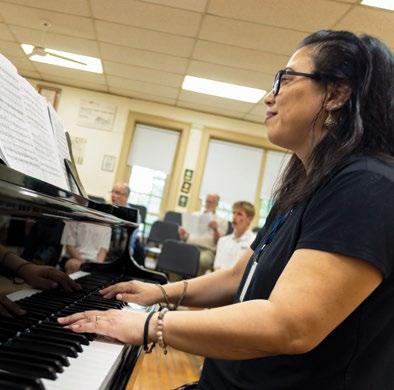
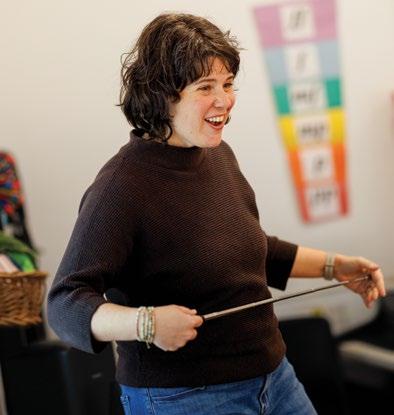
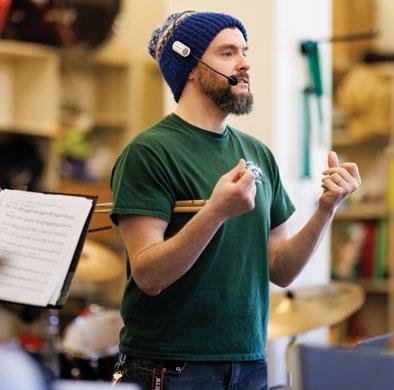
MIKU SHIOTA, Middle and Upper School Music
People often think of music classes as playing an instrument in a band or singing songs, but there is so much more than that happening at GFS. Students can study World Music through folk dancing, or use computer programs to learn about music composition. They can learn about hip-hop music and culture and how to build musical instruments. Our non-performance desktop classes are designed to create an awareness and an appreciation for the worldwide community of music-makers and of how music is made.
No matter how our students interact with music, it plays a vital role in a child’s development. Learning to play an instrument requires patience, perseverance, and self-awareness. It develops both fine and gross motor skills, and learning to read musical notation is like mastering a foreign language. Playing in an ensemble teaches students about collaboration and community, and it puts cultural and historical knowledge into practice. There are also direct connections between music and other core academic subjects.
RENEE WARNICK, Lower School Music
Making music is a universal human behavior, and every kindergartener walking into music class is already a musician. The best way to engage students who are still building skills and confidence as musicians is by creating a joyful, playful space where they can feel safe.
The Lower School music room is full of dramatic play and vocal exploration. We play games and move our bodies—stepping, twisting, tiptoeing, galloping—and we sing, chant, play instruments, and listen in stillness. The teachers set clear boundaries and community norms because that helps to make our space feel open for exploration.
But music class isn’t just fun and games. Hiding under the surface is a carefully scaffolded and sequenced curriculum of musical concepts and skills. Every song, rhyme, and game is chosen for a specific pedagogical purpose. By the time I teach the name and written notation of a new rhythm or pitch, students have been singing it, playing it, and moving to it for weeks or months. The more enjoyable it is for students to participate, the more their technical skills grow, and the more their technical skills grow, the more fun participating becomes.
CHRIS COYLE, Upper School Jazz Director, Middle School Rhythm Ensembles
GFS’ Upper School Jazz program rehearses and performs rigorously. We also prioritize learning goals that aren’t directly tied to instrumental technique. We examine jazz’s cultural and historical roots, as well as jazz-adjacent styles and sounds, like gospel and the blues. Students are assessed on cultural learning, as well as performance, which impacts their mentality and playing. Reading texts and learning theory can supplement—but cannot take the place of—listening and playing.
Playing and learning jazz requires musicians to reflect differently than other music styles. Often, there is not just one way to play your part, and playing the “correct notes” is sometimes not as important as the energy and character of your playing. To put it another way, expression can be more important than execution.
And when we’re collaborating, success as a team of musicians shouldn’t (and almost can’t) be measured technically, but by the quality and spirit of the group’s sound. That’s why I encourage students to participate in selecting our repertoire; they are shaping what we play and how we play it.
Wired for Sound
In Andrew Westerhaus’ “Instrument Building” class, students craft drums, woodwinds, and stringed and electronic instruments from scratch.
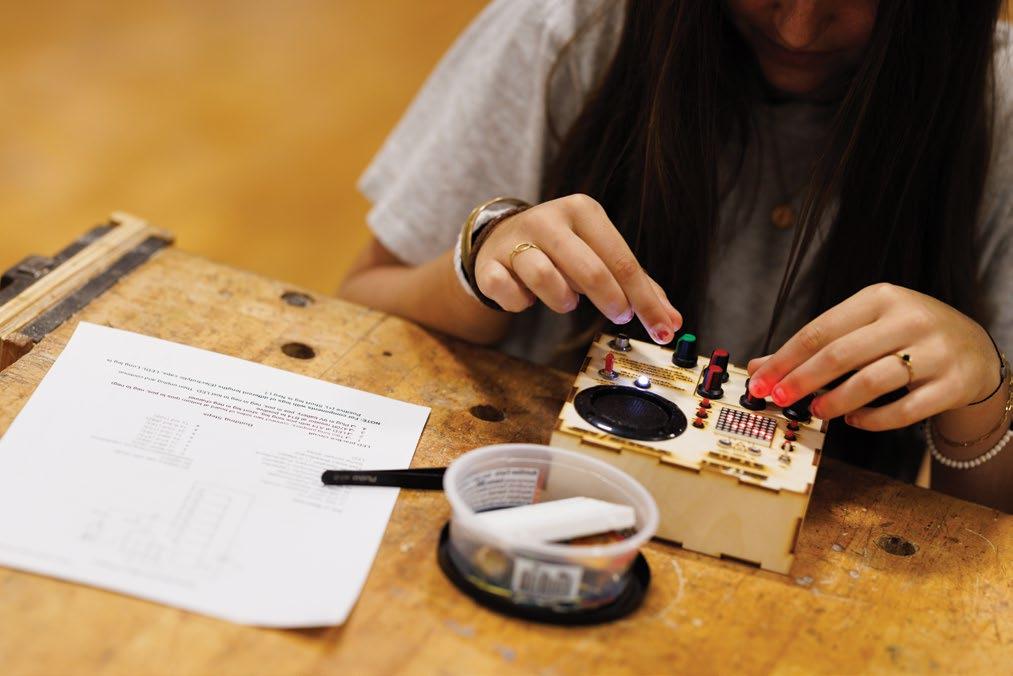
SAWING, SANDING, SOLDERING— THESE MIGHT NOT BE SKILLS OFTEN ASSOCIATED WITH AN UPPER SCHOOL MUSIC CLASS, BUT IN “INSTRUMENT BUILDING” STUDENTS SPEND MORE TIME IN THE WOODSHOP THAN THEY DO IN THE CLASSROOM.
This popular hands-on elective started as a January Term course, and was rolled into the regular curriculum in 2019. It’s taught each year by GFS music teacher Andrew Westerhaus who began experimenting with instrument-making in college, and has dabbled with it ever since, learning through books, YouTube videos, and trial and error. The class currently runs during both semesters, with stringed and wind instruments in
the fall and percussion and electronic instruments in the spring.
In the class, students tackle each project at the same time and the assignments get progressively complex as the semester passes. If students choose to take both semesters, they’ll have made upwards of 10 functional instruments by the end of the year.
Whether it’s something relatively simple, like a bamboo drum, or the final project of a small synthesizer with a built-in amplifier, Westerhaus focuses on the simple joy of fusing form and function.
Each instrument unit begins with Westerhaus covering the musical concepts of how sound is created and amplified based on different shapes, materials, and mechanics. He shows the class videos or live demonstrations of the instruments in action, and they listen to a piece of music that features the instrument they’re going to make. Then, the students receive printed instructions and spend the next few classes hard at work in the woodshop with Westerhaus providing guidance.
“Andrew is incredible at breaking things down, and he really puts time into creating step-by-step instructions
“The biggest question I pose to them throughout the class is: How does it work? And we check in on this question throughout the process,” he said.
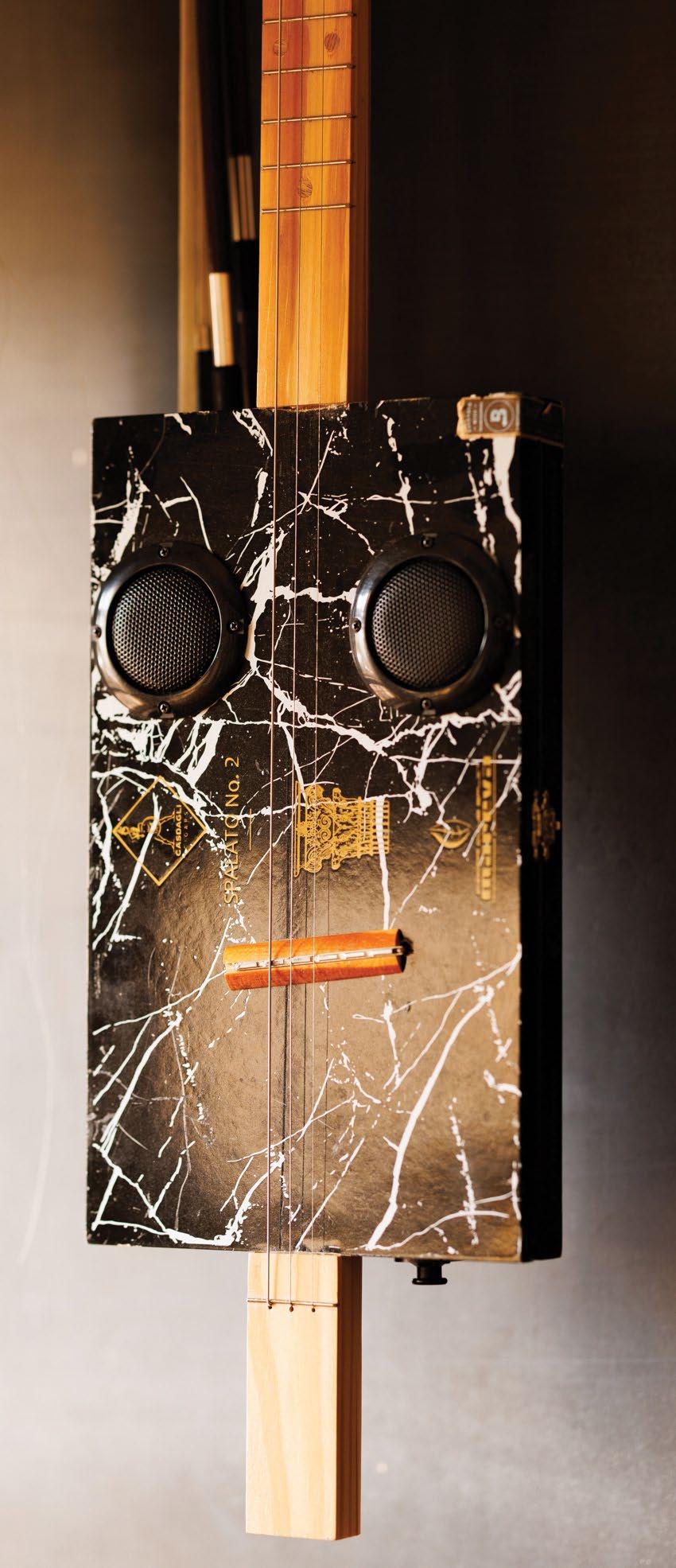
A sampling of instruments students made in the 2024-25 school year (clockwise, from left): a three-stringed cigar box guitar; a travel ukulele with a built-in pick-up so it can be plugged into an amplifier; a cajon (wooden snare drum) emblazoned with artwork each student designed and printed using the laser cutter in the All School Commons; and a synthesizer with an Arduino processor and a built-in amplifier.
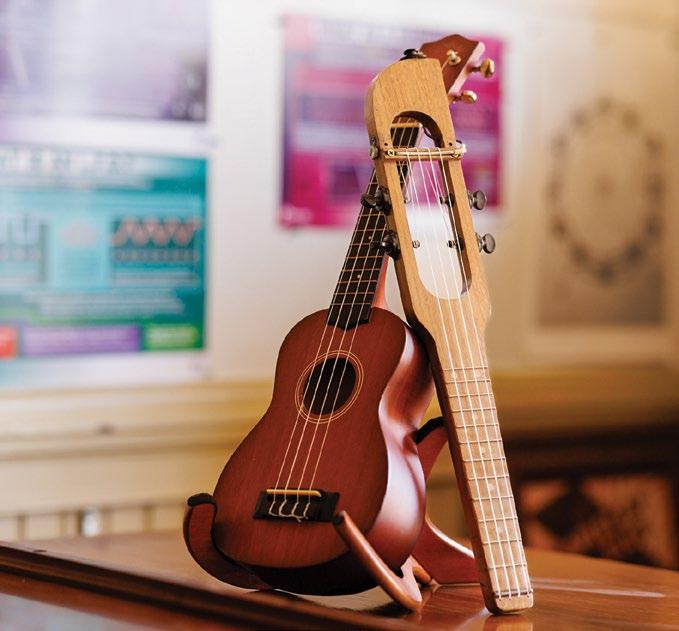
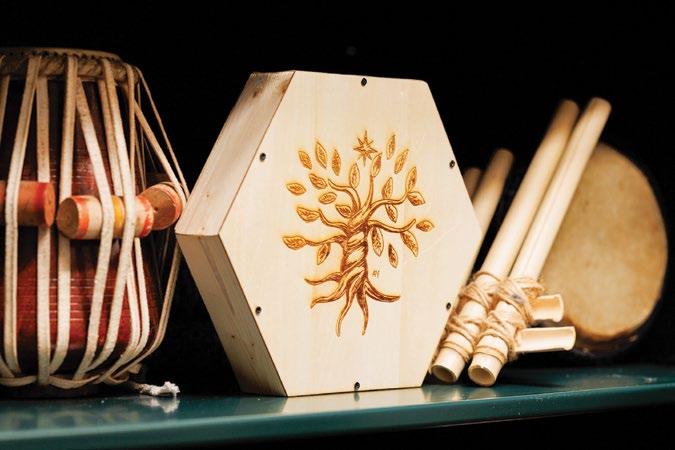
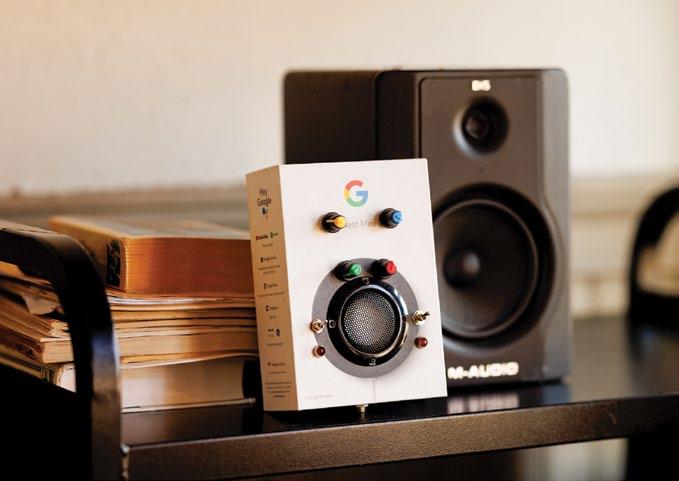
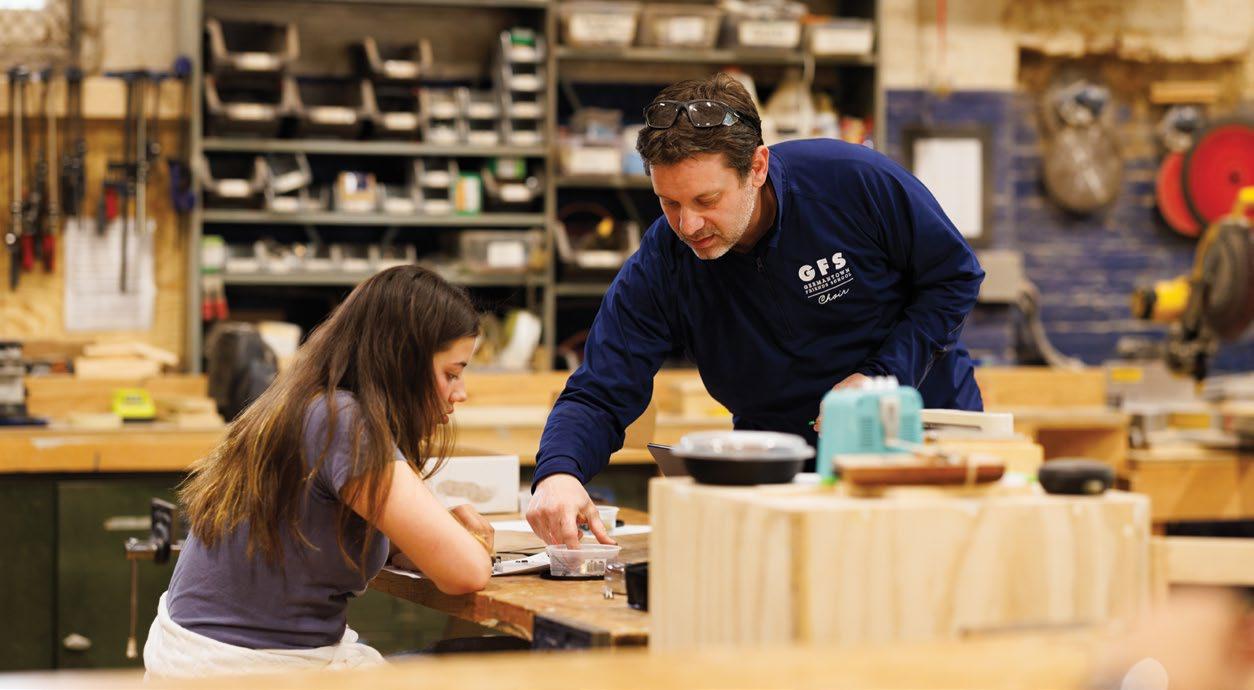
“This is a great class for students who might not think of themselves as musicians but want to learn more about how sound and instruments work.”
and processes,” noted Mika Orenstein ’27, who took both semesters of the class this year.
Many GFS students already have basic proficiency with woodworking tools from Middle School woodshop classes. Those experiences give them confidence to work with more specialized machinery, like band saws and drill presses, in this class. And, at its core, “Instrument Building” is as much an art and design class as it is a music class. It often attracts students who are interested in sculpture, engineering, computer science, and advanced physics.
“This is a great class for students who might not think of themselves as musicians but want to learn more about how sound and instruments work,” Westerhaus said. “And because
so much of the learning is thinking about the sequential process of making something, and being deliberate and meticulous about the way you do that, they’re developing life skills here, too.”
Orenstein, who described herself as “very much not a music person,” liked that the class gave her an avenue to explore music and make something tangible.
“It’s calming to work with your hands and focus on something in your control,” she said. “Learning how to work with these tools feels good.”
Zeke Hammarhead ’27 is a seasoned musician. He plays guitar and bass in an Upper School group, Jam Band, and in a rock band outside of school, Trash in the Attic; he’s also part of GFS Jazz Band and A Cappella. He’s built guitars before, including a
bass he made for his Eighth Grade Capstone Project.
Even with this prior experience, he’s learned a lot in “Instrument Building.”
“In the fall when we were making wind instruments, learning how each instrument manipulates air in different ways was cool—I didn’t know anything about that before,” Hammarhead said.
“I like how Andrew is adamant about us knowing how each instrument works and how it makes sounds.” E.K.
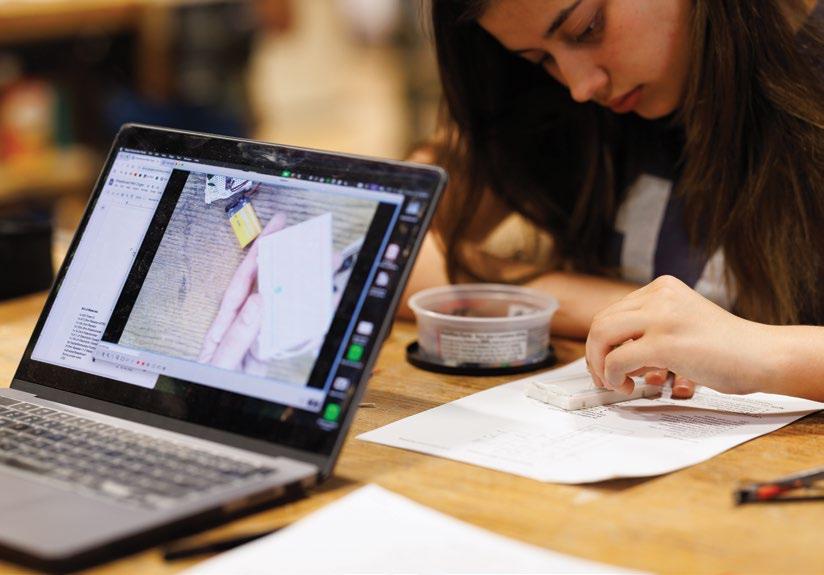
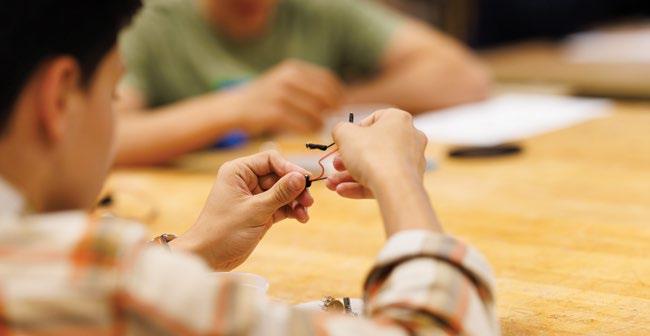
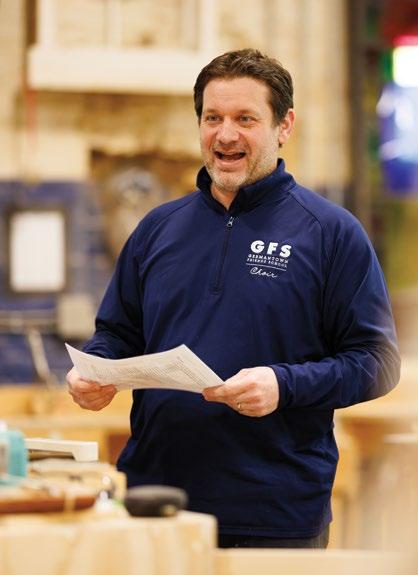
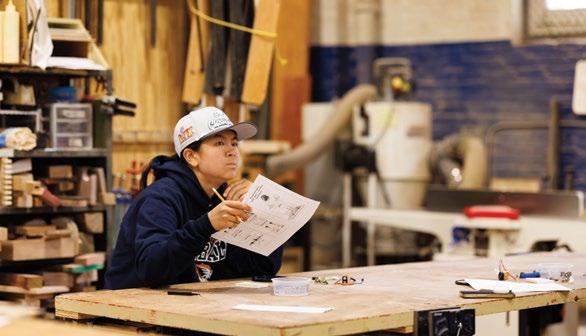
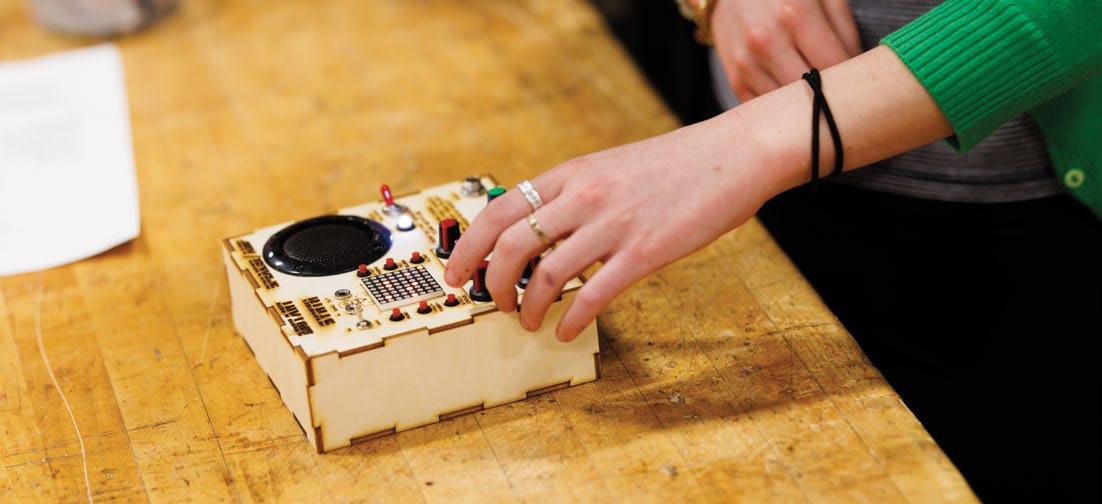
Opposite page, and above: The final project of the spring was building a synthesizer. For a few weeks in April, students met in the woodshop to learn about soldering and wiring the internal components. “A lot of the teaching is ‘watch me do it, then you try.’ They work with each other quite a bit, too,” Westerhaus said.
GFS A CAPPELLA: VOICES JOINING IN COMMUNITY
2025 marks the 30-year anniversary of A Cappella Fest at GFS. The occasion means the 20-member Upper School student ensemble, which released a new album, “Enlighten,” in the spring and performed at A Cappella Fest in February, is also the subject of a new documentary made by GFS A Cappella alum, Eli Eisenstein ’18.
By Eryn Jelesiewicz
EVEN SEVEN YEARS AFTER GRADUATING, THE CAMARADERIE AND SPIRIT OF GFS A CAPPELLA REMAIN VIVID FOR ALUMNUS ELI EISENSTEIN ’18. He has such fond memories of his time in the group that this aspiring filmmaker jumped at the opportunity to produce and shoot a documentary to celebrate the 30th anniversary of A Cappella Fest.
“I loved A Cappella [at GFS] so much,” said Eisenstein. “I never saw myself as theatrical, but I had a lot of pent up energy and I found this amazing group of people with shared interests who were excited to get onstage and perform. It was such a creative outlet and so fundamental to my high school experience that I want to give some of that back.”
His film, “30 Years of A Cappella Fest,” which was released in March, pays tribute to the amazing community a cappella fosters, a community that, for Eisenstein, has extended well beyond high school. Today, Allen Drew, the director of the group, continues as a mentor for Eisenstein; his fellow student performers remain close friends;
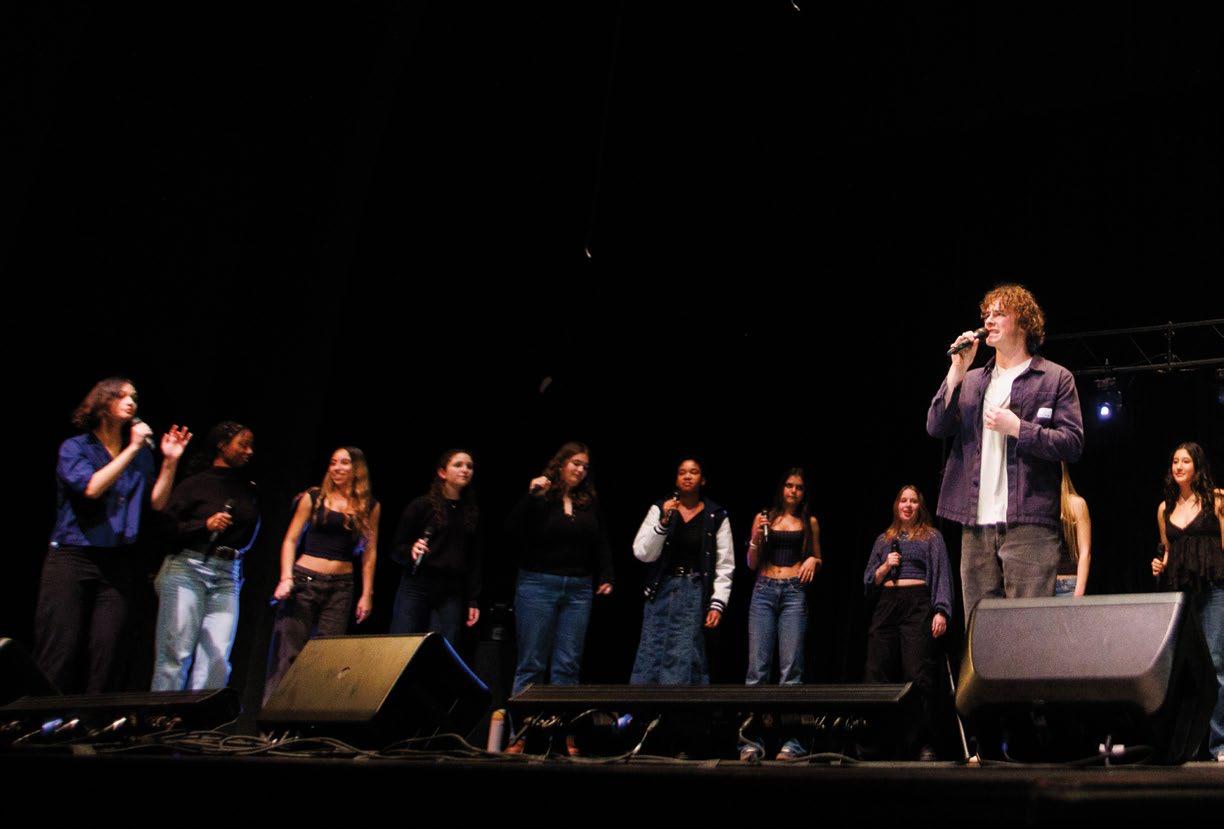
and he’s made new friends in the larger a cappella world.
Eisenstein and current GFS
A Cappella students credit Drew with creating an atmosphere that’s both welcoming and challenging.
“Allen makes the music very accessible and he puts himself out there,” said Eisenstein. “He chooses songs you might not have ever heard before, or puts a fun twist on a popular song, which helps kids explore different aspects of themselves.”
For Lani Okewole ’25, the 2024-25 student Music Director of A Cappella, Drew’s college-level expectations pushed the group to keep going bigger and getting better, and to embrace their inner performers. Rather than striving to sing a song perfectly, performing is about feeling the music and inviting the audience into that experience.
“That’s what a cappella is about, and it’s one of the things I love about Fest,” said Okewole. “You’re actually part of the phenomenon of connecting people with songs. I want to feel that the audience is responding to me, and feeling
what I’m feeling; and to know that I’m making them happy, and that they’re being touched by music.”
Drew took over A Cappella in 2002 and Mary Ann Case, a singer and parent of four GFS alumni, has been assisting with the Fest since 2011. GFS is unique in first offering a cappella as an activity, and now class, with a dedicated teacher who is experienced in the field. Middle School also offers a cappella.
Like all of GFS’ renowned music programs, A Cappella embraces the evolution of technology and technique, keeping in step with the progression of the art form overall.
The program now consistently utilizes bass, beatbox, and solo mics for smaller gigs, and features the industry standard of all singers on wireless handheld microphones at major events. The group’s more recent albums, including “Enlighten,” can be found on all major streaming platforms.
While they are always tweaking and learning, Drew says that GFS
A Cappella has stayed true to its core—exploring a range of genres
and techniques, developing student leadership, growing together as musicians and friends, and having a ton of fun.
As a singer himself, Drew discovered a cappella in college. His approach to teaching it reflects GFS’ educational foundation of learning in community. While A Cappella is a class, it operates like a group, which fosters learning as a team. The annual repertoire is curated by Drew in collaboration with the students—he makes sure to include as many musical genres as possible, including R&B, pop, jazz, funk, rock, and hip-hop, to help students find a love for all kinds of music. He also urges them to explore a range of different vocal techniques and roles within the group, growing together as musicians and friends.
Students hold leadership positions in the ensemble, serving as musical directors and student presidents, and they arrange music. As a team, they vote on the songs they record in the spring, and collaborate to choose the theme and selections for their annual Fest medley tradition. In this way,
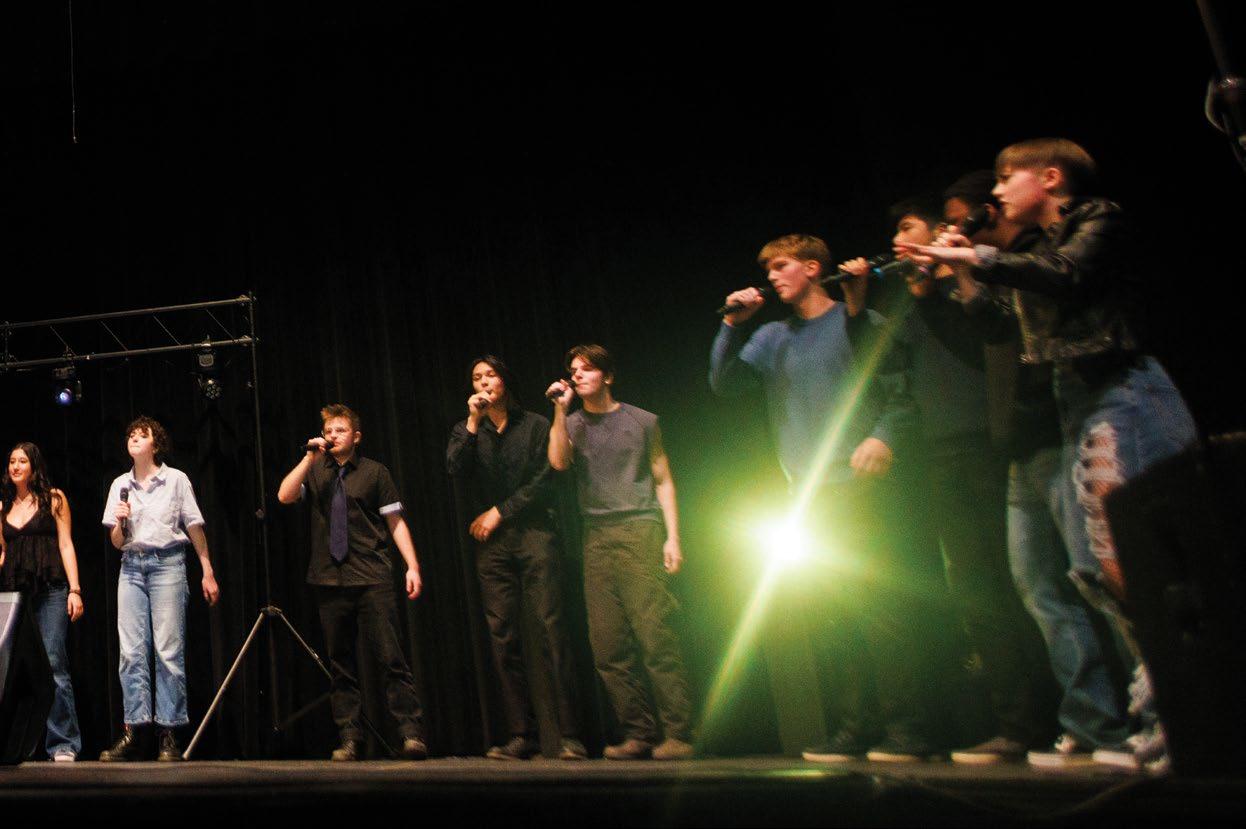
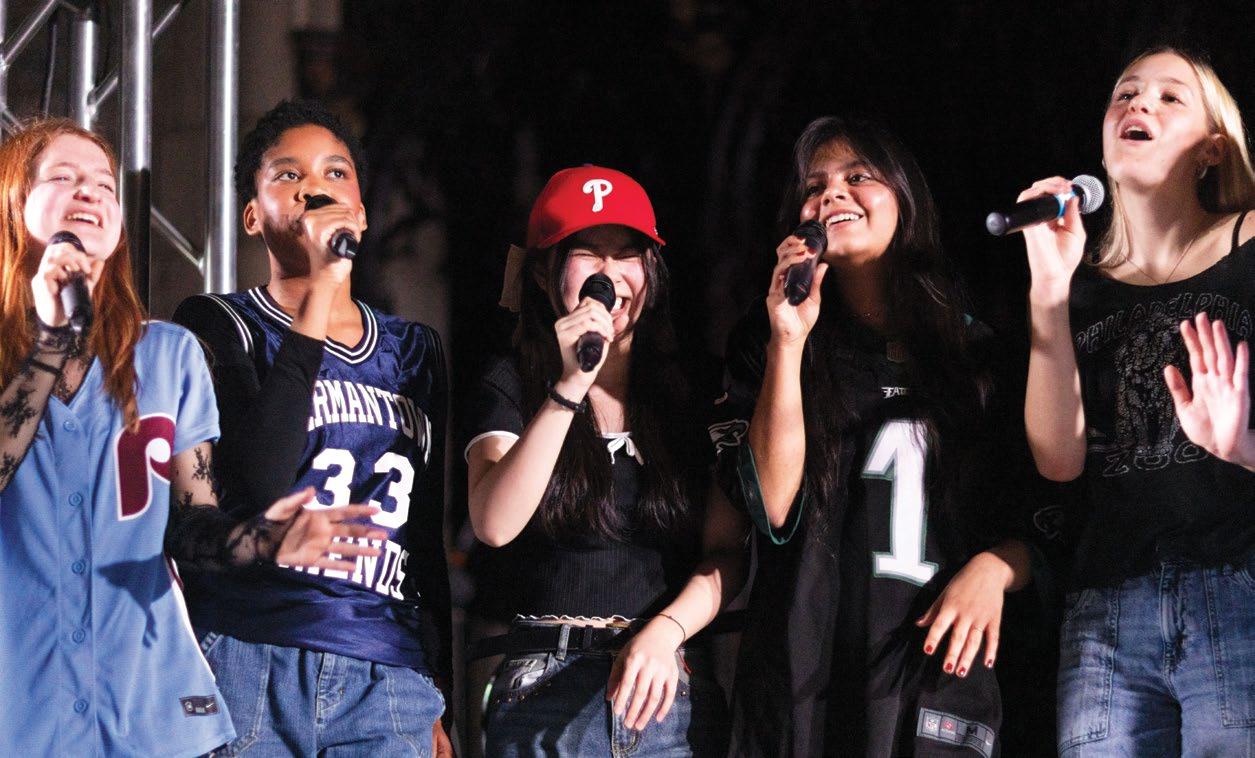
“People who love each other sing better together.”
they develop a real ownership of the group, which is great preparation for college where a cappella groups are consistently student-run.
“Singing close harmonies in a small group is a deep bonding experience and that’s a huge focus of mine,” said Drew. “Because the students think of themselves as a team, solos aren’t about individuals, but rather, ‘Which voice sounds best for our collective in this situation?’ People who love each other sing better together.”
The dynamic harmonies, tangible energy, and clear affection between members of the group make their performances a welcome addition to events and assemblies across campus.
Their talents have also been formally recognized: in early 2025, GFS
A Cappella was nominated for four
Contemporary A Cappella Recording Awards (CARA) for “Enlighten,” which is made up of songs performed by the 2022–2023 and 2023–2024 groups. CARA are the premier international a cappella recording awards, covering everything from high school to college to professional work around the world. “Enlighten” was nominated for Best High School Album, Best High School Soloist, Best R&B Song, and Best Rock Song.
Like Eisenstein, who had been singing for a long time prior to joining A Cappella, both Lani Okewole and Ethan Garrity, members of the class of 2025, came to the group with musical performance backgrounds. For Garrity, it was singing with the chorus and playing guitar and piano; for Okewole, it was performing in the Philadelphia Girls Choir.
Okewole appreciated how wel-
coming everyone in A Cappella was, especially as a younger person (she joined in tenth grade).
“It’s such a safe space to be in,” she said.
Garrity started at GFS in seventh grade, and was part of Middle School
A Cappella. In ninth grade, he auditioned for the Upper School ensemble and has been part of it ever since. He enjoys the challenging, technical nature of the arrangements and harmonies, as well as the broad range of music that the group covers.
“A Cappella has helped me grow as a singer and a musician,” he said.
“Since we have to mimic every instrument, especially in more complex pieces, I’ve learned a lot about music theory.”
Garrity also noted that the group has built a lot of trust in working together, and that collaboration is
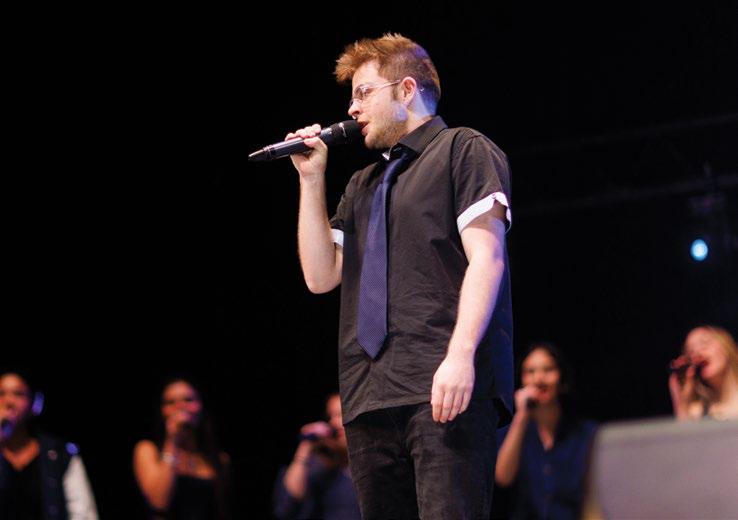
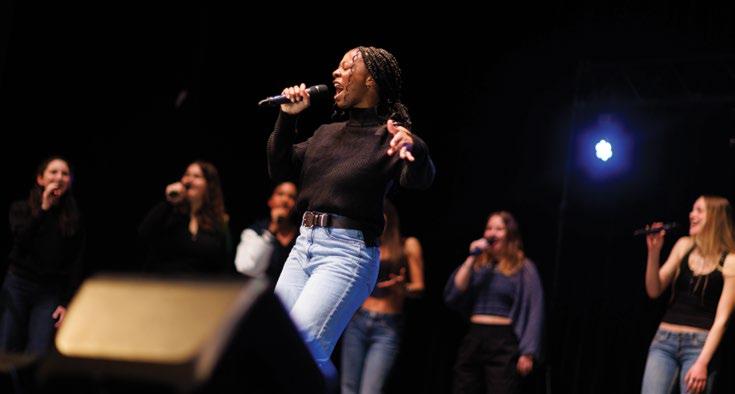
at the heart of what they have been able to accomplish.
“We all have to be incredibly attuned to each other to be able to sing our parts correctly,” he said. “We work really hard and spend a lot of time together.”
Okewole and Garrity both see a cappella in their future. Okewole vows to start a group if one doesn’t already exist at the college she chooses, and Garrity hopes to have time in his schedule to audition for one of his college’s competitive groups. But like Eisenstein, their experience at GFS has illustrated that the a cappella community will be there for them, no matter where their paths lead.
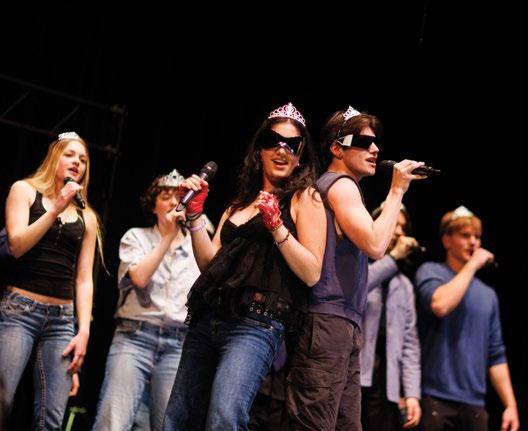
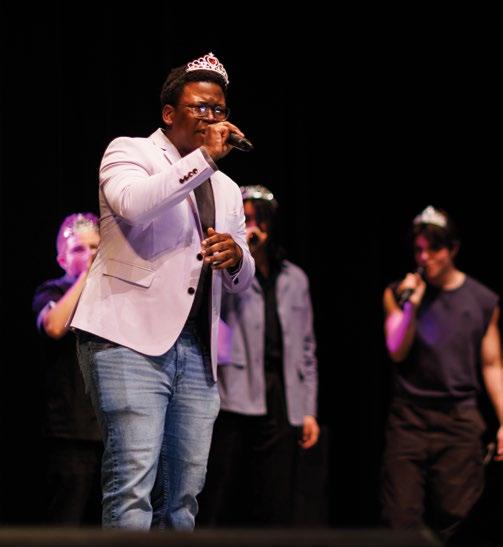
WATCH EISENSTEIN’S A CAPPELLA DOCUMENTARY!
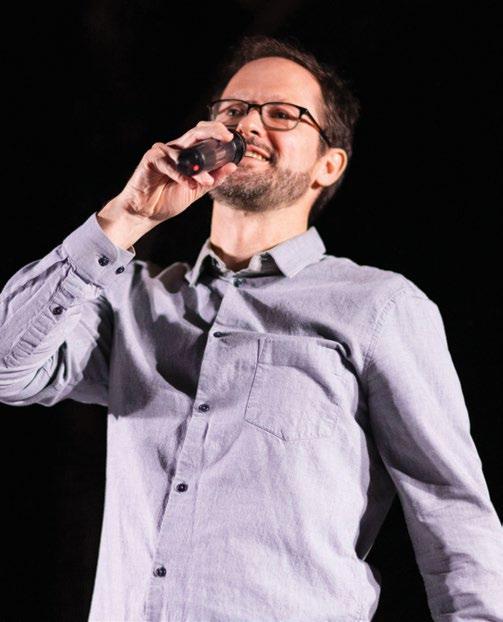
BEHIND THE SCENES OF ‘CHALK CIRCLE’
By Emily Kovach
ALL TOO OFTEN, THEATRE AUDIENCES HAVE NO IDEA THE HERCULEAN AMOUNT OF WORK THAT’S DONE BEHIND THE SCENES TO BRING A PLAY TO LIFE. For a complex play, like the Upper School fall production of Bertolt Brecht’s “Chalk Circle,” this is especially true. The two-and-ahalf-hour show included handmade props and puppets, moveable set pieces, a live band playing klezmer-style music, and the actors transitioning between ensemble and lead roles. The production was powered by a smallbut-mighty student cast and crew and enjoyed a three-day run at GFS in November.
GFS Theatre teacher Geo Decas O’Donnell was the play’s director. He chose this play partially because the Theatre department hadn’t done a modern period play in a few years. The Upper School productions are planned so that students get to experience a wide range of styles
“CHALK CIRCLE” (ITS FULL TITLE IS “THE CAUCASIAN CHALK CIRCLE”) is a play-within-a-play set in the Caucasus Mountains of Georgia about a servant girl, Grusha Vashnadze, who rescues a baby abandoned by the wealthy Governor’s wife during a coup. She must flee her town, and goes on an epic adventure to keep the baby safe from an evil prince who wants to kill him. The play—at times madcap, at others, gravely serious—delivers timely commentary on class structure, compassion, and justice. The themes that emerge from the plot center around caring for the most vulnerable in times of chaos, and building a just society from the rubble of corruption and violence.
and types of theatre by the time they graduate. He also enjoyed the connection the play has to Philly; the professional premiere of “Chalk Circle” was in 1948 at the Hedgerow Theatre in Media, PA.
Plus—O’Donnell just really likes Brecht.
“He’s a playwright and theatre-maker that I’m inspired by, and the play has music and puppetry, which are things I really love,” he said. “Plus, a lot of times modern drama centralizes romance, and I liked that while there is romance in ‘Chalk Circle,’ it’s not the focus of the play; it’s more about moral courage.”
Take a look behind the scenes at the tech and dress rehearsals of “Chalk Circle,” which the students poured their talents and giddy, we’re-so-close-to-opening-night energy into in the days before the show’s debut.
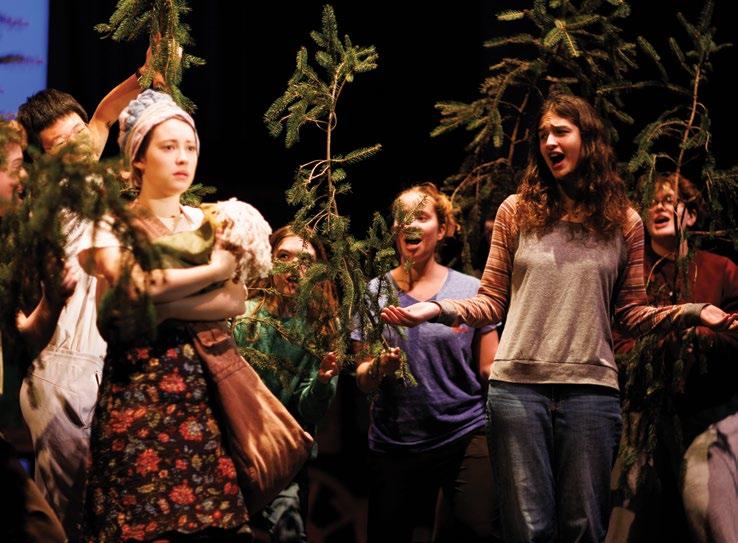
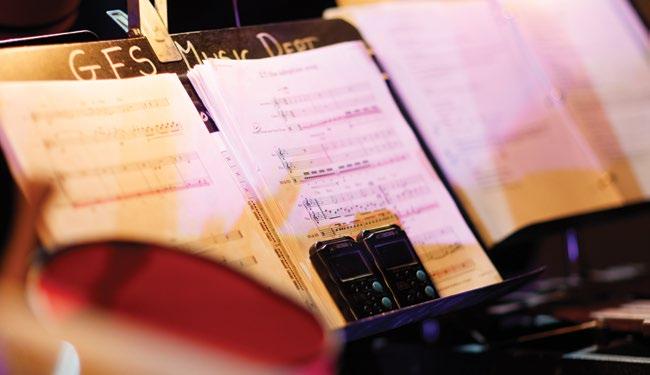
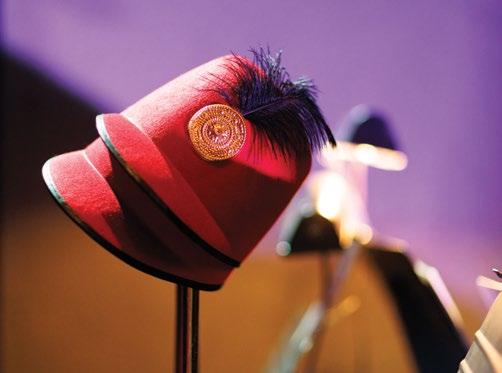
BERTOLT BRECHT’S “CHALK CIRCLE” IS NOT A MUSICAL—IT’S A PLAY WITH MUSIC.
This distinction, explains O’Donnell, is subtle, but meaningful. For one, the play doesn’t come with a set score—O’Donnell used music a friend of his wrote for a production in Manhattan a decade ago. The songs were arranged for
a five-piece klezmer band for the GFS production by local musician, Timothy Hill. The band was made up of four adult musicians from the community and GFS student, Rana Roosevelt ’25.
There are structural differences between musicals and plays with music, too.
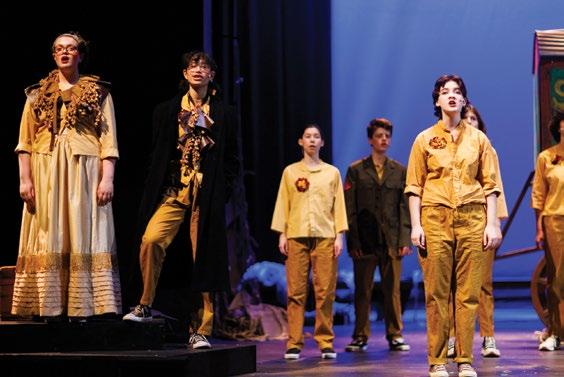
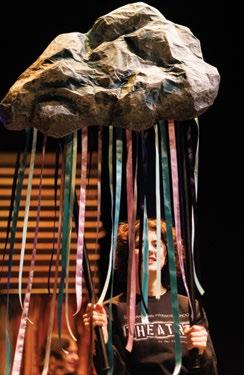
“Anatomically, it doesn’t follow the traditional organization of musicals with big song-and-dance numbers and reprises,” O’Donnell said. “The music there is to lift up a theme, highlight a moment, or explore the interior world of a character.”
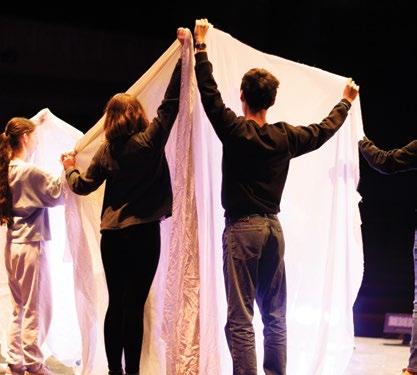
AS THE SCRIPT IS WRITTEN , there’s just one character singing all the songs, but O’Donnell chose not to play it that way. All of the Upper School actors in “Chalk Circle” got to sing together in small groups, as the full cast, and for some, in solos.
BRECHT PIONEERED EPIC THEATRE (later rebranded as Dialectical Theatre), an anti-realist approach which seeks to constantly break the illusion of the stage and remind the audience that they are watching a play.
In GFS’ version of “Chalk Circle”, this was done through the use of puppets, bold humor, actors breaking the fourth wall and announcing scene titles, and making the backstage visible, so the actors could be seen preparing to go on stage.
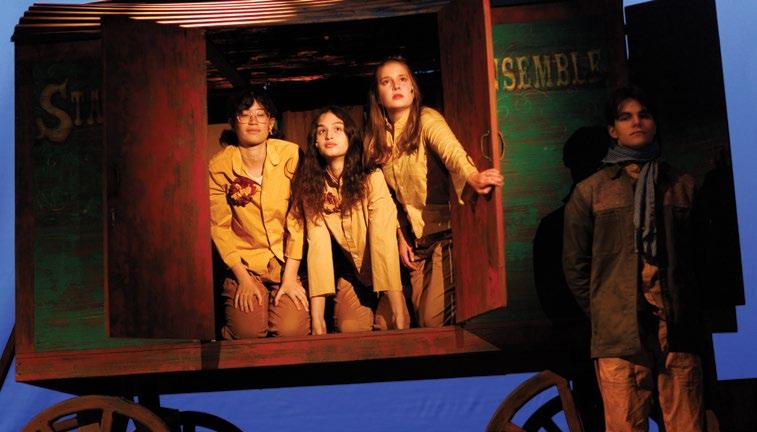
THE SET PIECES FOR “CHALK CIRCLE” WERE DESIGNED AND constructed by the Theatre department’s Technical Director, AJ Tvarok. The centerpiece of the stage design and action was a huge wagon, with different components on each side. The characters could climb on and inside of it, fold different pieces in and out, and wheel it around the stage.
“The wagon was a real challenge. I researched a lot of types of wagons, watched videos about wheel making, and, with my previous building experience, created the wagon piece by piece,” Tvarok said. “Every set design brings new ways for me to problem-solve.”
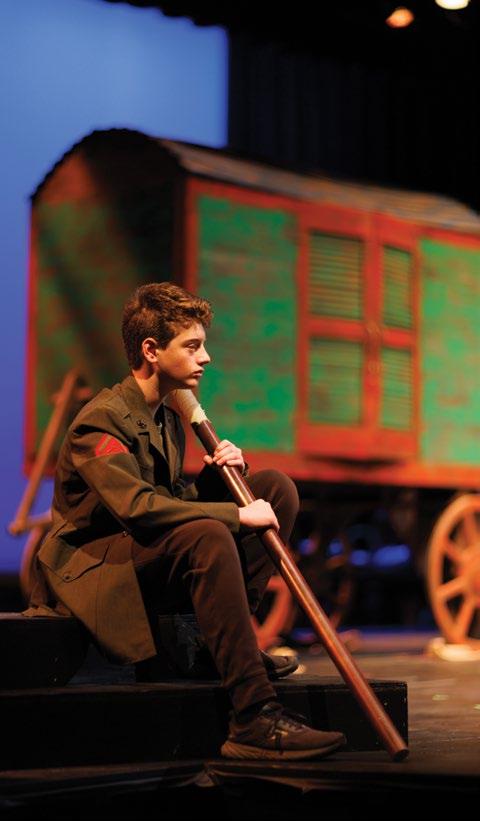
IN ALL GFS UPPER SCHOOL PLAYS and musicals, students help with all aspects of production, from makeup, props, and wardrobe, to the tech side, running sound and controlling the light boards.
For “Chalk Circle,” Rachel Cornejo ’27 (pictured, right) was the assistant stage manager; she helped manage the props and costumes,
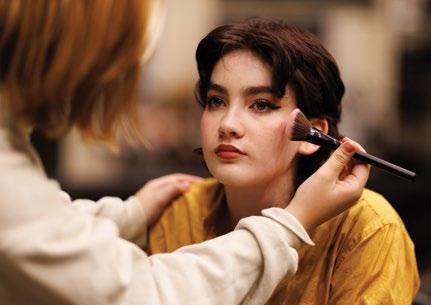
and prepped actors for entrances into different scenes. Cornejo has been on theatre crews for the past two years and enjoys how it lets her be connected to the school’s vibrant theatre community without having to memorize lines or perform (she admits to having a bit of stage fright).
“Being backstage for the whole show is so fun, you’re with everyone and it feels like you’re really a big part of it,” she said. “You can see everyone from the back and you get a glimpse into what it’s like in different moments of the play.”
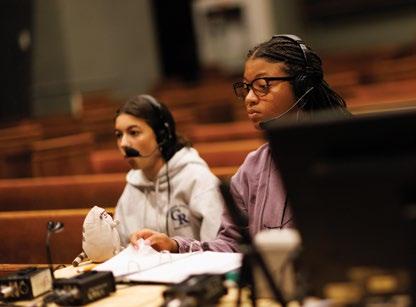
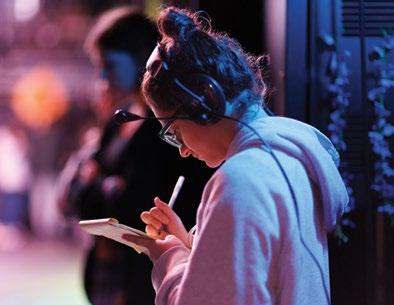
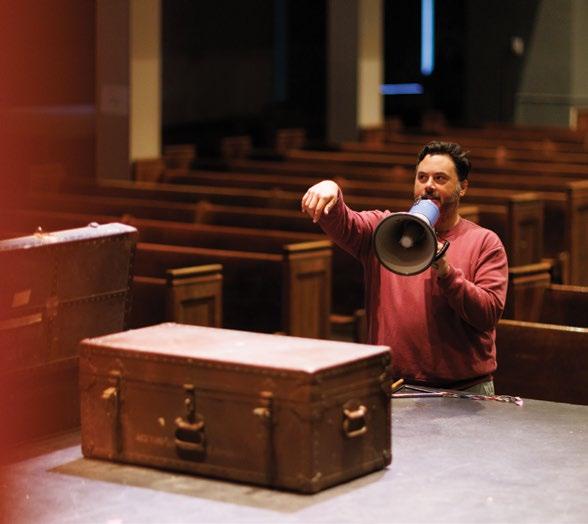
IT’S A LONG AND CHALLENGING PLAY—
“Definitely college-level,” O’Donnell (pictured left) noted.
“Working with students, I focus most on how to act in a play, how to create character, and how to help them find their character’s roadmap throughout the play,” O’Donnell said. “There’s also an emphasis on working on the stamina of doing the whole play, especially in a play like ‘Chalk Circle,’ where there’s so much going on. There’s more time built into rehearsal for that.”
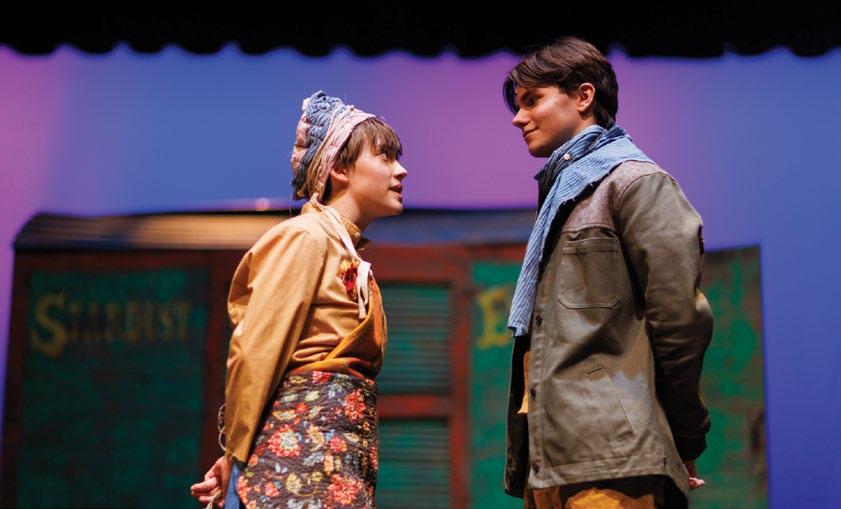
CORALIE LYFORD ’25, WHO HAS BEEN INVOLVED with theatre at GFS since fourth grade, relished the experience of tackling “Chalk Circle.”
“Doing hardcore Brecht and fully committing to it is very unique for high school,” they said. “It shows us that theatre isn’t just big musicals.”
Lyford, who was cast as Grusha (pictured above, with Desmond Jones, ’25 in the role of Simon Shashava), explained that this was the first female character they’ve played.
“Working with Geo, I’ve gotten to explore gender, character, and queerness through characters in an experimental way,” they said.
Lyford, who will be studying theatre at NYU this fall, said they’re grateful for all they’ve learned and were able to try as part of GFS’ Theatre program.
“There’s a ‘We’re making art’ energy at GFS that doesn’t always exist in theatre spaces,” they said. “There’s grit and passion here.”
EXTENDED PLAY
Eight GFS alumni with professional careers in music By
Emily Kovach
MANY OF OUR ALUMNI WHO EXPLORED MUSIC HERE AT 31 W. COULTER STREET CONTINUE TO PRACTICE THEIR SKILLS AND PURSUE THEIR PASSIONS THROUGH LOCAL CHOIR GROUPS, CASUAL JAM SESSIONS, ONGOING LESSONS, AND THE LIKE. Some have gone on to forge careers and make their marks in the competitive, demanding music industry. Here are eight leaders, luminaries, and future legends who can trace their roots back to GFS:
MADISON MCFERRIN ’10
BIOGRAPHY: Madison McFerrin is an independent musician, singer, songwriter, and producer. She blends and defies genres, pulling from acid jazz, soul, funk, R&B, a cappella, and more. Her first EP “Finding Foundations, Vol. 1” was released in 2016; since then, McFerrin has put out two more EPs and a full-length studio album “I Hope You Can Forgive Me” (2023). She has also performed at Lincoln Center, Central Park SummerStage, and BRIC Celebrate Brooklyn, and shared stages with influential artists like De La Soul, Gallant, and The Roots.
GFS MOMENT: Part of GFS A Cappella for three years; “My bread and butter is vocal harmony,” she noted. “So much of that was influenced by being in an a cappella group in high school.”
HIGHER ED: Berklee College of Music
CAREER HIGHLIGHTS
• McFerrin was named a “Rising Artist” by Pitchfork in 2018.
• Her songs have been included in episodes of Comedy Central’s “Broad City” and HBO’s “Random Acts of Flyness.”
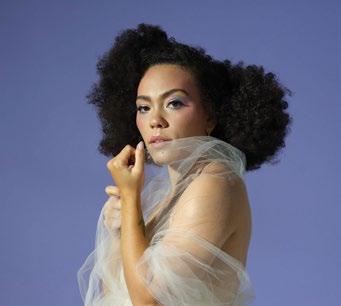
• Her single “Run” was included in Rolling Stone magazine’s “The 100 Best Songs of 2023.”
• A new single “Ain’t It Nice” and accompanying video were released in March 2025.
RECENT GIG: In April 2025, McFerrin performed a set on NPR’s beloved video series, “Tiny Desk Concert.”
BEN THOMAS ’14
BIOGRAPHY: Ben Thomas is an engineer, producer, and mixer who has worked with huge names in hip-hop, including Lil Uzi Vert, Future, Ty Dolla $ign, Nicki Minaj, Chill Moody, and many others. He’s also worked with artists in R&B, gospel, country, and pop music. In 2020, Thomas opened After5 Studios, a Philly-based recording studio, which was in operation through 2024. These days, he is based in Los Angeles, and travels regularly.
GFS MOMENT: Part of GFS’ Jazz Band for four years, he took three years of music theory, and ran sound for plays, assemblies, musicals, and A Cappella Fest in Upper School.
HIGHER ED: Temple University
RECENT GIG: He’s currently engineering for Pharrell Williams, working and traveling with him between Los Angeles, Miami, and Paris.
CAREER HIGHLIGHTS
• Thomas earned his first Billboard #1 in 2020 with his work on the album “Pluto x Baby Pluto” by Lil Uzi Vert and Future.

• He won two NAACP Image Awards in 2018 for his engineering work on the song “Insecure” featuring Jazmine Sullivan and Bryson Tiller, and Brian McKnight’s album “Genesis.”
• He has won two Grammy awards and been nominated for six others. The wins were both in 2022 for his work with the artist Jazmine Sullivan.
• Thomas engineered, mixed, and produced Lil Uzi Vert’s highly anticipated Billboard 200 #1 album “Pink Tape” (2023).

ERIC BAZILIAN ’71
BIOGRAPHY: Eric Bazilian is a multi-talented musician, best known as the co-founder of The Hooters. After coming up through the local Philly music scene in the early 80s, and releasing their first album, “Amore” on an independent label, The Hooters went mainstream in 1985 via their second record, “Nervous Night.” They enjoyed commercial success through the late 80s and 90s, and have continued to record and tour. Bazilian has also released four solo albums: “The Optimist” (2000), “A Very Dull Boy” (2002), “What Shall Become of the Baby?” (2012), and “Bazilian” (2021).
GFS MOMENT: In his senior year, Bazilian formed a band to accompany the Upper School production of “Jesus Christ Superstar”—he played guitar, with Champ Davenport ’72 on bass and Neil Simpkins ’72 on drums.
HIGHER ED: University of Pennsylvania
CAREER HIGHLIGHTS
• Bazilian and The Hooters co-founder Rob Hyman wrote, arranged, and performed on Cyndi Lauper’s debut album “She’s So Unusual” (1983).
• Three songs from “Nervous Night”—“And We Danced,” “Where Do the Children Go,” and “Day by Day”—charted on the Billboard Top 40. The album went double-Platinum.
• In July 1985, The Hooters played at the Live Aid benefit concert in Philadelphia.
• In 1995, while The Hooters were on hiatus, Bazilian produced and arranged Joan Osborne’s Grammy-nominated album “Relish”; he wrote the hit song “One of Us.”
RECENT GIG: On May 17, 2025, The Hooters kicked off their “45 ALIVE” tour with a concert at The Met in Philadelphia.
KELLY ANN BIXBY ’02
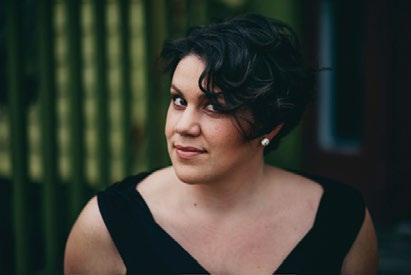
BIOGRAPHY: Kelly Ann Bixby is a vocalist and educator. Her powerful soprano is featured on nearly two dozen albums, such as Opera America’s “New American Songbook” and “Spirits in Bondage” by Benjamin Boyle. She has appeared on prominent stages such as Carnegie Hall, Lincoln Center, Disney Hall, The Kennedy Center, The Muziekgebouw Amsterdam, and the Metropolitan Museum of Art. The Crossing, a contemporary choir ensemble in which Bixby is a core member and featured soloist, has earned a total of nine Grammy nominations and four Grammy awards in the category of Best Choral Performance.
GFS MOMENT: Participated in GFS Choir, Chorus, Orchestra, A Cappella, and musicals.
HIGHER ED: University of Michigan, Westminster Choir College
CAREER HIGHLIGHTS
• Bixby made her 2014 début with Opera Philadelphia in Golijov’s “Ainadamar.”
• She was named the Eastern Region Artist Award Winner in the National Association of Teachers of Singing Competition, also in 2014.
• The Crossing was named Musical America’s Ensemble of the Year in 2023.
• In February 2025, she performed in an octet with the Boston Symphony Orchestra.
RECENT GIG: Bixby currently serves as Assistant Professor of Voice at the University of Louisiana at Lafayette where she teaches undergraduate and graduate courses in Italian, German, and French diction, voice science, song literature, and choral methods.
JOSEPH BLOCK ’17
BIOGRAPHY: Joe Block is a pianist, composer, and musical director. Classically trained since the age of two, he shifted his focus to jazz at 13, studying at the Philadelphia Clef Club of Jazz and Performing Arts. While still a student at GFS, he received national recognition as a YoungArts Foundation Finalist and won the J. Douglas White Award from Jazz at Lincoln Center. Now based in New York City, Block is in high demand, performing in over 10 countries and at prestigious venues such as Carnegie Hall, Lincoln Center, and the Village Vanguard. He leads his own trio, quintet, and big band; he was named a Steinway Artist in 2024.
GFS MOMENT: Block studied classical composition privately with Dr. Andrew Westerhaus; he wrote incidental music for an Upper School production of “Don Carlos.”
HIGHER ED: Columbia-Juilliard dual-degree program
RECENT GIG: Block was the Assistant Musical Director and pianist for the Broadway production of “Good Night, and Good Luck,” with George Clooney playing Edward R. Murrow, which played at the Winter Garden Theatre in New York City through June 2025. He also released his second album, “Solo Piano, Vol. 1” in the summer of 2025.
GARRETT DUTTON ’91
BIOGRAPHY
Garrett Dutton is the frontman of G. Love & Special Sauce, an alternative music trio that pioneered the “hiphop blues,” a genre melding Delta blues, rock and roll, soul, hip-hop, and funk. The band’s debut, the self-titled “G. Love & Special Sauce” (1994), included heavy rotation of their hit single “Cold Beverage” on college radio stations and MTV, and appearances at festivals like Lollapalooza and Bonnaroo. Over the decades, G. Love has performed across the world and released 19 subsequent albums, including: “Coast to Coast Motel” (1995), “Yeah, It’s That Easy” (1997), “The Electric Mile” (2001), “The Juice” (2020), “Philadelphia Mississippi” (2022), and “Fishin’ for Christmas” (2024).
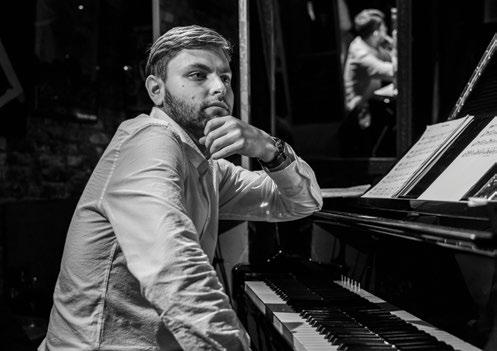
CAREER HIGHLIGHTS
• Block performs with Wynton Marsalis, Kurt Rosenwinkel, Leslie Odom Jr., George Clooney, and many more artists of note.
• He was a finalist in the 2023 Herbie Hancock Institute of Jazz International Piano Competition.
• He is a frequent musical director for Jazz at Lincoln Center, who has named him one of “jazz’s most promising young composers.”
• Block released the album “Love Shadows” in January 2025 with vocalist Shabnam Abedi.
GFS MOMENT
In 2021, Dutton joined GFS’ 175th celebration during the pandemic with a video performance from the road.
HIGHER ED
One year at Skidmore College (left to pursue music in Boston)
CAREER HIGHLIGHTS
• G. Love & Special Sauce signed a record deal with Epic Records in 1993. Their debut album went on to be certified Gold.
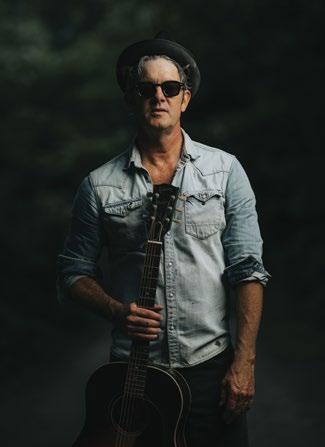
• In 2020, “The Juice” was nominated for a Grammy award for Best Contemporary Blues Album.
• G. Love is a frequent collaborator; he’s worked with artists such as Lucinda Williams, Jack Johnson, Donovan Frankenreiter, and Keb’ Mo.
• In early 2025, the band celebrated the 30th anniversary of the “Coast to Coast Motel” album with a U.S. tour. They continued touring for much of the spring and summer, opening for the indie roots band, Dispatch.
RECENT GIG
On July 4, 2025, G. Love & Special Sauce performed at the iconic Stone Pony Summer Stage in Asbury Park, New Jersey.
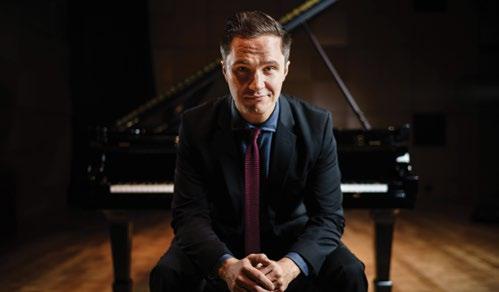
BEN PATERSON ’00
BIOGRAPHY: Ben Paterson is a jazz pianist and organist who has garnered international acclaim for his artistry and musicianship. Now based in New York, he has recorded and released nine albums, and frequently plays live in NYC, Chicago, and around the world; he’s opened for both Steely Dan and B.B. King. Other notable collaborations include Houston Person, Bobby Broom, Johnny O’Neal, and Red Holloway, among others. He also teaches video courses and private lessons on blues and jazz piano improvisation techniques.
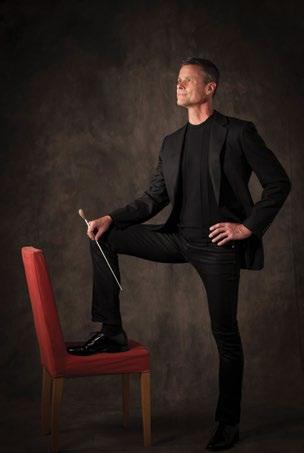
GFS MOMENT: Performed with the Bulgarian Rhythm Kings jazz ensemble in Upper School; was the first student music director and conductor for the Bernstein musical “On The Town” in his senior year.
HIGHER ED: University of Chicago
CAREER HIGHLIGHTS
• Paterson was part of NEA Jazz Master Von Freeman’s band from 2005 until Von’s passing in August 2012.
• He was the first-place winner of the inaugural Ellis Marsalis International Jazz Piano Competition in 2018— the judges included Ellis and Branford Marsalis, Arturo O’Farrill, and Jon Batiste.
• He played piano on the 2023 Grammy award-winning record “Linger Awhile” by Samara Joy.
• Paterson’s newest record “Cookin’ in the Couve” (2024) is a combination of original compositions with some of his favorite blues-heavy standards.
RECENT GIG: In April 2025, Paterson played a series of shows with jazz vocalist Catherine Russell in Paris and Milan.
DAVID CHARLES ABELL ’76
BIOGRAPHY: David Charles Abell is a conductor of contemporary opera, musical theatre, and orchestra music. His career has taken him across the world to famed venues like the New York City Opera, the London Philharmonic, Hong Kong Philharmonic, and the Théâtre du Châtelet in Paris. Abell is a renowned interpreter of Stephen Sondheim’s musical oeuvre.
GFS MOMENT: Abell attended GFS from Kindergarten through sixth grade (he is an honorary alum) where he played trumpet before switching to viola.
HIGHER ED: Yale University, the American Conservatory in Fontainebleau, The Juilliard School
CAREER HIGHLIGHTS
• Abell made his professional debut in 1982, conducting Bernstein’s “Mass” at Deutschlandhalle in Berlin, Germany.
• He became one of Leonard Bernstein’s last protégés in the late 1980s.
• In 2010, he conducted the BBC’s 25th anniversary concert of “Les Misérables” at London’s O2 Arena.
• Abell has worked with big names like Judi Dench, Emma Thompson, Idina Menzel, and Josh Groban on both stage and screen.
RECENT GIG: In April of 2025, Abell came out of a two-year sabbatical to conduct Bernstein’s “Candide” at the Forrest Theatre, part of the Curtis Institute of Music’s Centennial performance season. He will conduct “The Pirates of Penzance” for Seattle Opera in September and Sondheim’s “Follies” in Strasbourg in the spring of 2026.
We didn’t forget about Santigold! Turn to page 48 where you’ll find her as the subject of our featured Alumni Q&A.
SCAN HERE TO LISTEN TO OUR ALUMNI MIXTAPE
WELL COMPOSED
Students in GFS music composition classes revel in creativity and explore musicality, from beginners to the Broadway-bound
By Kyle Bagenstose
ON A GRAY DAY IN EARLY APRIL, WHILE UPPER SCHOOL STUDENTS FILTERED INTO MUSIC TEACHER SHAWN HENNESSEY’S “ DIGITAL MUSIC ” CLASS, A MUSIC VIDEO PLAYED ON A PROJECTOR SCREEN. In it, a young man with shoulderlength blond hair and a fuzzy cardigan sweater sat on a stool, strumming a guitar and crooning into a microphone.
“Does anybody know who this is?” Hennessey asked as the students took their seats.
“Kurt Cobain?” one replied.
Yes, Hennessey answered— the video was from infamous grunge band Nirvana’s 1993 set on “MTV Unplugged.”
As Cobain and the rest of Nirvana worked through “About a Girl,” Hennessey instructed each student to turn on the keyboard in front of them and urged them to pay attention to the power chords which enabled the band to swing between major and minor keys. As he picked up a guitar and strummed, he encouraged them to follow along through the progressions on their keys.
“Watch the power chords here,” he said. “See how the song gets moody really fast?”
This type of conversation might typically be reserved for advanced music students. But Hennessey's music composition class is made up of seasoned musicians and newbies alike. The learning taking place is part of an intentional effort at GFS to ensure that every student is exposed to music, and offered opportunities to create their own, regardless of their ability as an instrumentalist.
“One of the things we try to do in this great institution is help students
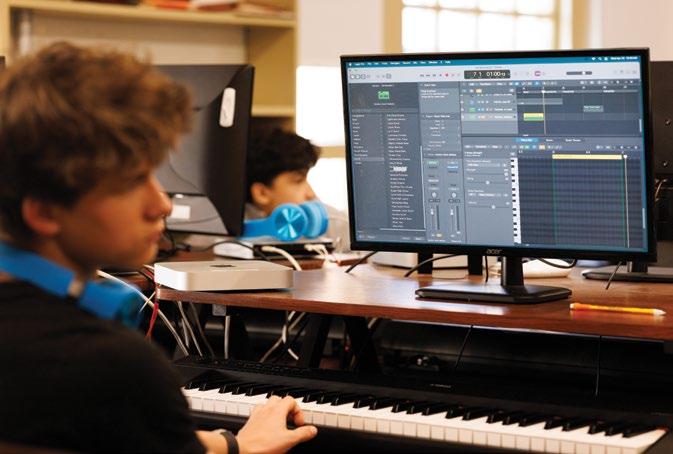
recognize the ways in which they have agency,” said Brian Bersh, head of the GFS Music department. “And the creative process is such a beautiful way of recognizing that agency and developing a sense of self-efficacy.”
STRIKING A CHORD
Dr. Andrew Westerhaus, a music theory teacher at GFS, has witnessed a changing music curriculum in his 11 years in the Upper School. Previously, all students were required to take a music class in ninth grade. But that stretched faculty thin and lumped students with basic and advanced musical skills together.
So about six years ago, the department modified the requirement to allow students to take two semesters of music classes at any point over their four years. Faculty expanded the curriculum by adding new classes, particularly those designed to help students make their own music. To
include everyone, regardless of skill level, courses such as “Songwriting” and “Digital Music” were introduced, which allow students with limited prior instrumental or choral experience to engage with and understand music.
At the end of each school year, the work produced in music creation classes crescendos at the Composer’s Assembly, where students showcase original works, regardless of their skill or chosen media.
“It varies by interest,” Westerhaus said. “We’ve had different kinds of ensembles, like string quartets, or sometimes it’s electronic music that students have written. In more recent years we’ve had a lot of students interested in film music, so sometimes we’ll be presented with original film scores.”
In addition to expanded offerings in the Upper School, Bersh says music faculty also introduce composition work in the Lower School as one component of the general music class. In
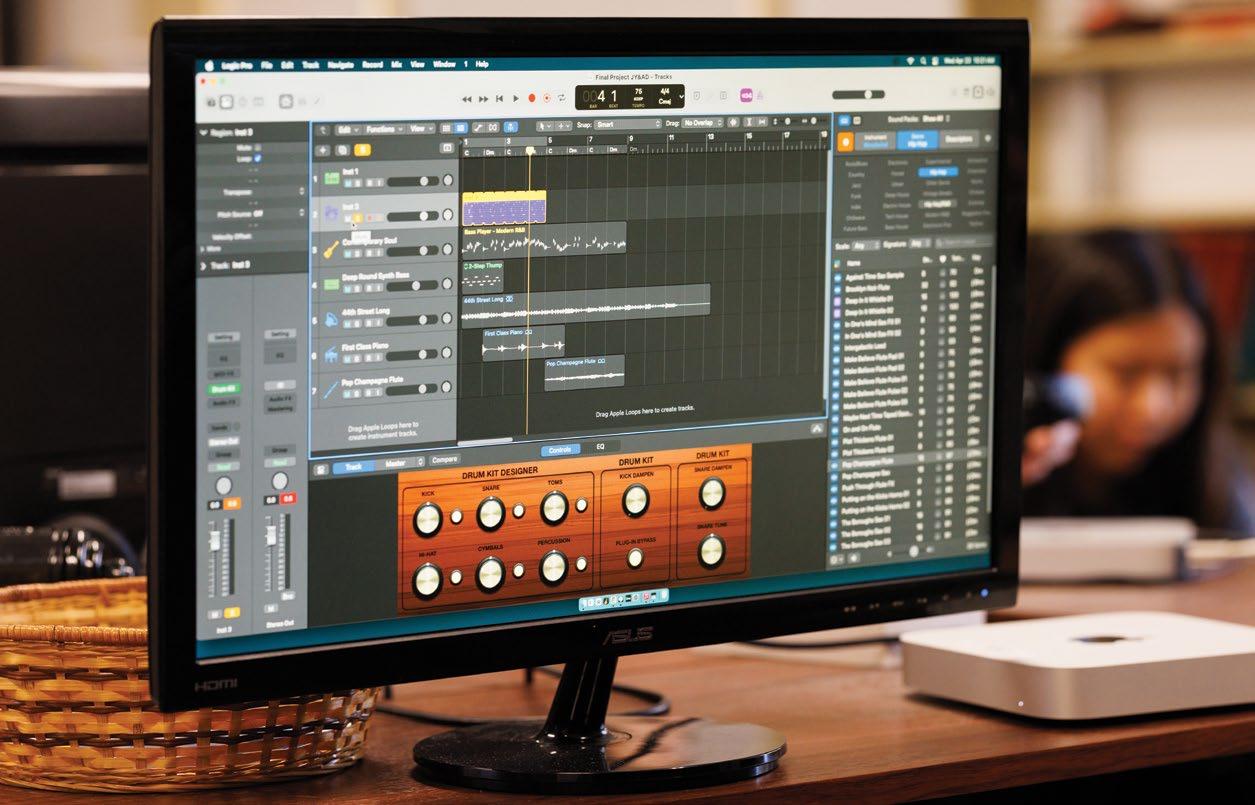
Middle School, “Composition” is one of the classes seventh grade students can choose from as part of their music coursework.
“This cross-divisional progression creates a throughway that sets up our students to excel,” Bersh said. “GFS students learn about making music in formal settings with ensemble directors, and in informal studentdirected ways that will be so important for their continued participation in music, either for their own benefit, solo or with peers, and in whatever community they choose to tap into as they move forward.”
INSIDE THE MUSIC
The foundational premise of Hennessey’s music composition class is that one doesn’t need to know how to play an instrument to create music. This philosophy opens the door for a broader cross-section of the student community to explore their artistry and grow as musicians.
“I think the top goal for us as teachers is that everybody leaves school loving music, whether they want to start creating their own music or just want to be lifelong listeners,” Hennessey noted.
In Hennessey's classes, students start with the basics: the components of a song, what a chord is, how to use a keyboard, and the Soundtrap software they will use to produce music. Then, they progress through various projects and genres. One week, they might break down a Bob Dylan song, and a few days later, produce a hip-hop beat. The penultimate assignment asks them to cover a song of their choosing, in any format of their choosing.
For their final project, it’s their turn to create a wholly original song that could be performed at a student coffeehouse or submitted for consideration to be performed at the Composer’s Assembly.
“Every kid leaving [this class] is going to have a baseline understanding of how music and songwriting work,” Hennessey said.
Of course, some students want more. Bersh takes pride in the scope of the Upper School’s offerings: 12 teachers running about two dozen music classes with student access to nearly 20 private lesson teachers offering one-on-one instruction. And that is in addition to the music faculty in Middle and Lower School and Early Childhood. Upper School course offerings include plenty of traditional opportunities such as jazz ensemble, chorus, and orchestra, and have also expanded to include “World Percussion” and “Chinese Instrument Ensemble.”
The department has also worked to give advanced students venues to further their own music. Westerhaus, who holds master’s and doctorate degrees in music theory, notes that music theory and composition classes
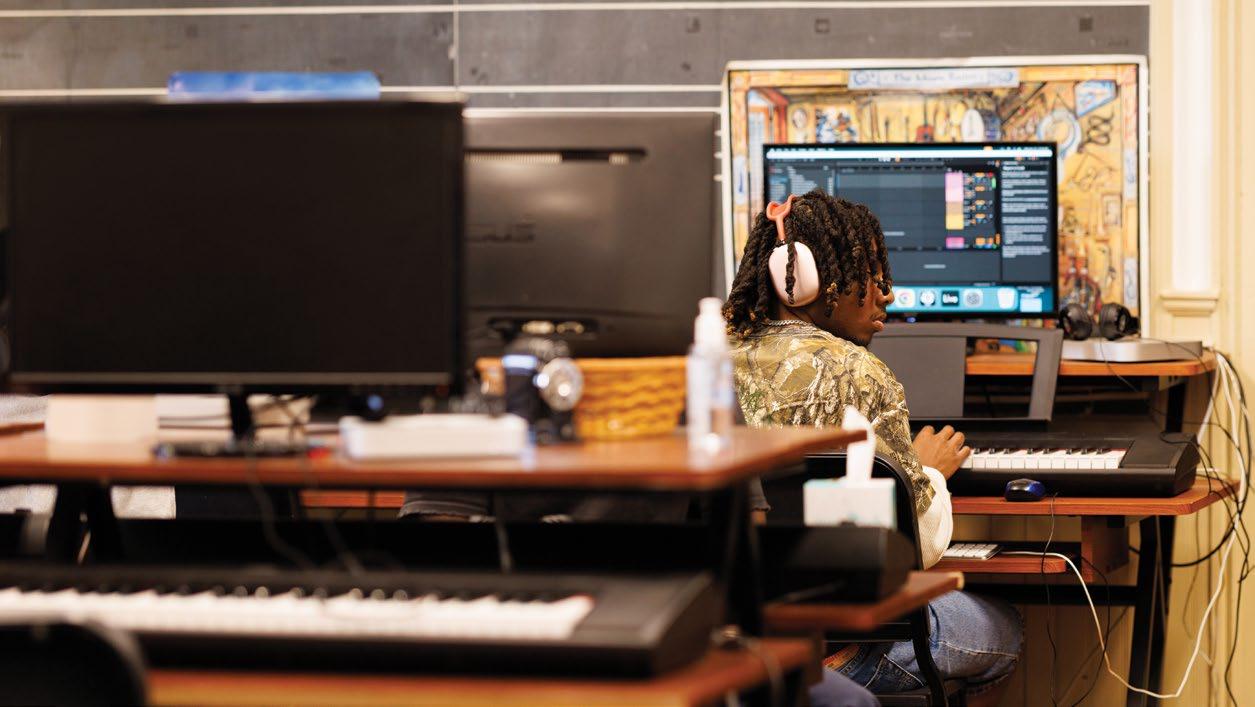
offer robust opportunities for students to sharpen their competency.
In these classes, students begin by studying advanced concepts and techniques on their instrument of choice. By the second semester, they’re writing their own music and building toward a longer, original piece that they’ll also share at the Composer’s Assembly.
These can result in full-on productions, with the composers enlisting the help of other players to bring their music to life.
“It’s one of the highlights of the year,” Westerhaus said. “It’s a great showcase of the creativity and skill these kids have.”
FINE TUNING
Joe Block ’17 is one of the school’s most successful recent graduates in the music industry (see pg. 38). And he says that’s in large part due to the creative opportunities he encountered here.
“So many of the things I’m now doing professionally involve musical direction, composing, or arranging,” Block said. “I got a really great head start at GFS.”
By the time he arrived at the Upper School, Block was already an advanced musician, studying at the Philadelphia Clef Club of Jazz and Performing Arts and working as a professional musician around Philadelphia. In ninth grade, he leaned into the program’s compositional offerings, starting with “Advanced Music Theory” taught by former GFS instructor, Duane Large.
“That was great for learning the fundamentals: counterpoint, harmonization, Roman numerals, rhythmic dictation,” Block said. “It helped me to actually place out of those classes in college.”
As a sophomore, Block successfully proposed a Directed Independent Study (DIS) in musical composition with Westerhaus, studying classical composers such as Stravinsky, Beethoven, and Debussy. In the DIS, some of his projects included composing incidental music for the Upper School production of “Don Carlos” as well as a choral piece for the Upper School Choir based on Winston Churchill quotes. For his senior year capstone, Block chose to play interpretive jazz piano as a
silent movie rolled on screen during a school assembly.
After graduation, Block earned bachelor’s and master’s degrees from the prestigious Columbia-Juilliard dual-degree program in New York City and began a career as a jazz musician. He’s served as the associate musical director and pianist for George Clooney’s Broadway show, “Good Night and Good Luck,” applying many of the same skills he began building at GFS.
Of course, not every music student is going to end up on Broadway like Block. Hennessey frequently reminds his students that creating art has many purposes. During one class, while handing out a reading assignment, he urged students to consider the author’s meditations on the differences between creating music for oneself and creating it for others.
“Writing songs or poetry—doing any kind of art for yourself—is awesome,” Hennessey told them. “It’s therapeutic. It’s good for you. It’s good for your soul.”
Above, and previous pages: Upper School students in the “Digital Music” class use programs like Ableton Live and Soundtrap to write original songs.
CLASS NOTES
Let’s stay in touch!
Please visit germantownfriends.org/alumni/submita-class-note to share life updates, career moves, or any other kind of news, with the community.
JOIN THE GFS COMMUNITY ON SOCIAL MEDIA!
1949
JOAN KENNEDY-BERKEY says, “Ted and I continue to live a quiet life on the Downeast Coast of Maine. We love the solitude.”
1950
FREDERICKA BERGER writes, “Thank you for the excellent tribute to Irvin Poley [in the Winter 2024 Bulletin]. I have been a disciple, teaching ‘drama ministry,’ mindful of ‘that of the actor in every individual.’”
1953
ROBERT ISRAEL says, “Thanks to my GFS education, I’m still going strong at 89 years old as a professor and OB/GYN at Keck School of Medicine at USC! Fight on!”
1954
EDITH MOORE writes, “A documentary on CBS showed our circa-1829 farm ‘Mooreland’ in West Tennessee. A moving story.”
MORRIS WOLFF has written three books: “Whatever Happened to Raoul Wallenberg?” which has been published in English, French, German, and Spanish; “Lucky Conversations: Visits With the Most Prominent People of the 20th Century;” and “History’s Right-Hand Man.” In 2025, Wolff was the recipient of the David A.B. Brown, ΕΦ ’66,
Distinguished Alumnus Award, which is bestowed upon an alumnus of Psi Upsilon for bringing honor to the Fraternity by exemplifying the true spirit and meaning of brotherhood and moral leadership.
1955
SAM SMITH says, “I remain a journalist 70 years after graduating from GFS. The other day I asked myself: If I had to choose between having gone to Harvard (as I did) or GFS, which one would I take? In five seconds I came up with GFS. It not only taught me how to write but how to be a human.”
1956
Each month, weather permitting, SUSAN PRICE and other Class of 1956 ladies who live locally meet for lunch: GRETCHEN VAN DENBERGH , BEVERLY WILDE , LIZ THOMAS , GAIL SNITZER , SALLY STREHLE , and SUZANNE SCHNEIDER
1957
NANCY MYERS shares that on New Years Day at noon, eight members of the class of 1957 met on a Zoom call. “ DEBORAH CHURCHILL GOODELL set it up and JUDY TATTERSFIELD
SANDORF, MARILYN MARTIN FRICKER , CAROLYN SCOTT
HOEHN, KAREN ROSENWALD GUNDERSHEIMER , SANDRA
IN MEMORIAM
1946
DOROTHY B. BERNER November 19, 2024
E. CROSBY WILLET September 28, 2024
1948
MARILU ALDRICH MAYER December 15, 2024
1949
NANCY MAY COPPLE January 14, 2025
1950
RICHARD KNIGHT TAYLOR October 15, 2024
1951
RICHARD DUGGER March 17, 2025
MARY AGNES HERSHEY September 21, 2024
JOAN HERGESHEIMER HORN September 28, 2024
1952
ANNE DOBERSTEIN MOYLE November 29, 2024
IN MEMORIAM
1954
WILLIAM FELIX
December 24, 2024
ALAN L. LOUDERBACK
January 27, 2025
LEWIS ROSEWATER
March 11, 2025
DONALD N. WILKIE
September 28, 2024
1958
BENJAMIN G. NEWMAN
November 13, 2024
1959
JANE SHEPPARD HARPER
January 24, 2025
1960
DEBORAH BLAIR HILL
April 13, 2025
SARAH L.O. SMITH
January 4, 2025
1961
SUSAN SHEPPARD ARRISON
February 15, 2025
JANET HALLSTROM SCURRIA
March 7, 2025
1962
ANN D. GORDON
March 19, 2025
EATON LENTZ , FRANCES BLAIR and I were seen and heard. MILLICENT LELL VETTERLEIN heard us. CAROL THOMAS NEELY, SUSAN FOSTER , and MEREDITH SMITH were with us in spirit. Lovely way to start a new year.”
1959
PEGGY MINEHART is enjoying good health living in Center City Philadelphia. “Hello to all!”
1960
BARBARA PARRY says, “Having missed our 60th reunion, we really looked forward to our 65th!”
1961
KIRK SCHABACKER is still in New Jersey and is enjoying retirement. “Three kids, eight grandkids, three great-grandkids— life is good.”
1962
JOHN MCKOY continues to travel, mostly in the U.S. “I’m toying with writing a fourth novel, playing some golf, enjoying a book club, and considering moving to a life care community.”
1965
ELEANOR HOBBS shares, “My sister, LAURA JANE THOMAS STEVENSON ’59, died last July, a poignant reminder to seize every opportunity to reconnect with friends.”
1966
Two years ago A. BOUNDS downsized to a smaller house right down the street. “We’re still looking for stuff we ‘purged’!”
1967
L. ROBERT COLLINS is “still volunteering, teaching (part-time), running, and fulfilling my literary experiences requirement. Thank you, GFS.”
1968
CAROLYN WILHELM is “living where the Cascade Mountains meet the Columbia River Gorge, happily doing the drawings for ‘The Dream Ranger’ book series about helpful dogs!”
1969
MARIE WILKES is very grateful for her GFS education, “especially having spent several years with Mary Lou Scull in the Art department.”
1971
CATHERINE STINE (CHUMLEY ) (below) has been writing up a storm. “I have three books out in a female-led detective series, ‘Sleuths of Shadow Salon.’ The first one, ‘Guardian of Monsters,’ was also released as an audiobook in May! I have a story, ‘Grigoriy’s Army,’ in an alt-history anthology, ‘Combat Monsters: Untold Tales of World War II,’ out with Blackstone Publishing. In the fall, my story, ‘Murder in the Voodoo Vault,’ will launch in an urban fantasy collection with Penguin Books.”
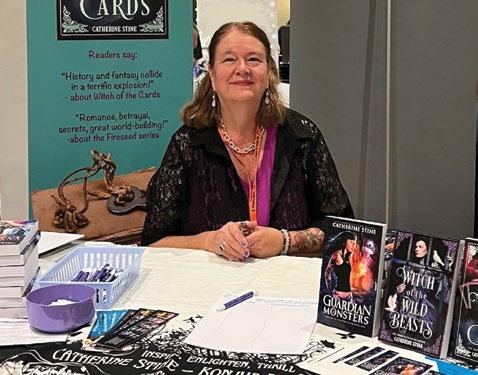
1972
KARINA SCHLESS was “off to Italy again (Rome, Bologna, Verona) in May 2025. I’m still looking for my next American Quarter Horse and excited for my upcoming trip to Wyoming this September.”
1973
N. BRUCE YAGER writes, “Wonderful to catch up at my 50th reunion. So great to gather at KEN HELLENDALL’s and JOHN SAWYER ’s home, and to see THADDEUS GOVAN at the Philadelphia Museum of Art.”
DAVID B. REIFSNYDER (below, left) is the Director of Therapeutic Activities at Complete Care in LaPlata, Maryland. When he’s not working, he competes in disc golf. “I recently won the PDGA MA70 in Puerto Rico (division for 70–74-year old men), with a global rank of 106, and competed at Worlds Amateur Disc Golf Championships held in Kansas this year. I also qualified to compete at the 2025 Disc Golf Championships in Minnesota. Ironically, I’ve been nicknamed ‘Reify’ by local disc golfers who didn’t realize this was the nickname of a popular and loved GFS history teacher from 1962–1996. I live on five acres on the Western shores of the Chesapeake raising chickens, a teenager, and a couple hives of honeybees. We would welcome any GFS alumni to our home, and I can introduce you to the exciting sport of disc golf.”
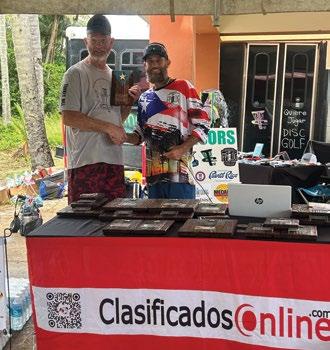
1974
MARJORIE MEYERS writes, “After almost 40 years as a public defender, I retired in August. Looks like I’ll need to keep up the fight as a volunteer.”
CAROLINE KANE WESTON ’s family hosted a 100th birthday celebration for her mother, Maggie Kane, in her backyard in Piedmont, CA. (Pictured below with three of her children: Nevan, Carrie, and Lachlann). Maggie was an administrative assistant in the Lower School from 1969 to 1971. The Kane family left GFS when they moved to California in 1972.
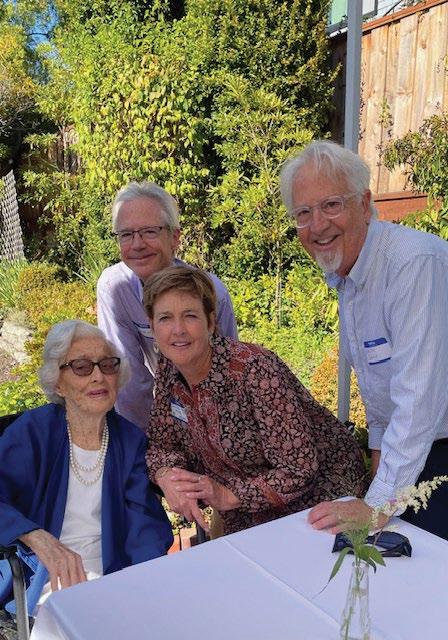
1975
MALCOLM MCHARG and RACHEL SCHADE both wrote in to say how much they were looking forward to their GFS 50th reunion in May 2025.
After coming to Alumni Weekend, McHarg said, “I was reminded at our 50th how much GFS in general, and my classmates in particular, motivated, challenged and inspired me. I still feel enriched by the experience and look forward to the next reunion.”
IN MEMORIAM
1963
JOHN F. DUGGER
April 26, 2025
1964
GEORGE C. DEHNE
January 19, 2025
1965
WILLIAM T. COLEMAN III November 17, 2024
1968
LUCY B. NATTRASS April 13, 2025
1973
CHRISTINE E. HOPKINS October 1, 2024
1990
MATTHEW B. TAYLOR March 27, 2025
1976
AMY BERNHARDT writes, “My husband and I are thoroughly enjoying ourselves on Deer Isle, and are especially grateful for the community, connections, and rhythm of rural island life. Doug is still practicing architecture, and with our son Ryan, built an Annapolis Wherry at the Wooden Boat School last summer. I absolutely love cooking with local foods (some homegrown), and though late to the sourdough game, I am addicted to it now! Painting in my studio is a daily salve for the woes of the world, and I am fortunate to supply two galleries with my work. Best news of all, we became grandparents to a baby boy (born to daughter Halle and her husband Rob) one month ago, and are expecting a granddaughter (son Ryan and his wife Alex) in a mere few days!”
ANN OSBORN is celebrating her 25th year as a natural medicine kinesiologist. “Looking forward to our 50th reunion next year (2026).”
1978
MARKO MAGLICH says, “Brenda and I moved to Boston last year. I saw that there was a Boston alumni/ ae meeting around the corner from us in the North End in November. Please have it at the same place next time so that I can walk to it, and hear about Abby’s and Oxfam’s work! Always grateful for the education and the community, and the opportunities that flow from it. I wish more could have what we got.”
1980
CONSTANCE YOUNG (below) reports, “Yet another new career. I have moved from the Bay Area to my family’s farm in upstate New York, near Cooperstown. We are certified organic and fully regenerative. We raise grass-fed and grass-finished Piedmontese cattle. If you are interested in learning more, you can visit our website, otsquagocreek.com. Looking forward to joining my classmates at our 45th reunion this May.”
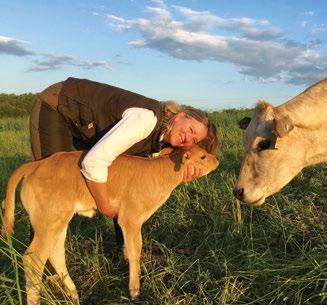
1981
B. THOMAS HOPKINS says, “My sister, CHRISTINE HOPKINS ’73, passed away in October. Several of her GFS classmates attended her service. It was a reminder that the GFS family is there long after graduation.”
1986
ANDREW FRIEDMAN reports, “As a Cornell alum, I am very proud (and poor) that we currently have two kids studying mechanical engineering at Cornell. I know for certain that I would not be admitted today! Our daughter graduated in 2025 and was off to Salt Lake City to work for a biomedical device company. Our son is a sophomore who plans to go into aerospace engineering. Empty nesting will have to wait as we have another son just starting high school in the fall of 2025. Upon our son’s high school graduation, retirement will somehow be nearing and we plan to spend a lot of time in Canada. My wife is Canadian and for some reason she really wants to move back home. We have a cottage in northern Ontario and would love visitors. Our 25th wedding anniversary was in June!”
1996
GABRIEL WICK shares that while he is still Paris-based, he is curating an exhibition this summer at Middlebury College, Vermont. “The Petit Salon: the journey of an 18th century paneled room from Paris to Middlebury” will run from June 27–December 15, 2025.
1998
AMANDA LANE SHIELD is currently working as an Education Field Administrator in the Office of Early Childhood Education for the School District of Philadelphia. She lives in Erdenheim with her husband of 21 years, David, and her three children Chaney (14), Jovie (11), and Piper (9).
2003
JENNIFER CHU recently became the Annual Fund Director for Friends’ Central School. “My husband is a teacher there and both of our kiddos (Maya, 5 and Isaiah, 3) are enrolled in PreK and Nursery respectively. I know I’ve crossed over but I always secretly cheer for the Tigers!”
2008
AN TRAN (below, right) is a mailman now and has been thinking a lot about the Germantown neighborhood, and how it has changed in small and large ways since he came here with his family in 1997. “A lot of the old grassy empty lots I used to play in or build snowmen on have big luxury condos on them now. Some of my neighbors have more wrinkles on their faces now. There’s apparently a huge new annex to the old theatre building on GFS’ campus. And still, many things stay the same. There are still fish in the pond on the grounds of my church after all these years. The crossing guard that guided my sister and me across the street still maintains her watch to this day. Sometimes I think people have the impression that Germantown’s heyday is behind it; but truthfully, if I’m able to glean a sliver of the beauty that comes out of this neighborhood, I think there’s a lot to look forward to.”
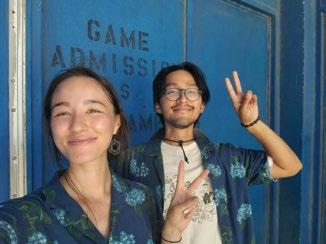
2009
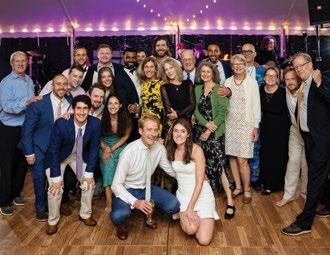
KYLER LODER and Allison Callahan were married this past September in Philadelphia. “We were in the company of a wonderful group of GFS alumni, which included BEN ROGERS ’11 , REISS WOLF ’09 and TYLER WOLF ’11 , EDDIE EINBENDER-LUKS ’09, MARK LODER ’70, DAVID LODER ’72 , TOM LODER ’76, KAREN LODER ’74 , MAREK LODER ’07, JULYA LODER ’11 , AARON LODER ’18 (unpictured), DANNY LODER ’20, JACK KOEHLER ’09, DANIEL FEINGOLD ’09, ZOE FEINGOLD ’11 , MAX HAWES ’07, ERIK FEDERMAN ’09, NADYA SHMAVONIAN ’78, KARL SHMAVONIAN ’80, MOLLY SILVERMAN ’72 , DAVID GOULD ’07, ANNE RHOADS ’78, KATE WILLIAMS ’00, and ALEX BEZAHLER ’09 (unpictured).”
2012
JULIAN PLOTNIK says, “A few years ago, I convinced my boss to let me—and eventually the whole company—switch to a four-day workweek. Now my organization, 4 Day Philly, is working to promote four-day workweeks as a vehicle to improve Philadelphia’s economy and work culture. My journey has been covered by local news outlets including The Philadelphia Inquirer, and I hope to continue making an impact in the city in the future!”
2013
KHARI GOOSBY (below) reports, “I just had my first child, Amara Lynne!”
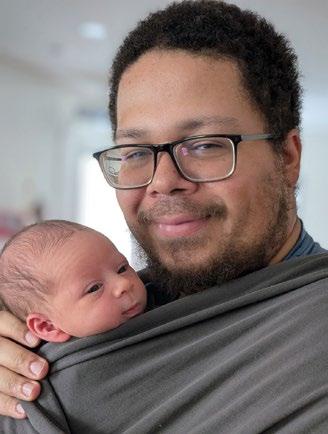
2016
NIGEL LAW says, “In 1948, when my grandfather Jerry was a senior at Germantown Friends, he learned to play the Schumann piano concerto, and performed its first movement with his father at a GFS assembly. It took me the better part of a year, but I recently learned the same part he did—from the same, disintegrating manuscript—while my grandfather, now 94, plays the accompaniment his father played for him. The piece is a challenge for the both of us, but with practice we’re improving, and in the process I’ve started to feel a strange connection to moments happening very far away from me: to this assembly over 75 years in the past, where my grandad is one of many students learning to hold the Poley’s attention—and to a future in which I am 94, still working out how to perform the music of my life.”
Santi White ’93 aka Santigold
Santigold is a songwriter, singer, and producer who made waves in the indie music scene with the release of her debut studio album “Santogold” in 2008. Musically, Santigold defies categorization; she braids together numerous genres, including new wave, dub, indie, and hip-hop. In the mid-00s, she was the singer of a Philly punk band, Stiffed, and has carried a spirit of defiance and non-conformity with her into her solo work.
After releasing music directly to fans via MySpace throughout 2006–2007, she was signed to Downtown Records. “Santogold” (2008) was well-received—one of its singles, “L.E.S. Artistes,” was ranked #2 on “Singles of the Year” by Rolling Stone magazine. Her second album, “Master of My Make-Believe” (2012), peaked at number 21 on the Billboard 200. Santigold has released two more studio albums, “99¢” (2016) and “Spirituals” (2022), as well as two mixtapes, “Top Ranking: A Diplo Dub” (2008) and “I Don’t Want: The Gold Fire Sessions” (2018). She’s collaborated with a number of prominent artists, including David Byrne, Beastie Boys, Karen O of the Yeah Yeah Yeahs, Vince Staples, and Tyler, the Creator.

She’s also the creator and host of the podcast, “Noble Champions,” which brings together thinkers, artists, and activists for salon-style discussions on complex ideas and cultural topics. Santigold continues to play live; this summer, she’s performing in Philadelphia, New York City, and Napa, California.
LET’S START WITH SOME NEWER PROJECTS. WHAT HAVE YOU BEEN WORKING ON LATELY?
I’m currently writing a book, a memoir actually, that traces back four generations of women in my family to my great-grandmother in Mississippi. It’s an exploration of Black womanhood in America. It’s a heavy lift, and I’m working on that slowly. I also wrote a movie that I’m about to develop. It’s a Christmas movie, and there will be a whole album to go with it. I really love Christmas.
IS IT EASIER TO GET PROJECTS LIKE THOSE OFF THE GROUND, AS AN ESTABLISHED ARTIST?
Everything with arts and entertainment is hard, especially at this time. They are struggling ecosystems. Most artists who survive have to be the type of people who can
make something out of nothing. I’m lucky that I have an agent and a very good network, and yes, that makes it 90% easier. But still, no one views me as a screenwriter or film producer yet, and anything I do isn’t going to fit neatly in a box, so that’s an even harder sell.
HOW HAVE YOU SEEN THE MUSIC INDUSTRY CHANGE OVER THE LAST 20 YEARS?
Streaming has decimated the industry for artists. To do things the way I like to—taking time, taking care—that’s not the way it works anymore. That’s not as profitable as putting out a new song every month, or a new record every year. The industry has created an unsustainable pace and expected output for artists. When it becomes about money over the quality of the art, very few people win.
There’s also the idea that all your cultural relevance is measured by numbers on social media. It’s about followers, not ideas or projects. Grind culture means we’re supposed to be accessible and communicating all the time, and we’re all addicted to it. It’s a crisis. For me, it was a big decision to not constantly market myself [on social media]. But it was ultimately about what kind of life and what kind of success I want. Is “success” trying to keep up with this insane pace, so that you don’t ever get to be present? I still haven’t mastered slowness and presence, and that’s the success I’m chasing, versus constant output.
YOU WORKED ON YOUR MOST RECENT ALBUM, “SPIRITUALS,” DURING THE PANDEMIC. WHAT WAS THAT LIKE?
The pandemic was one of the most challenging times of my life. I was so grateful to be able to make that record, it was my saving grace—a lifeline I clung to. I was at home with three young children, with no help. I was never able to step out of the role of “mom” and I was in survival mode. At some point, my mom came to stay with us and I’d go to my studio to work for a few hours, three days a week. I started writing lyrics. Then, we [temporarily] moved to British Columbia, Canada, and a nanny came to live with us. I rented a cabin in the woods, and would go for full days, treating it like a job, working virtually with

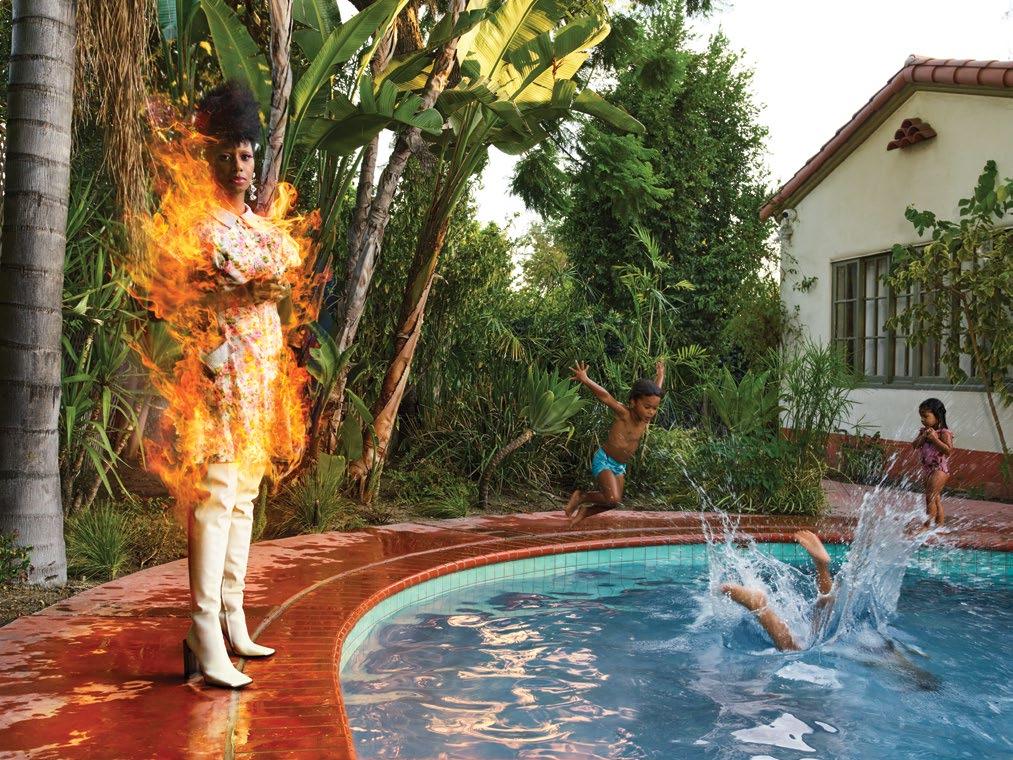
producers around the world. They were my community during that time.
WHAT ARE SOME OF THE EMOTIONAL THEMES THAT RUN THROUGH YOUR SONGS?
“Disparate Youth” is about having a vision for the future you want to create, having confidence in your voice, your power. That’s a constant theme in my songs, believing in your own power, your own voice. I like dark and grimy music, as well. Music is where I get to work things out, and sometimes you’re working that out for everyone.
YEAH, SO MUCH OF YOUR MUSIC IS CHILL AND VIBE-Y, BUT HAS THESE INTENSE CURRENTS RIGHT UNDER THE SURFACE.
Something special about art is you get to make things that are aesthetically
pleasing or feel-good but then you get to sneak in hard things to process. You can make that palatable and easier for the audience to receive. That’s important right now. Our country is so divided, and it’s hard for people to be open to other viewpoints. When you can get people to take medicine with sugar, you actually win. When we can unify around something, particularly about beauty and evolution, and agree that it feels good together, that’s really valuable.
WHAT ARE YOUR REFLECTIONS ON GFS’ EFFECT ON YOUR FOUNDATION AS AN ARTIST?
I went to GFS for tenth through twelfth grades. That time was so formative for me as an artist and as a free thinker. My favorite thing about GFS was my senior studio painting class. I’d go
up into the art room for hours, and build these huge canvases. We did self portraits that year. I painted myself as an animal, as a pharaoh…it was all about breaking yourself down and seeing yourself differently. That was Denny Heck’s class—she made a big impression on me.
I also loved sports, I was super athletic. When I was a senior, we had an undefeated season in field hockey, and it was the best teamwork I’ve ever experienced in my life. I still reference that sometimes when I’m talking about teamwork. You can go your hardest when you know there are people right behind you, supporting you. —Emily Kovach
GERMANTOWN FRIENDS SCHOOL
31 West Coulter Street Philadelphia, PA 19144
215.951.2300
www.germantownfriends.org
PHILADELPHIA, PA
PERMIT NO. 2572
A NEW BEAT
This past January, a group of Upper School students and faculty went to Costa Rica on a science and community-focused trip in partnership with Seeds of Change. In addition to working on some amazing science research projects, students also supported the donation of drums and percussion instruments from GFS to a small high school, Liceo Rural Valle Verde, in Aguas Claras. Upper School science teacher Bob Wein led the efforts to get the drums to the school, as having the drums will allow the students to participate in local and regional parades. Over five workshop sessions, Brian Bersh, head of GFS’ Music department (pictured below, center), taught the students basic techniques, like how to hold sticks and how to mimic spoken chants with drum beats.
“Teaching these students to make music was a joyous thing to be a part of, but it was so much more than that,” Bersh reflected. “From the moment we unboxed the drums, you could see their sense of pride. The drum sticks went into their pockets and it was like: ‘Now I’m a drummer.’”
